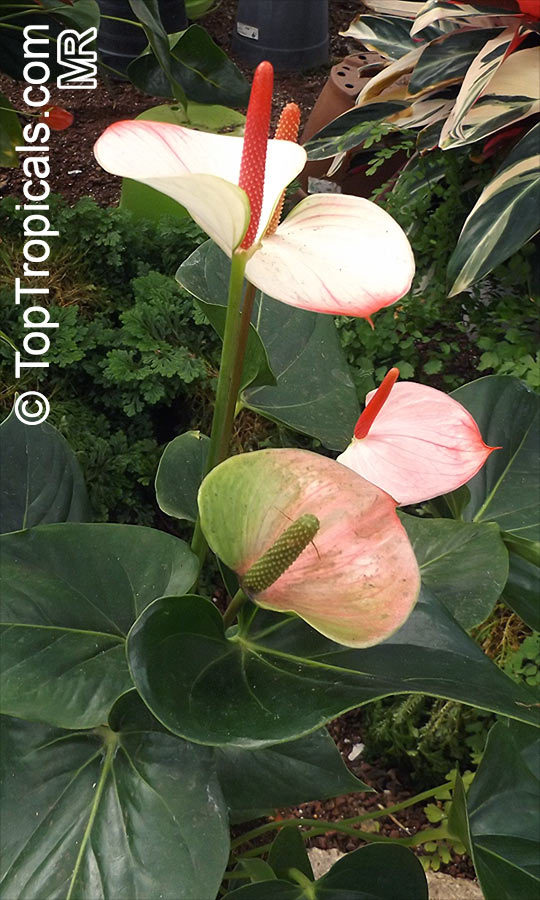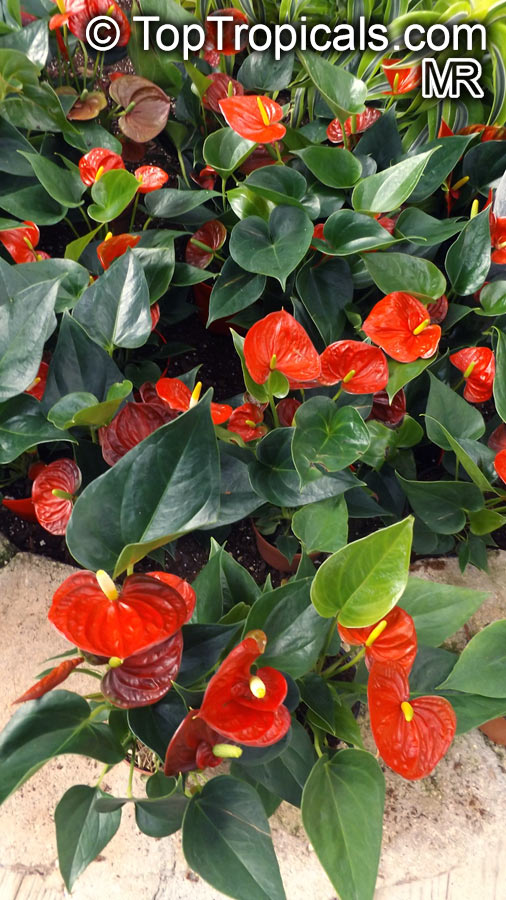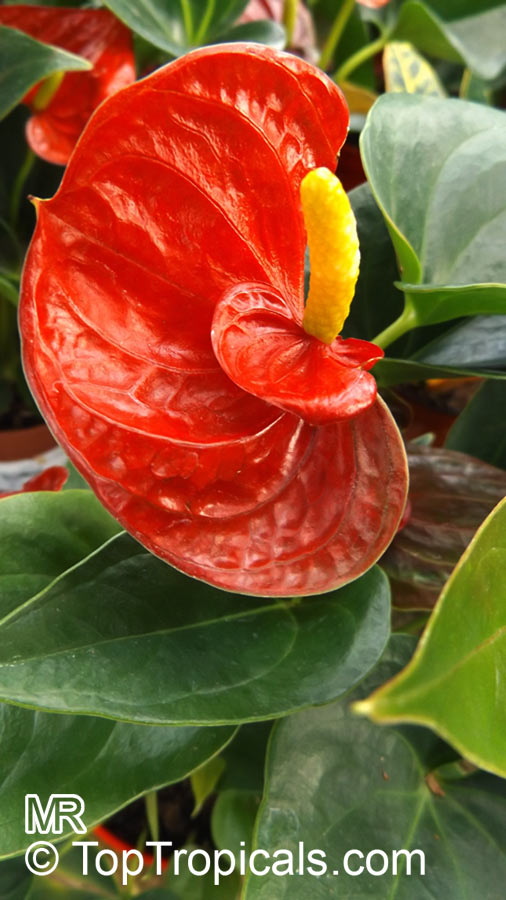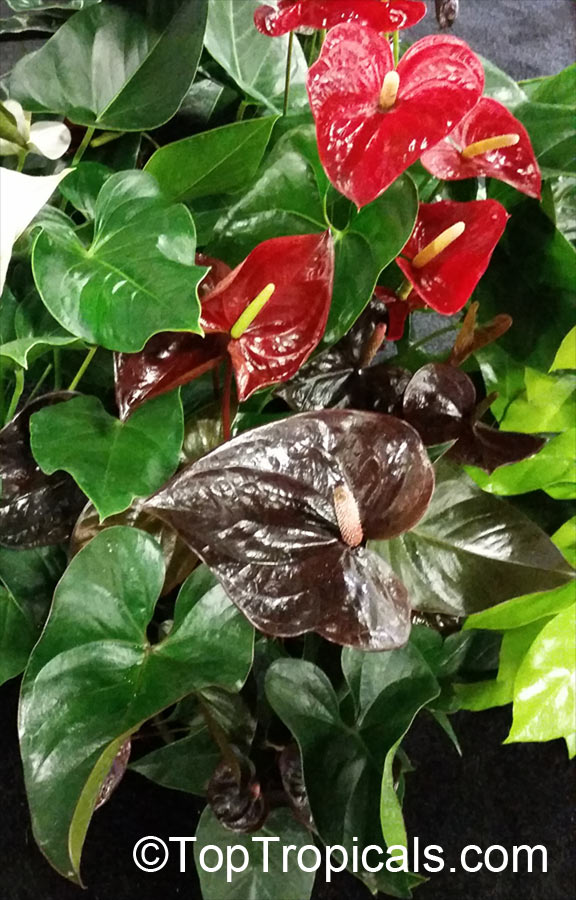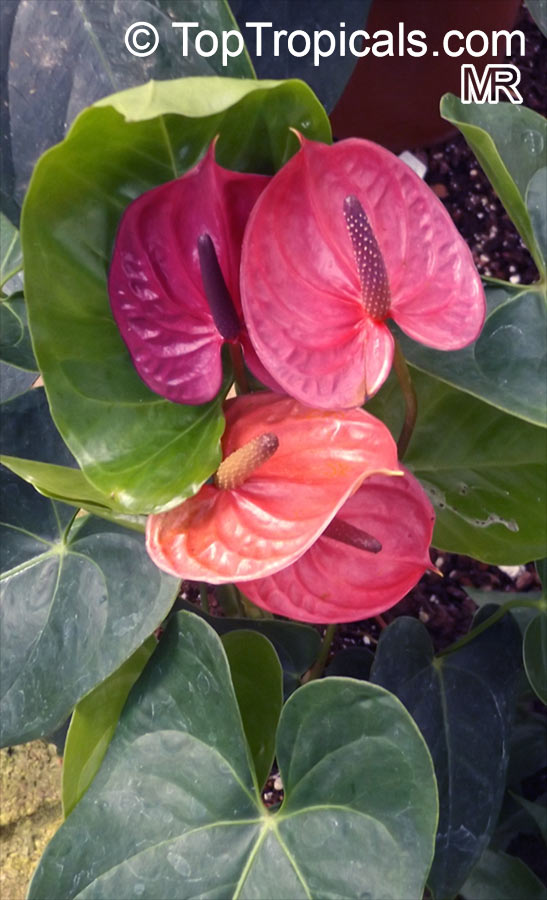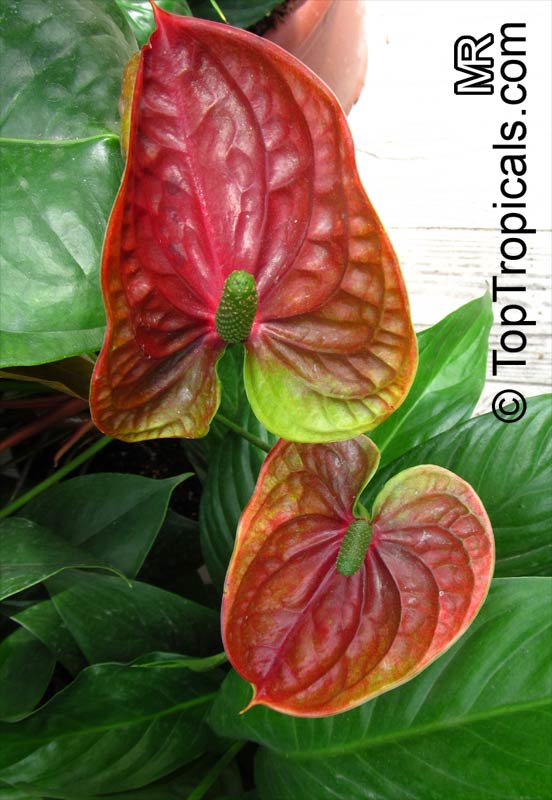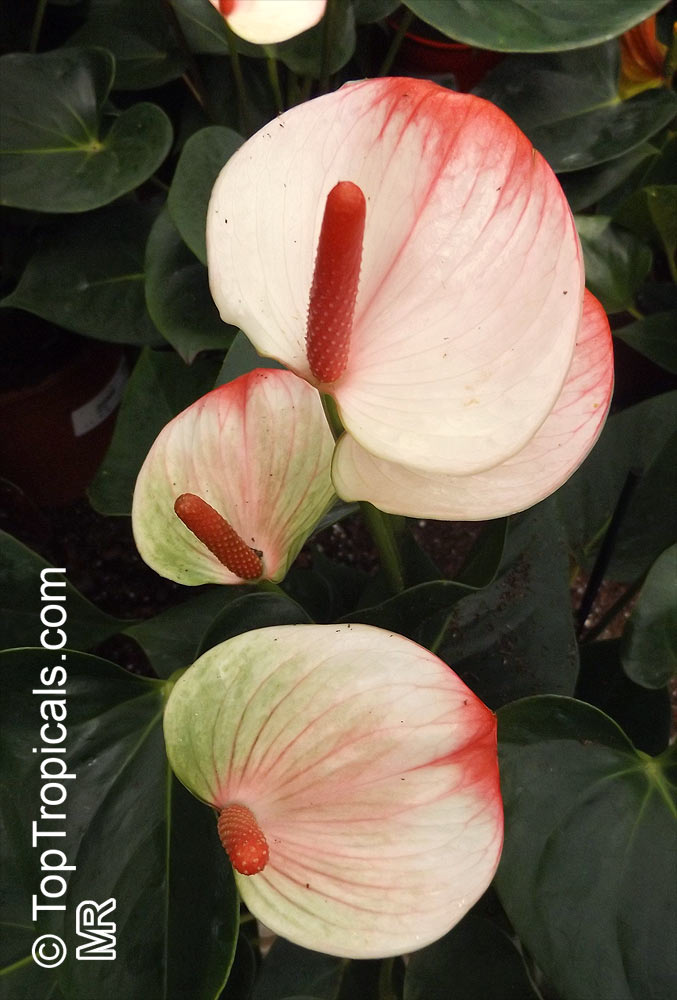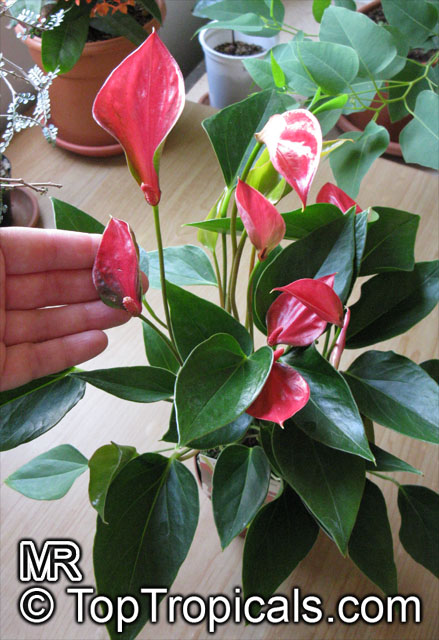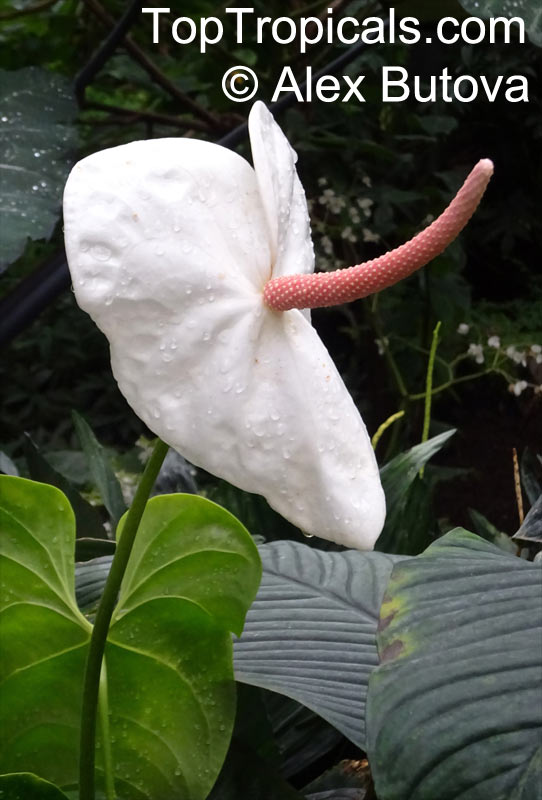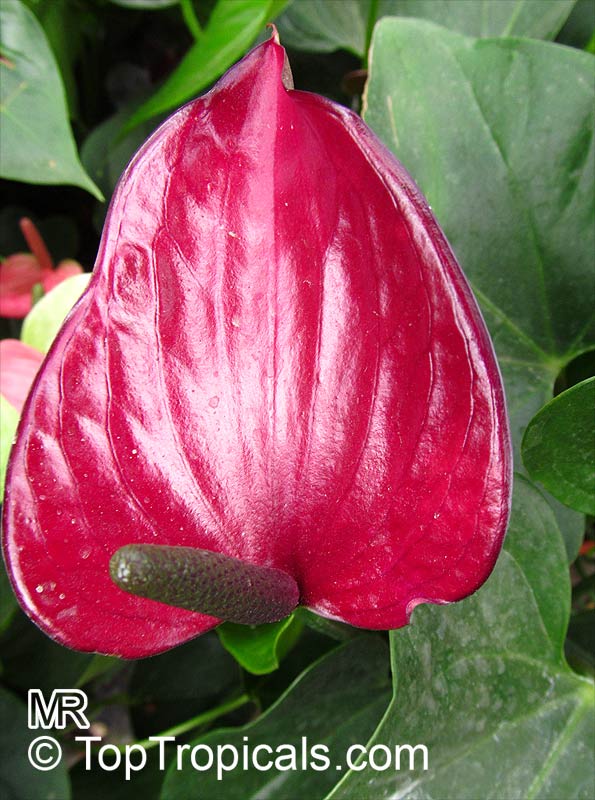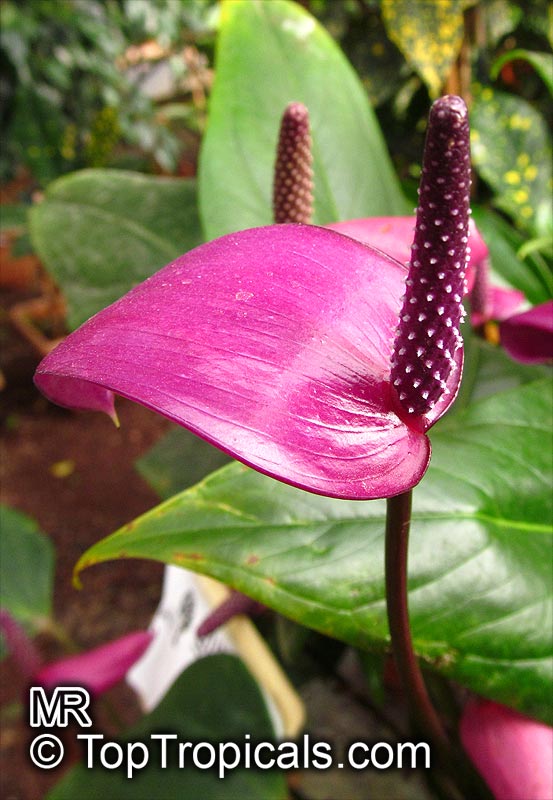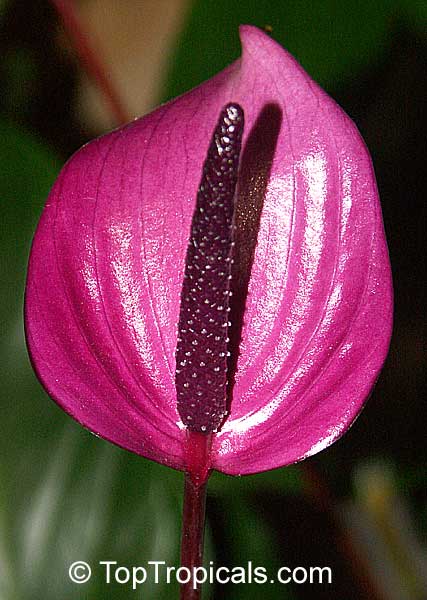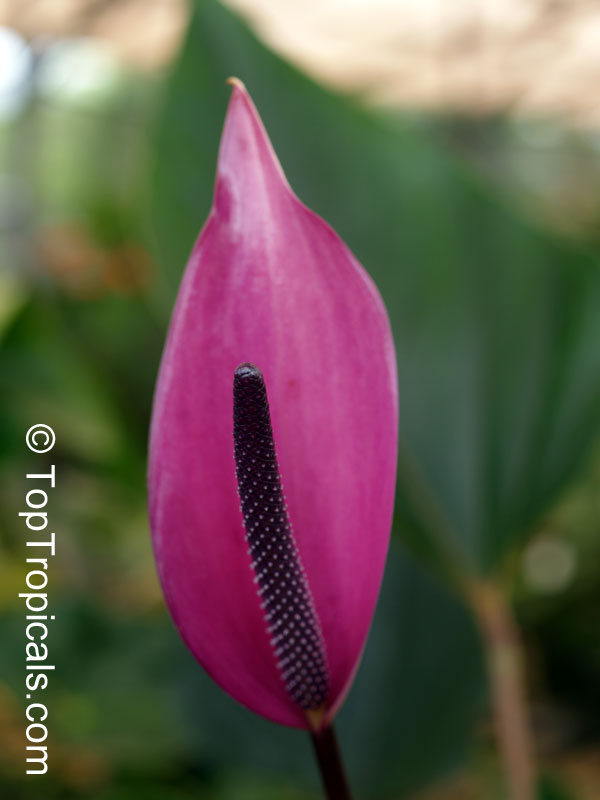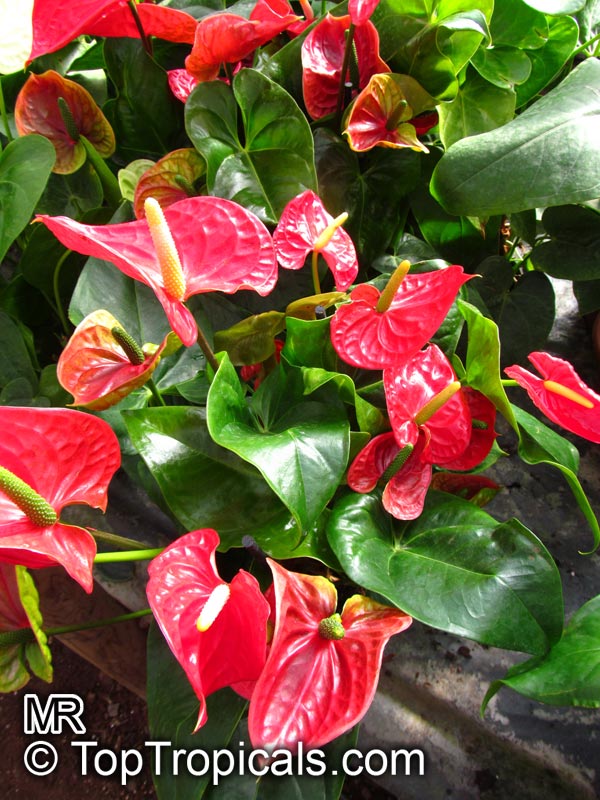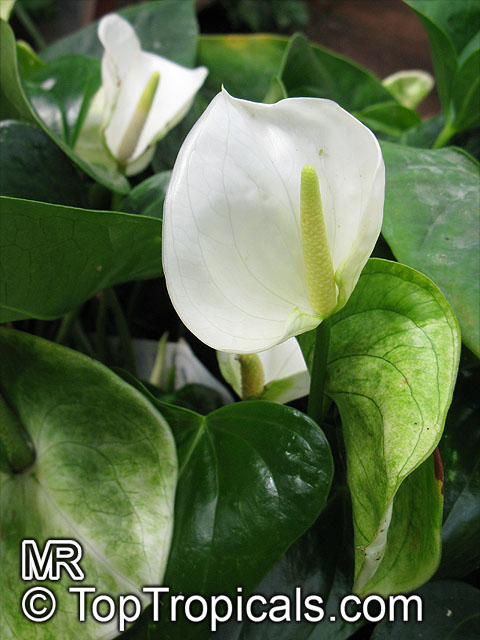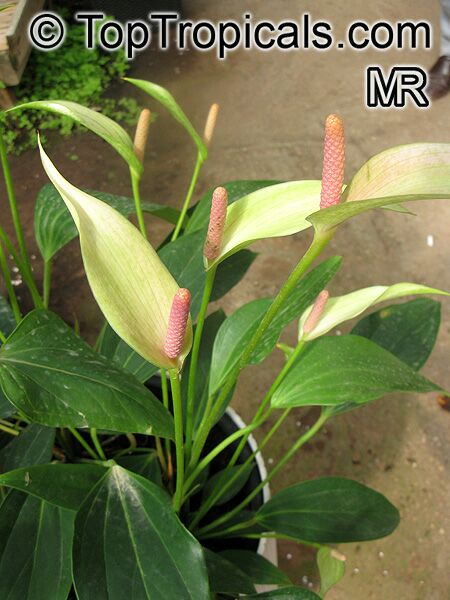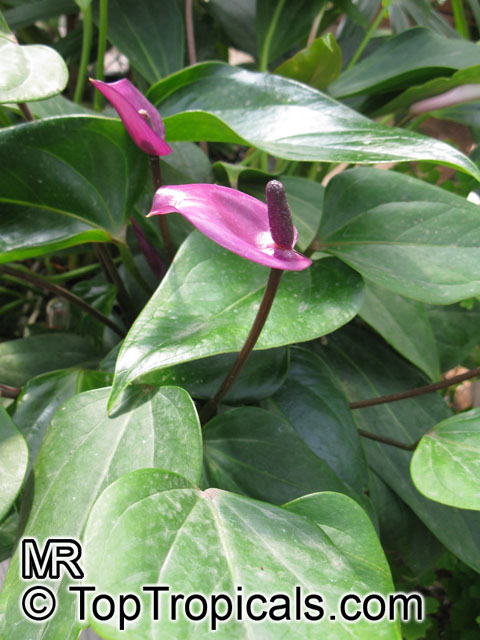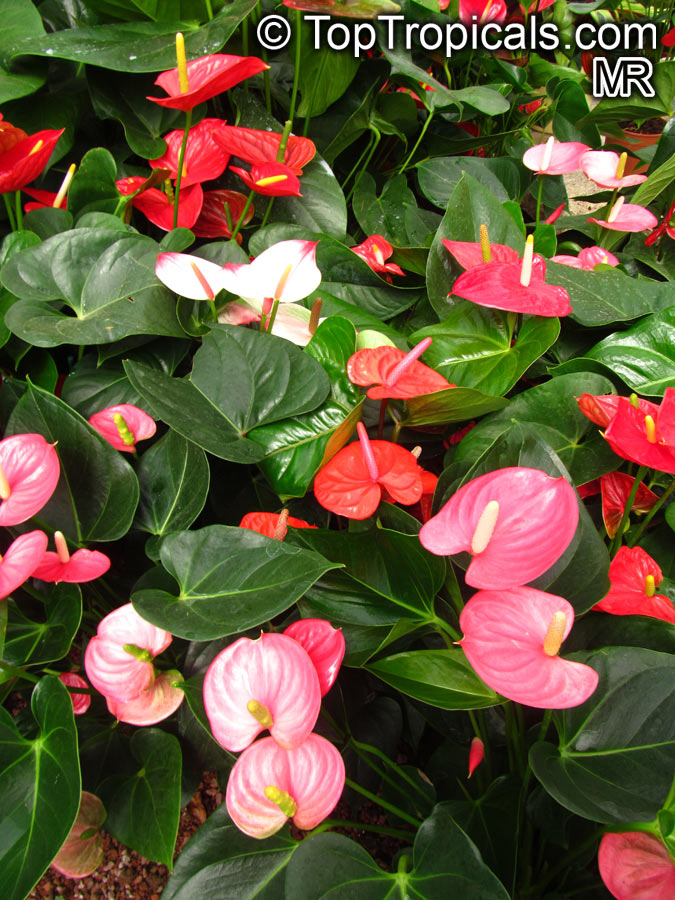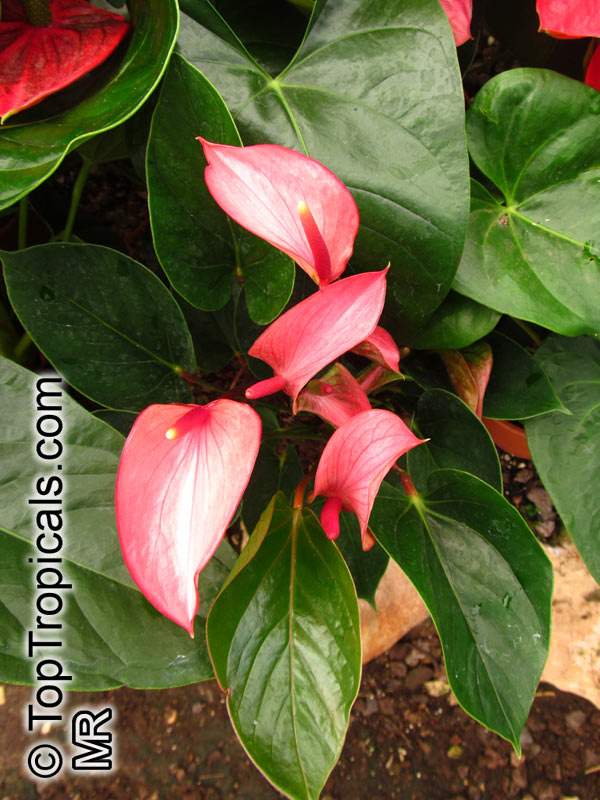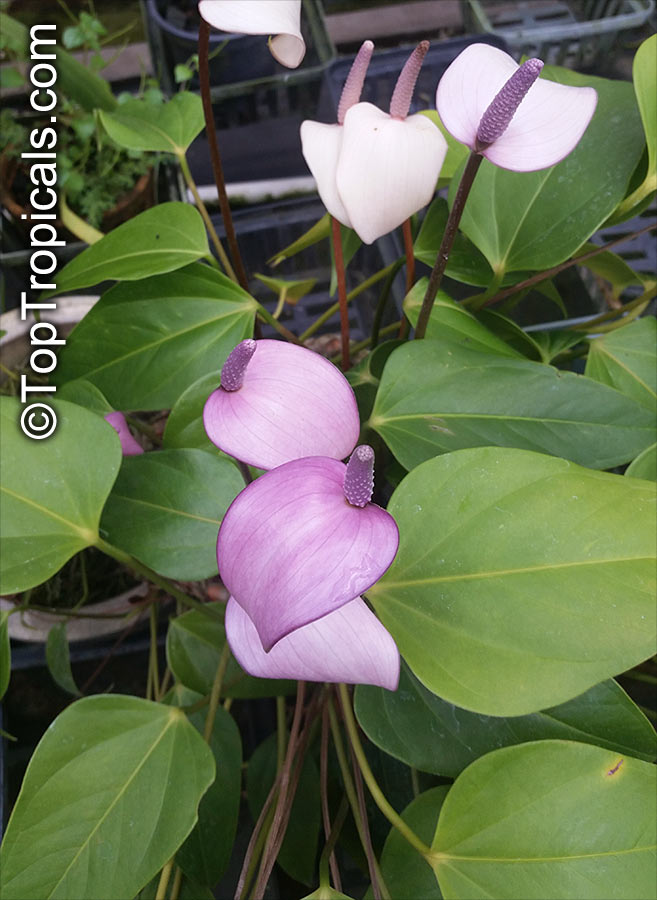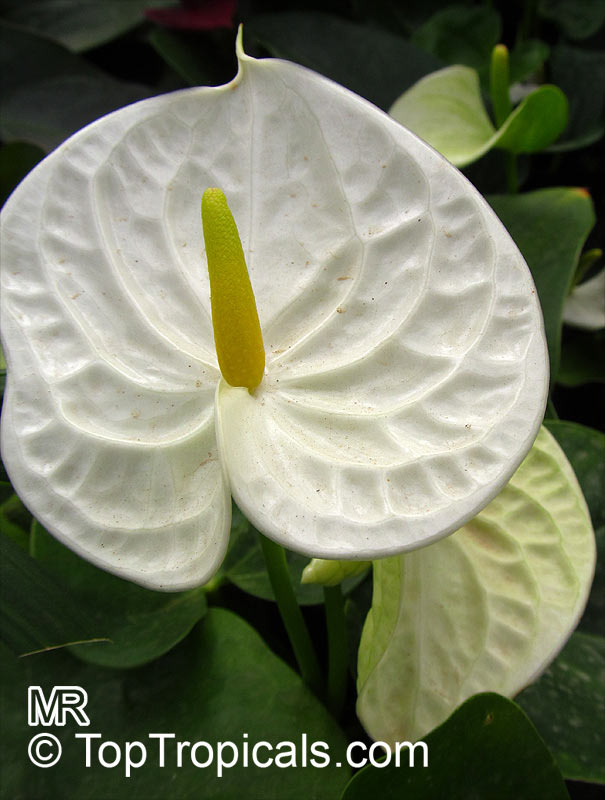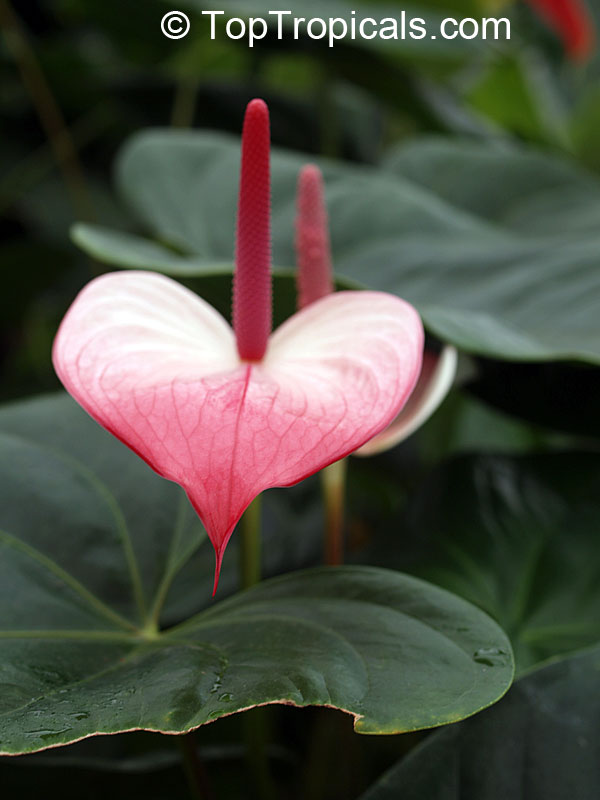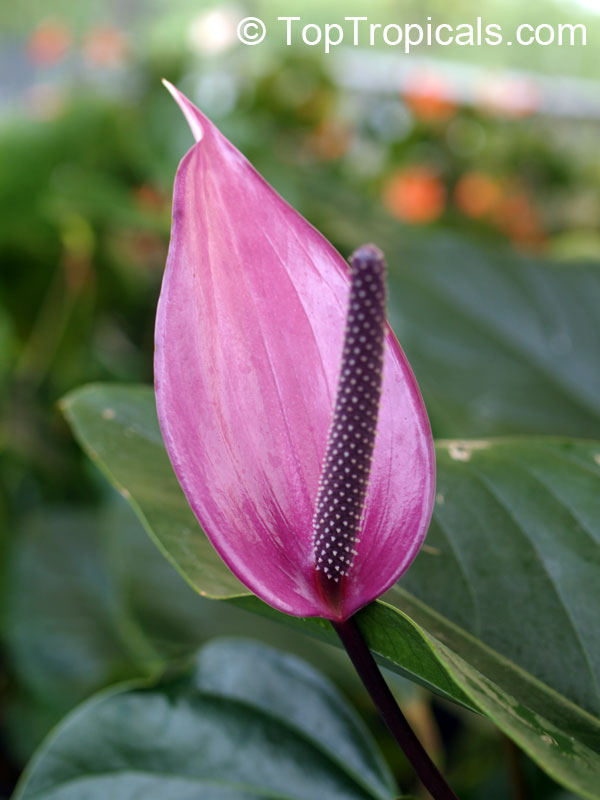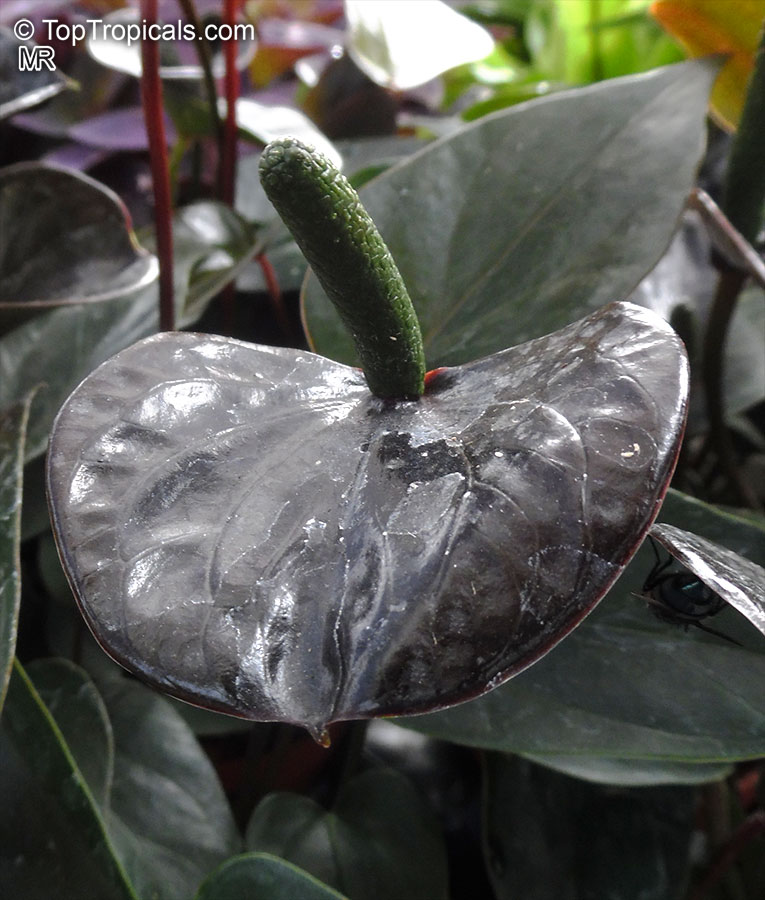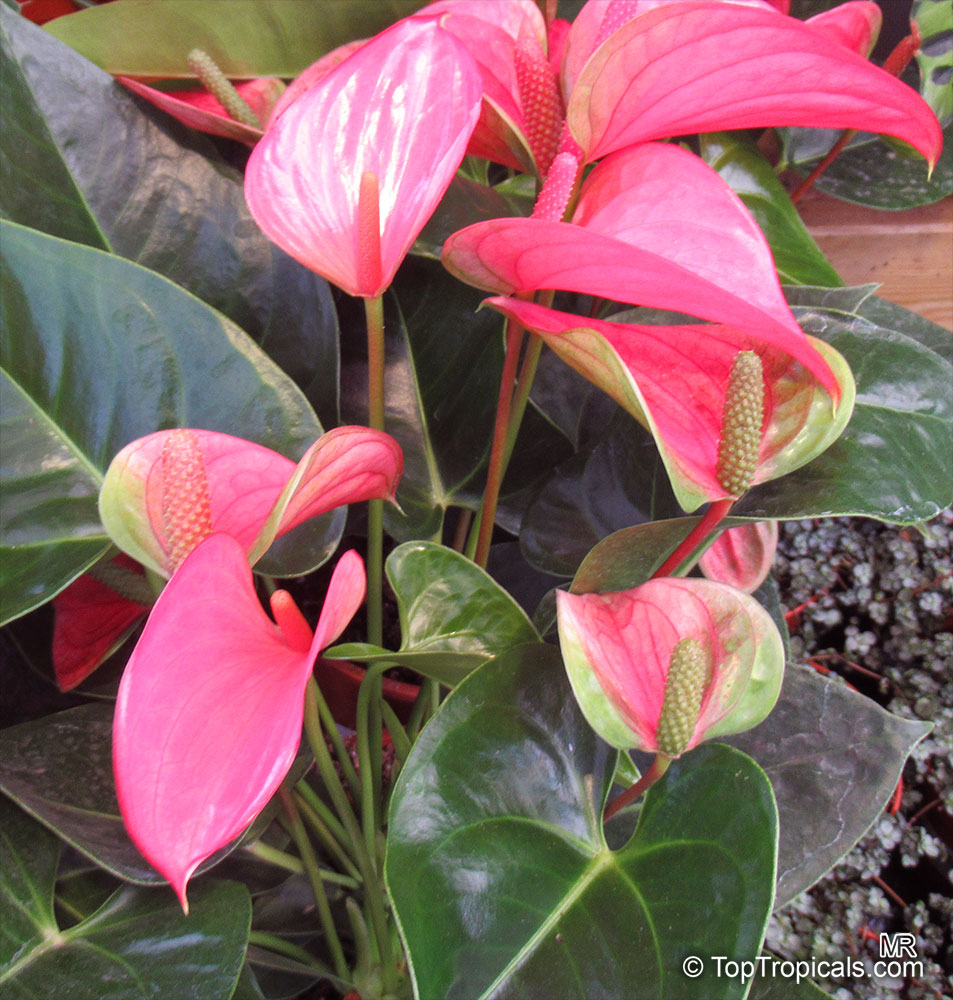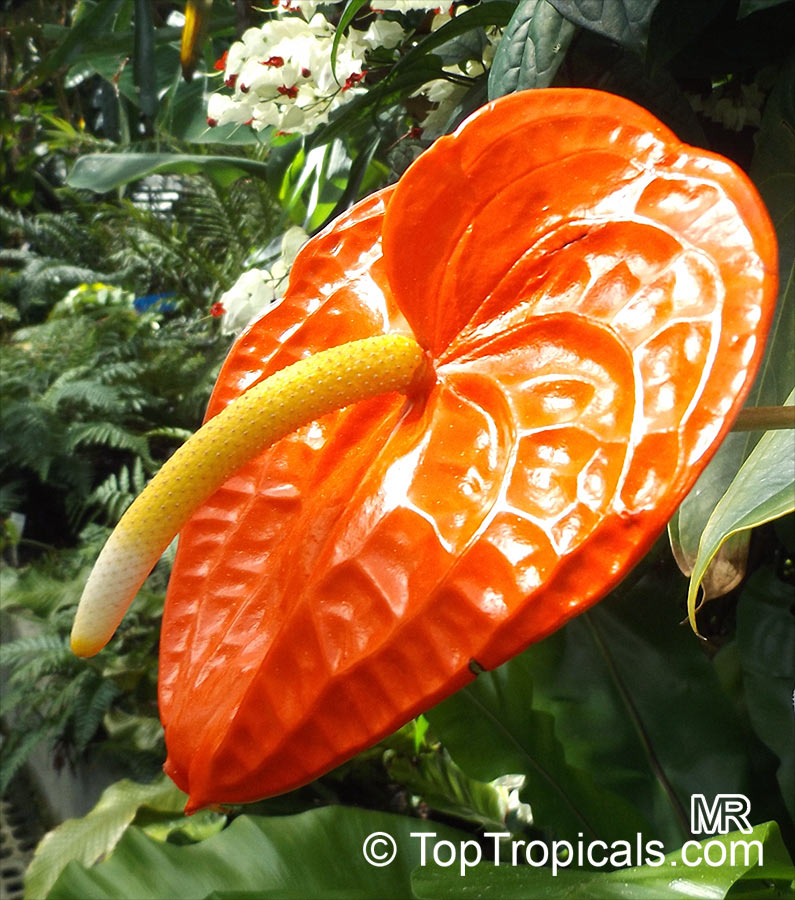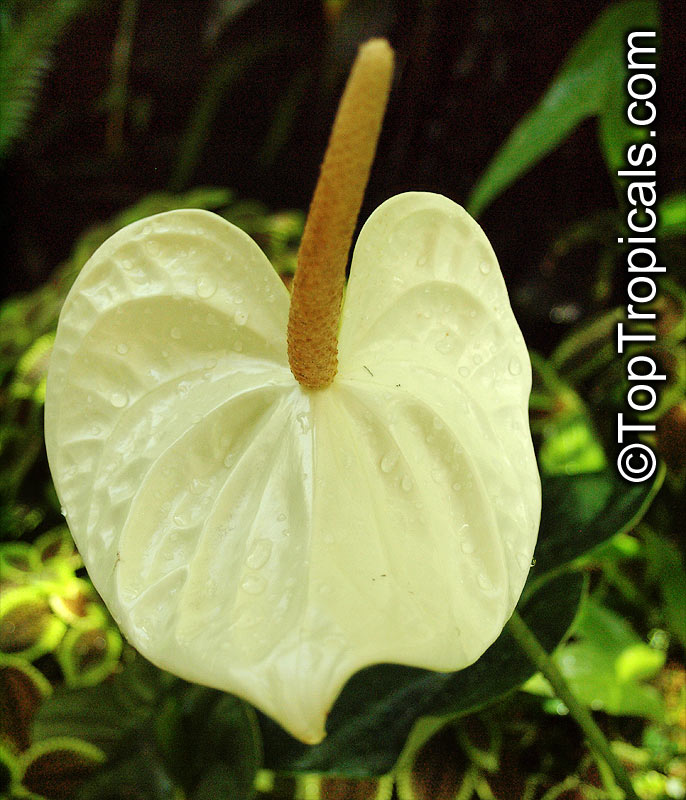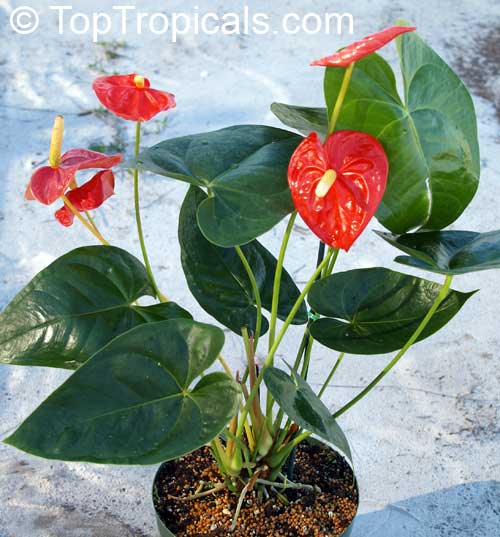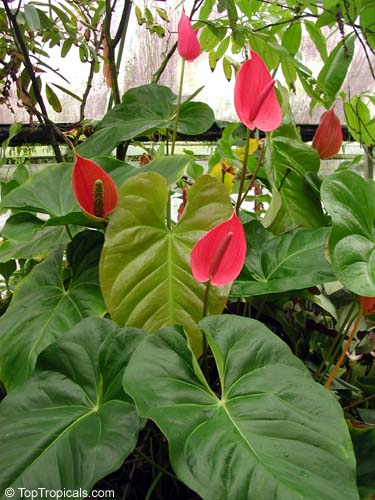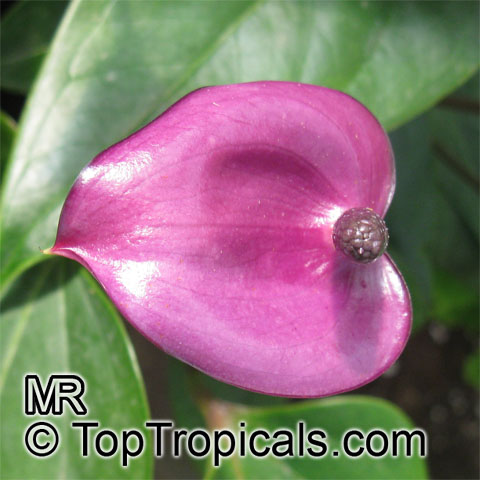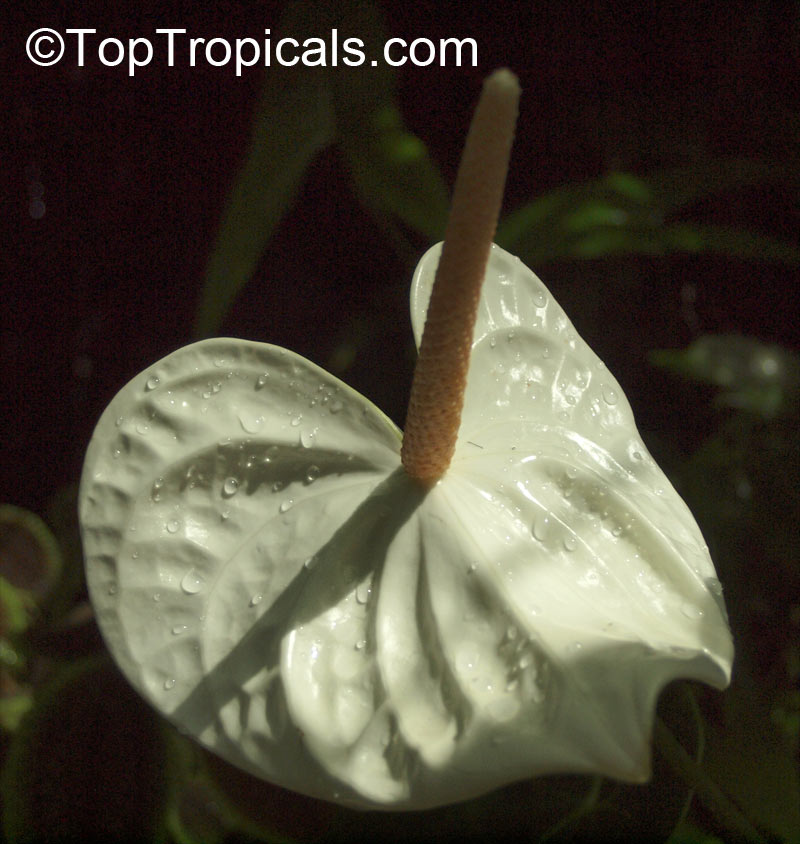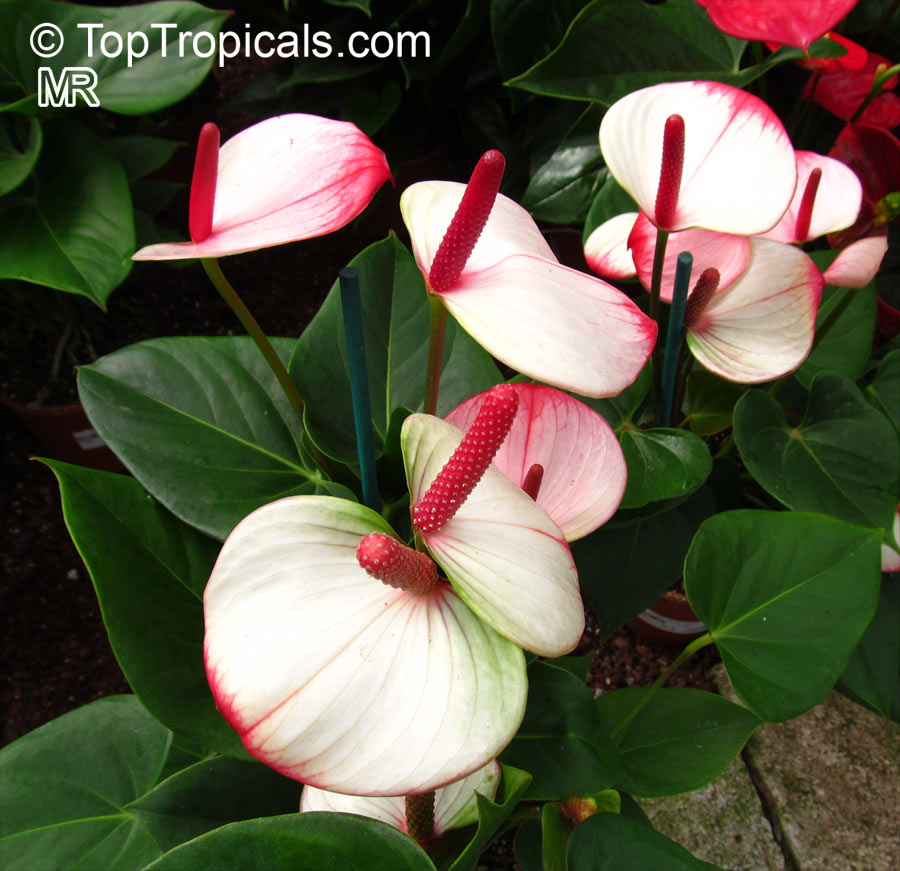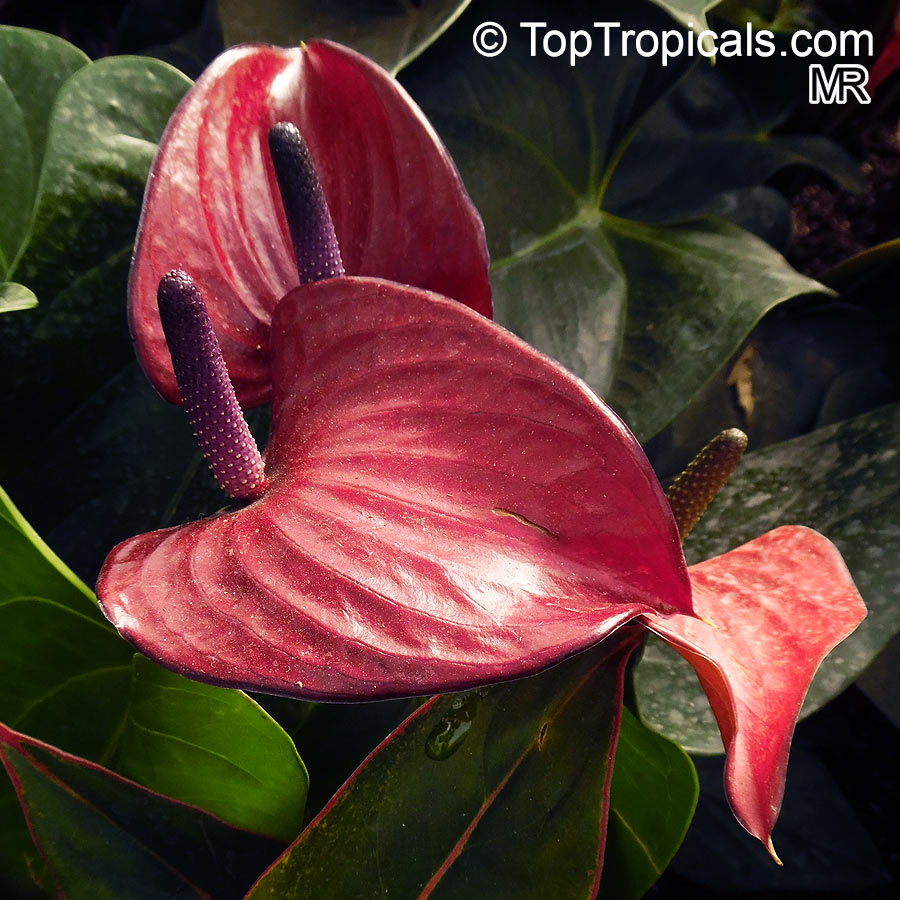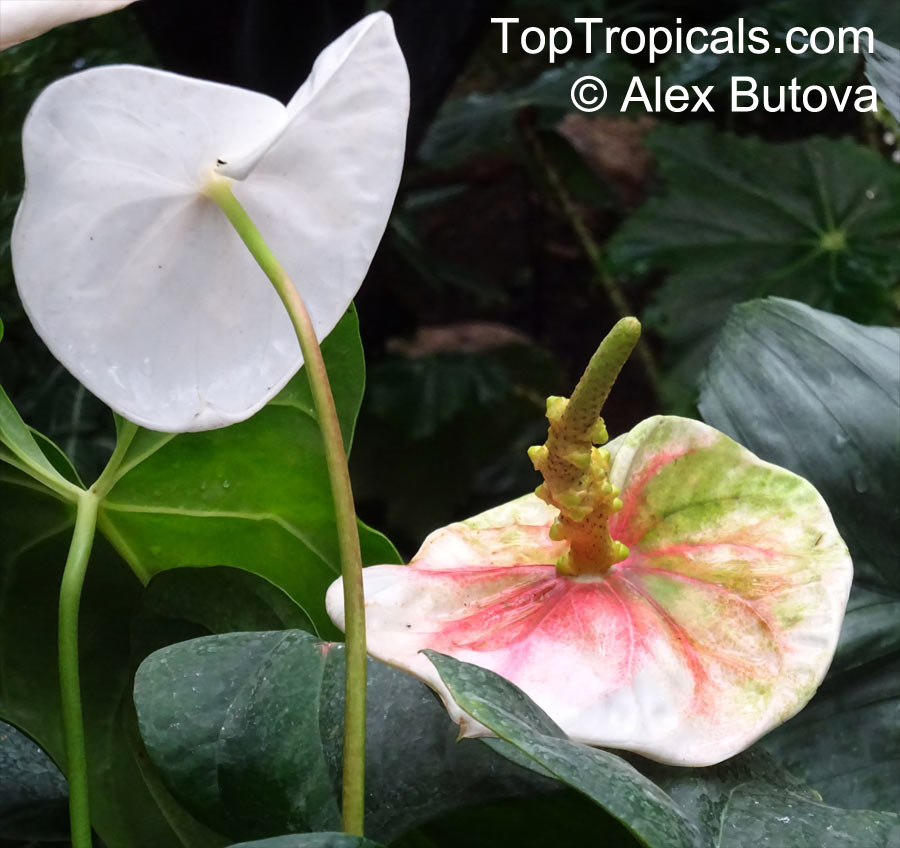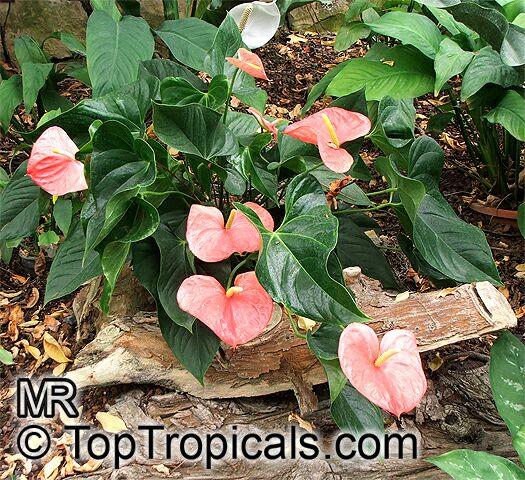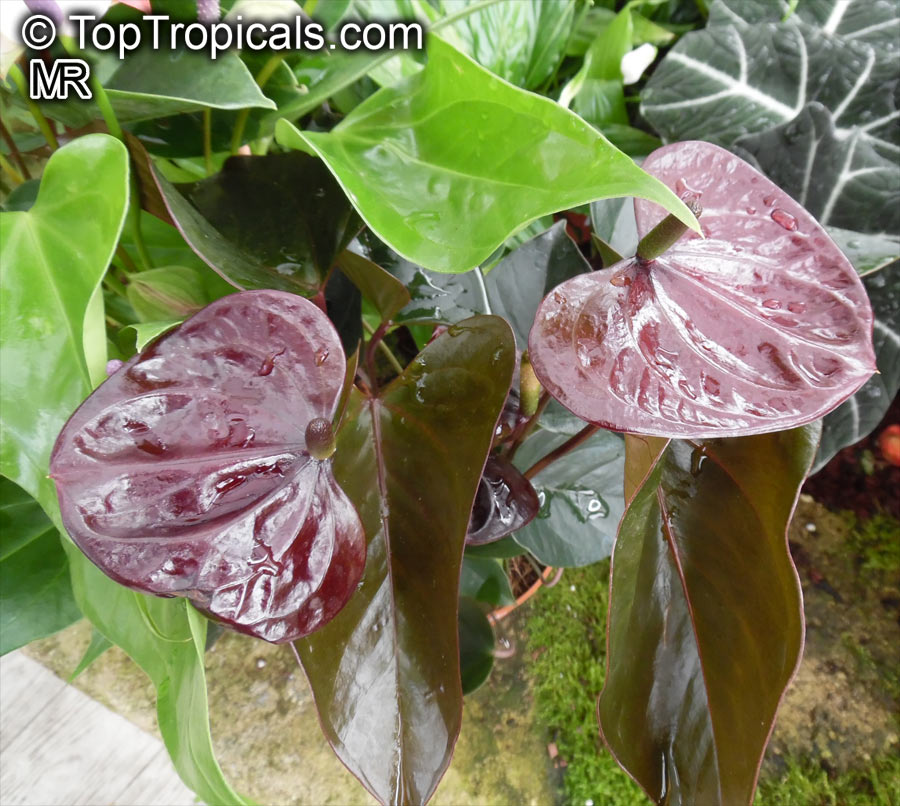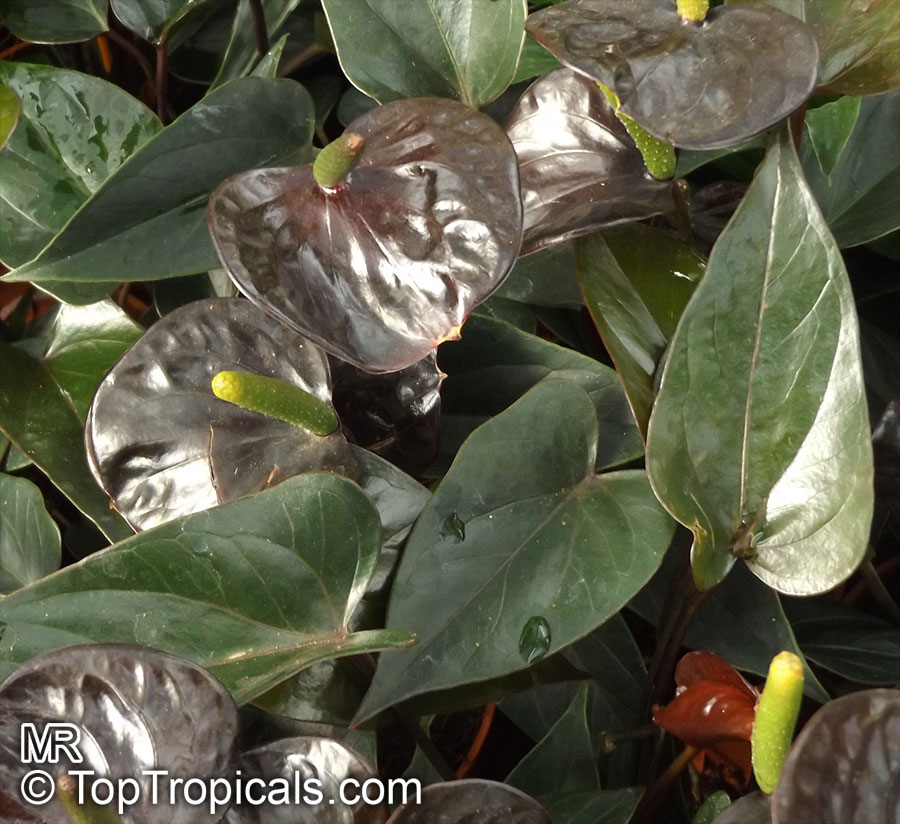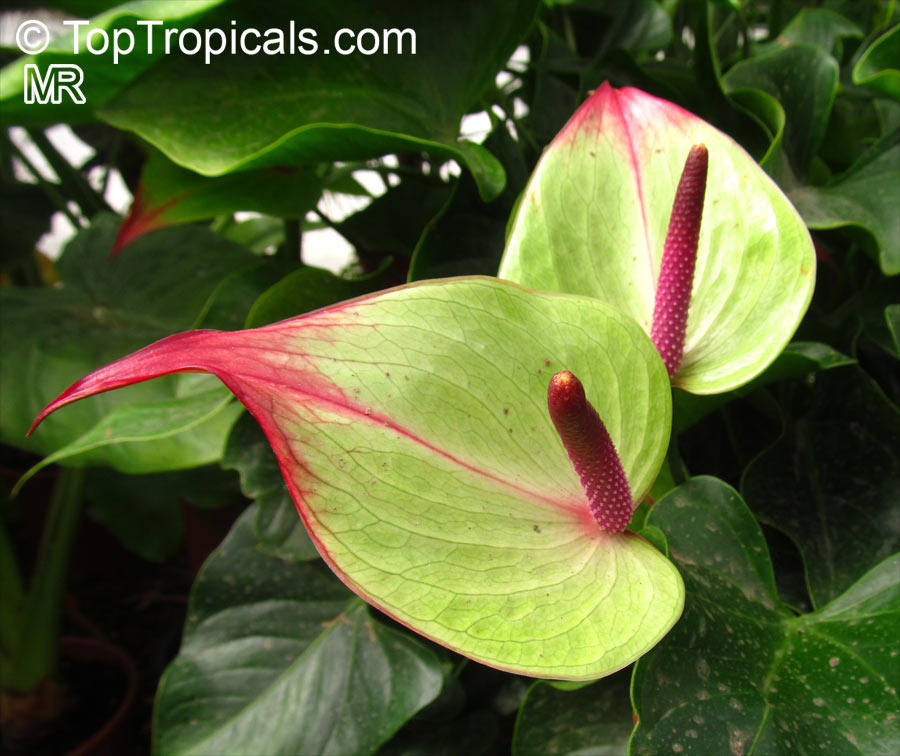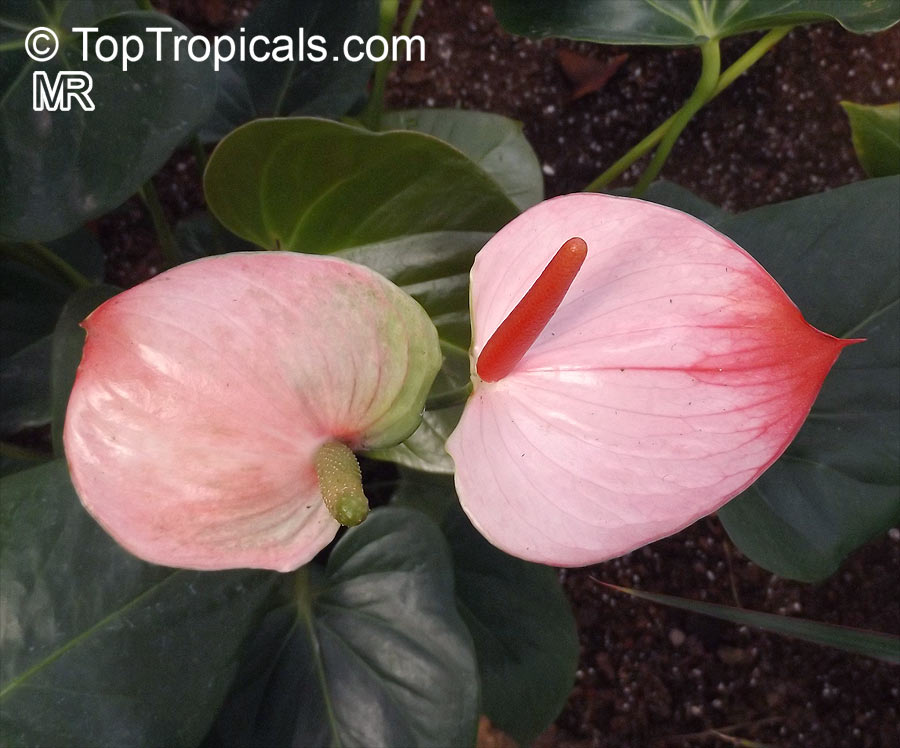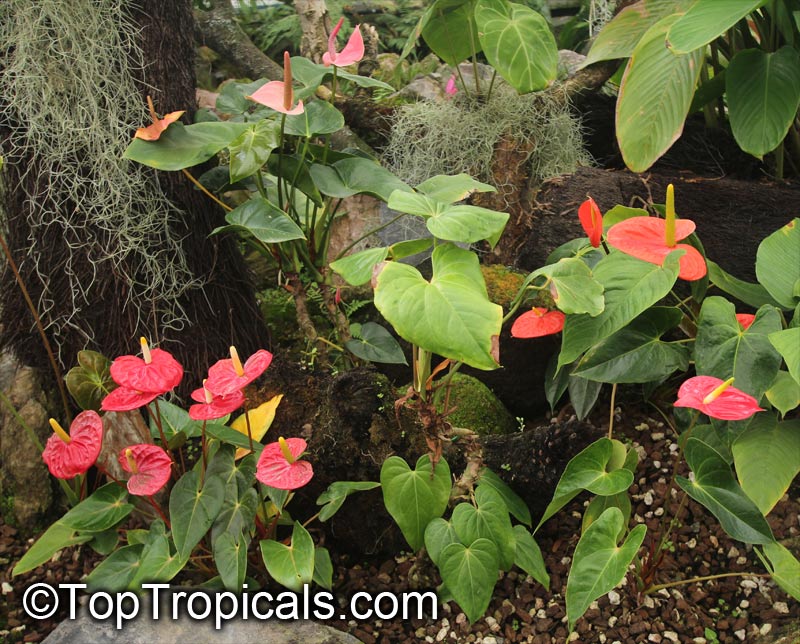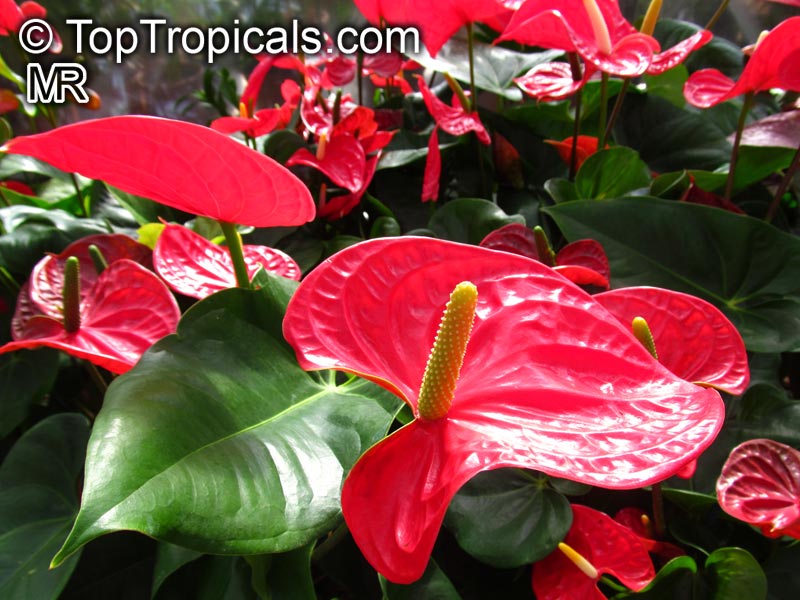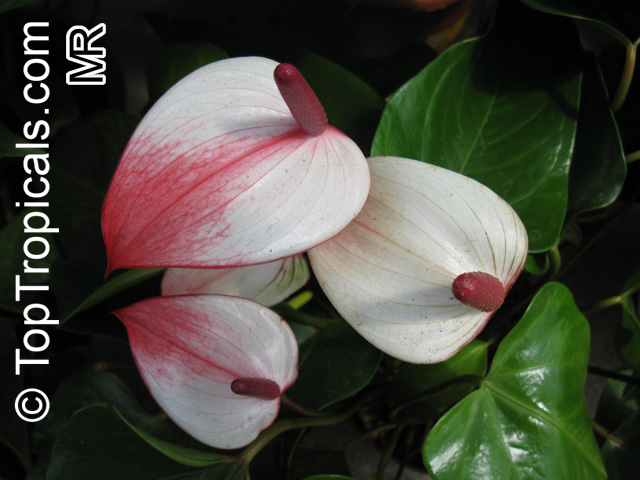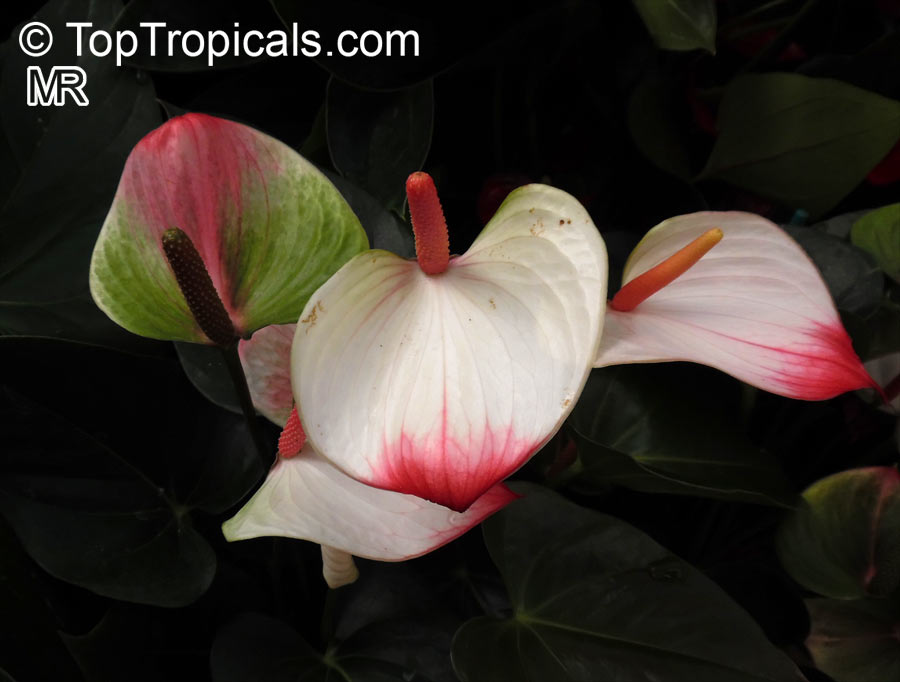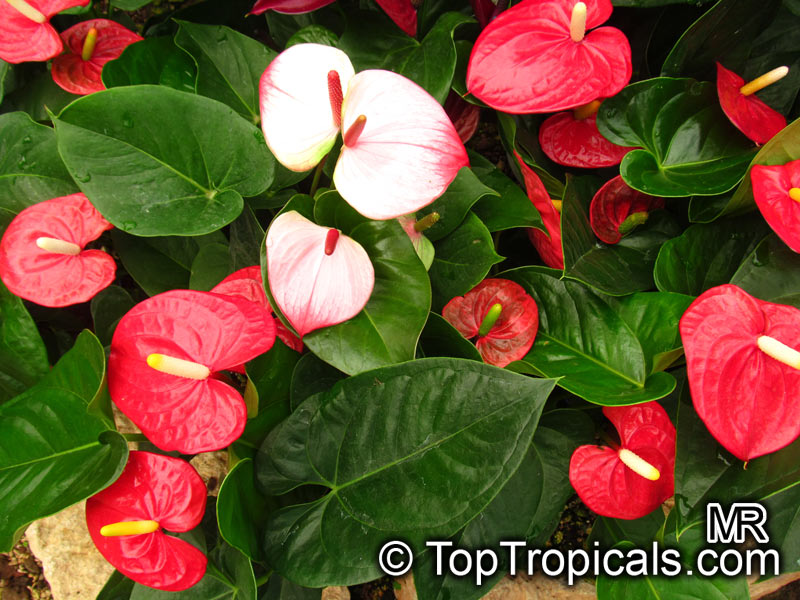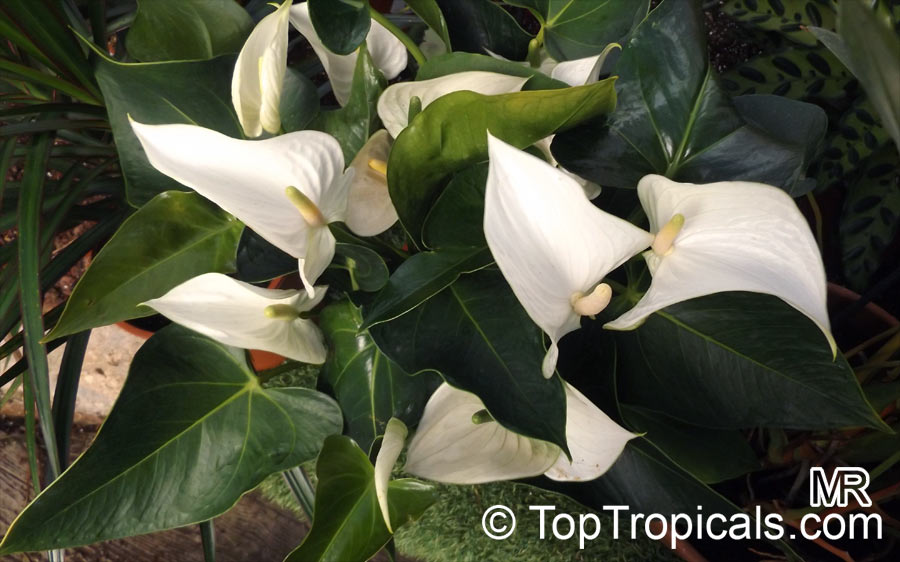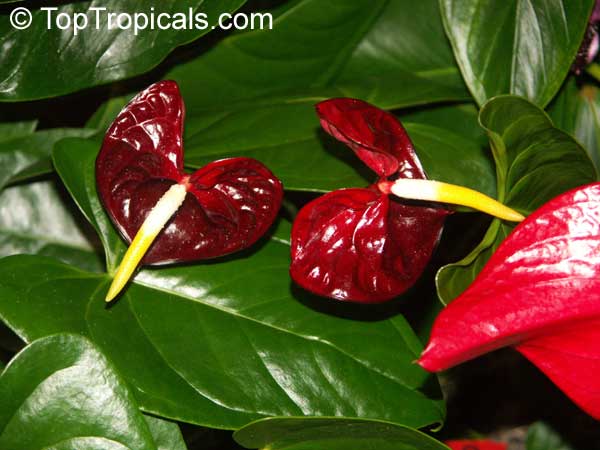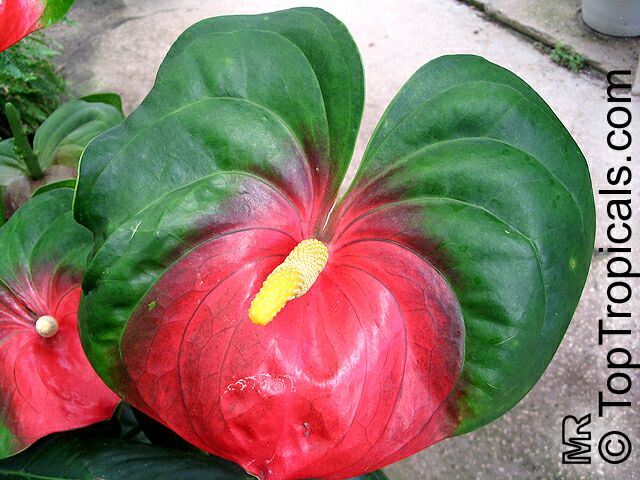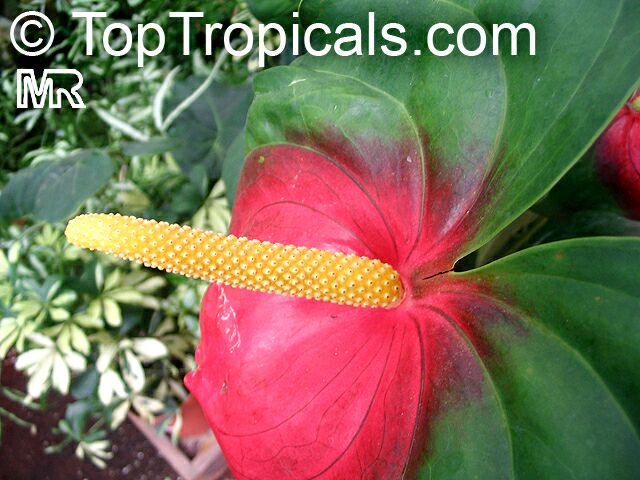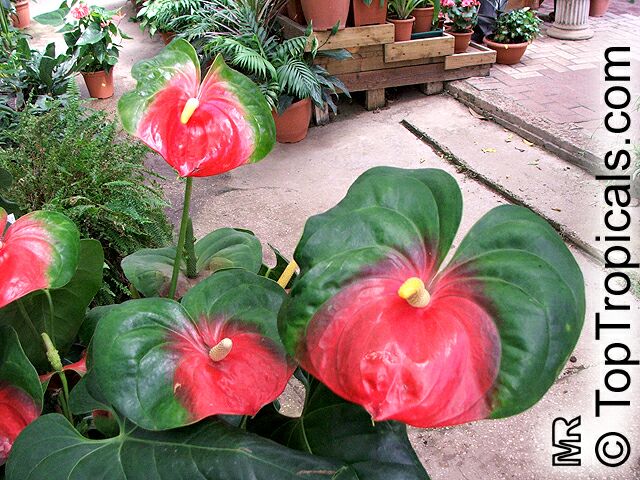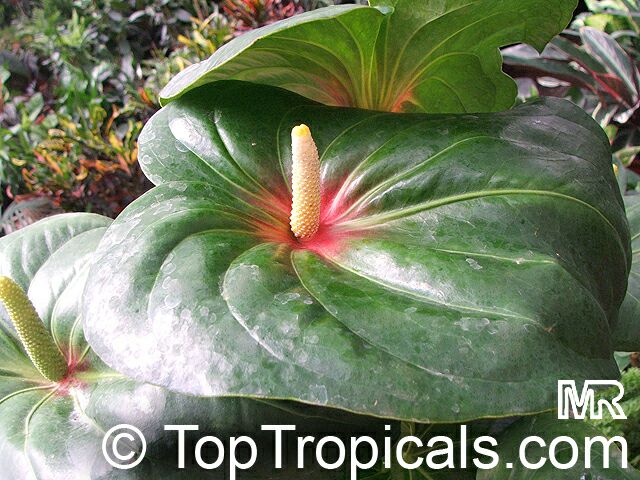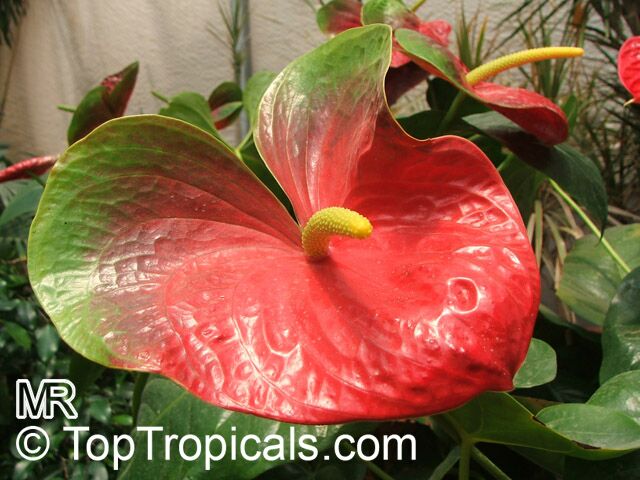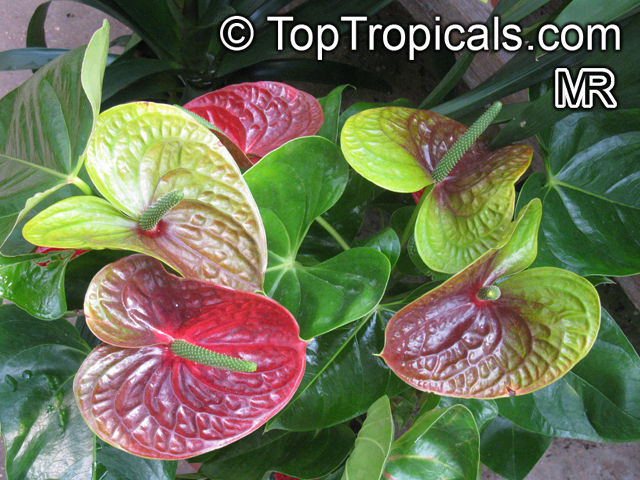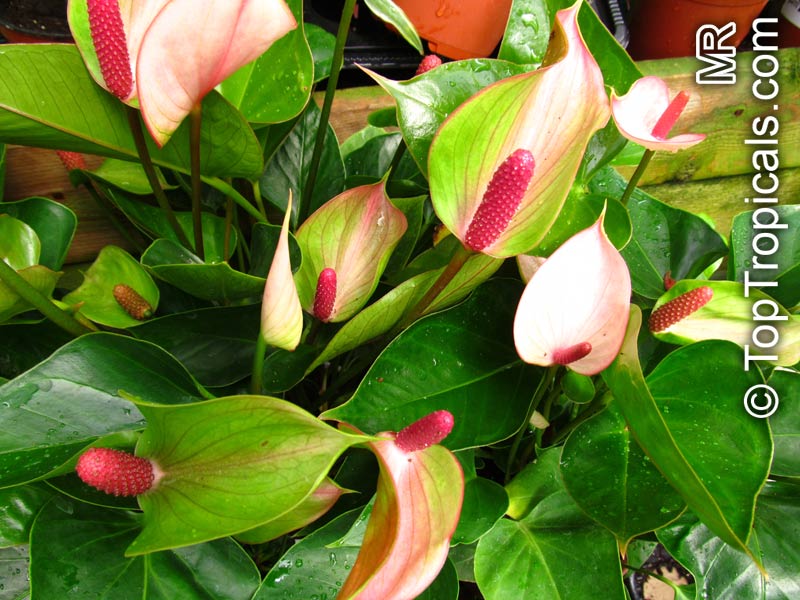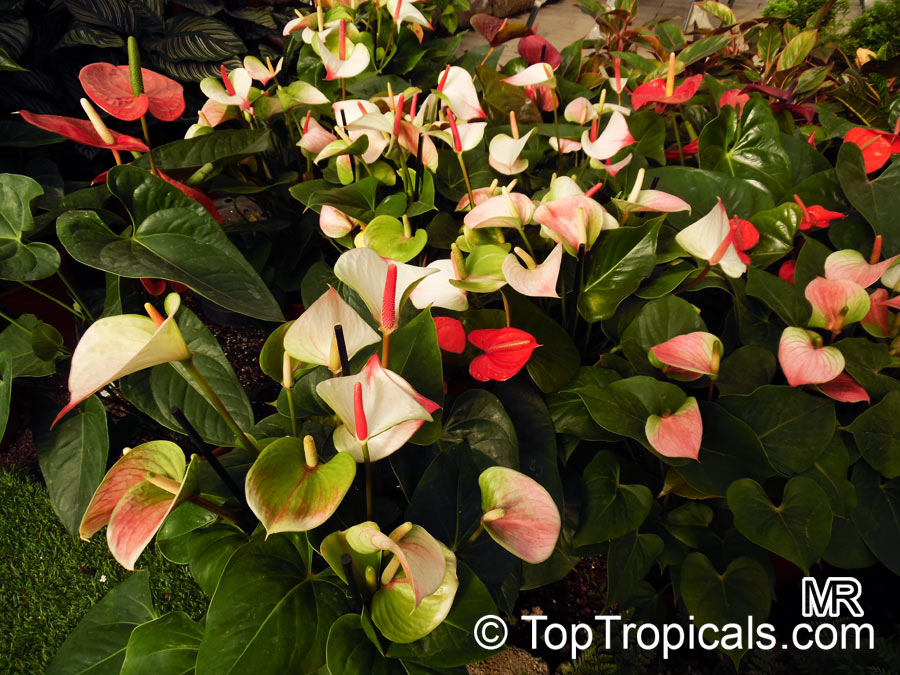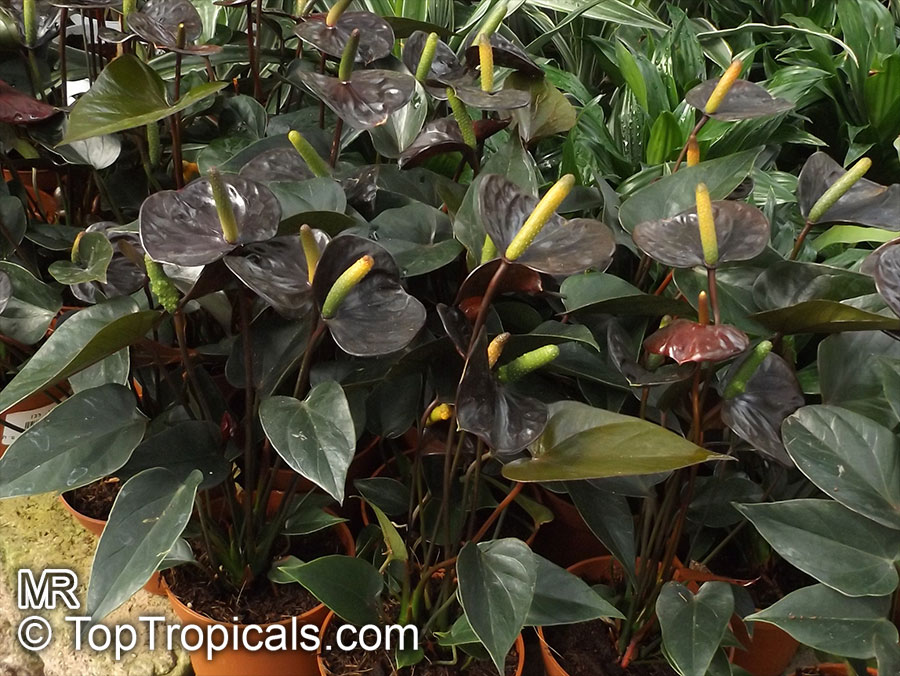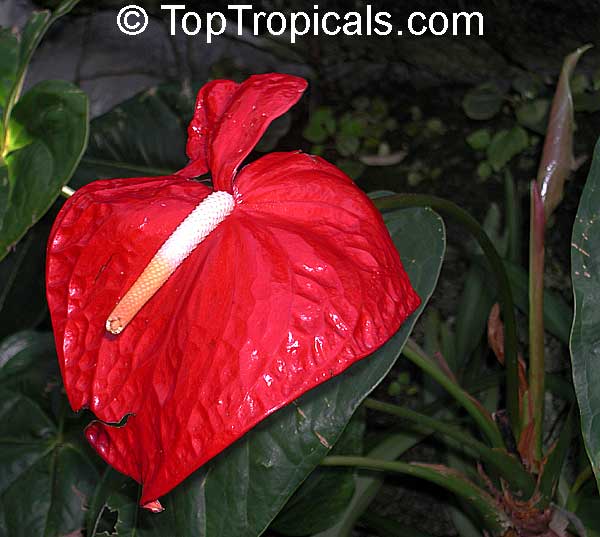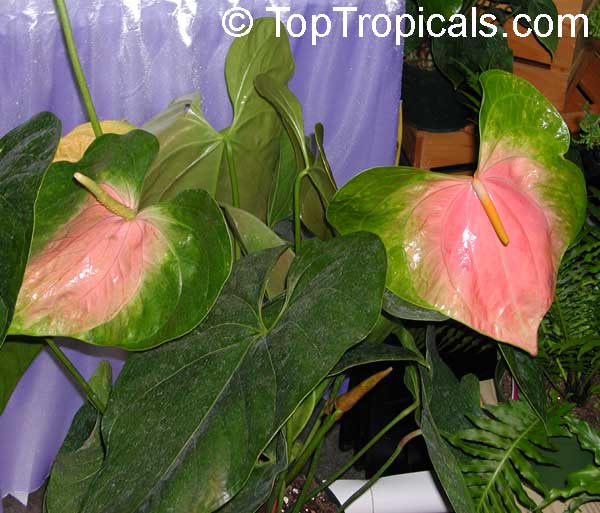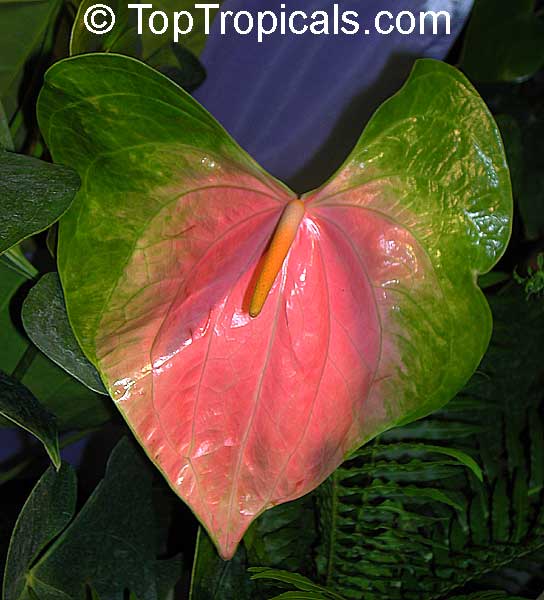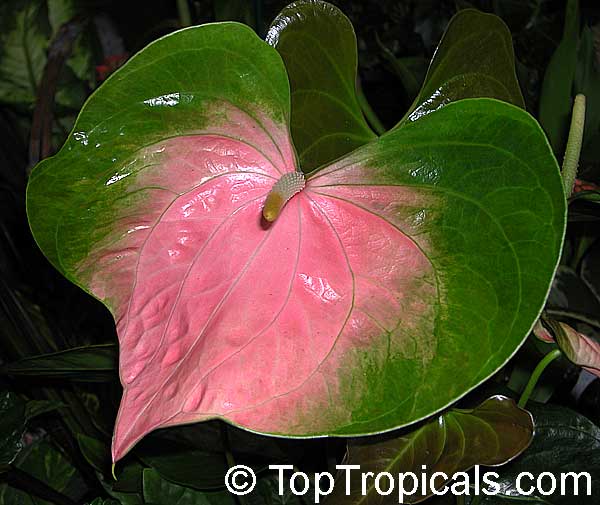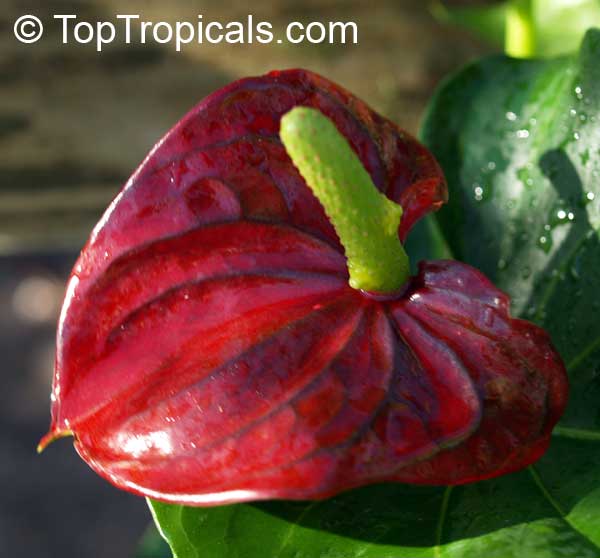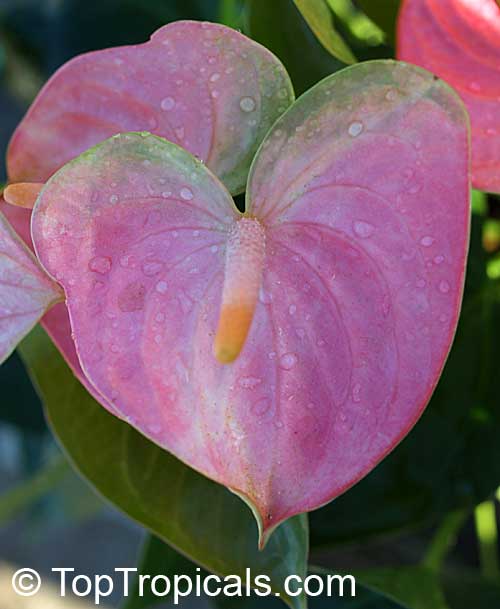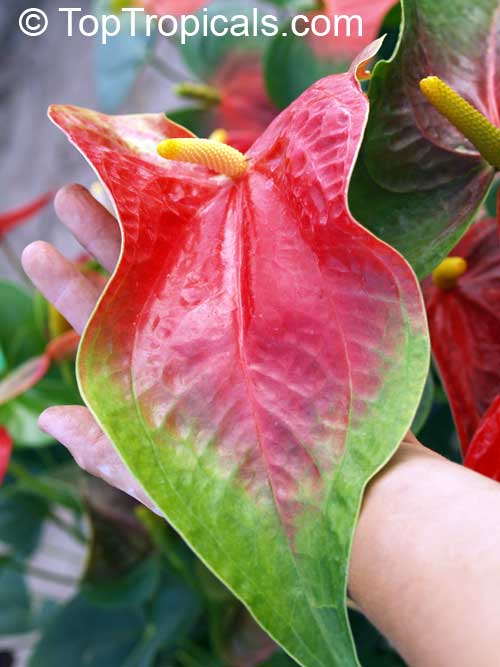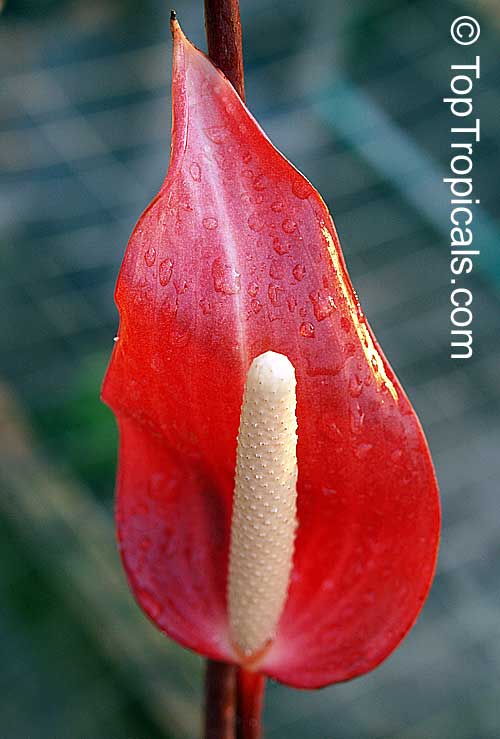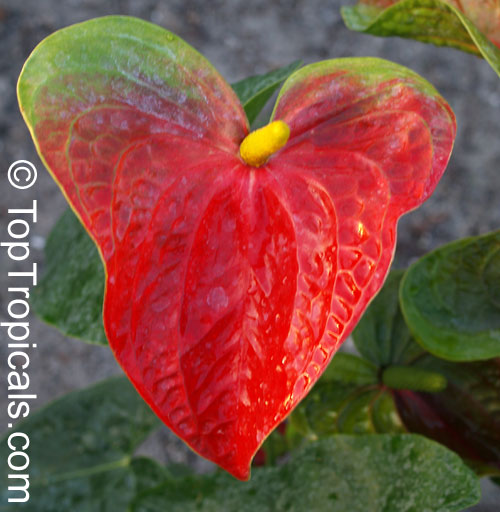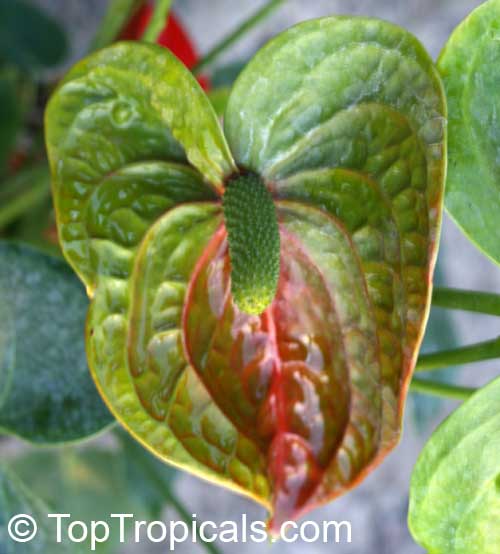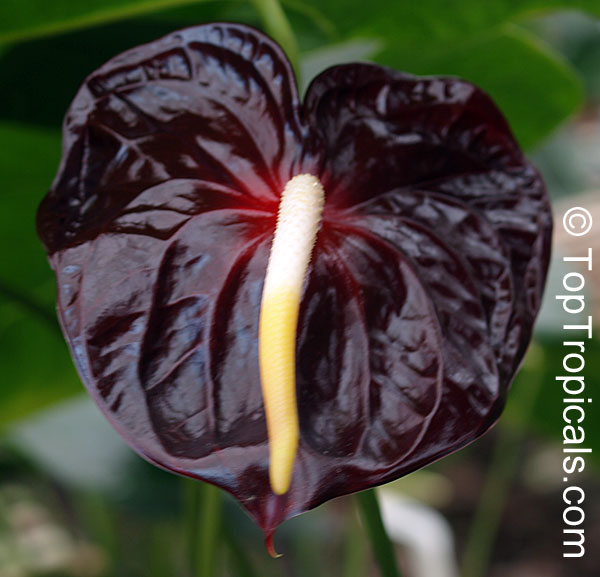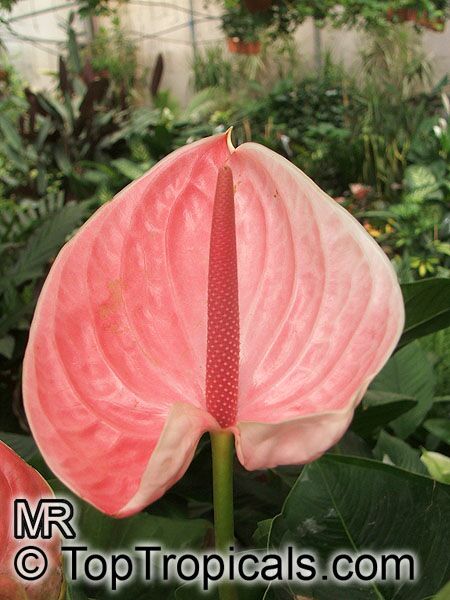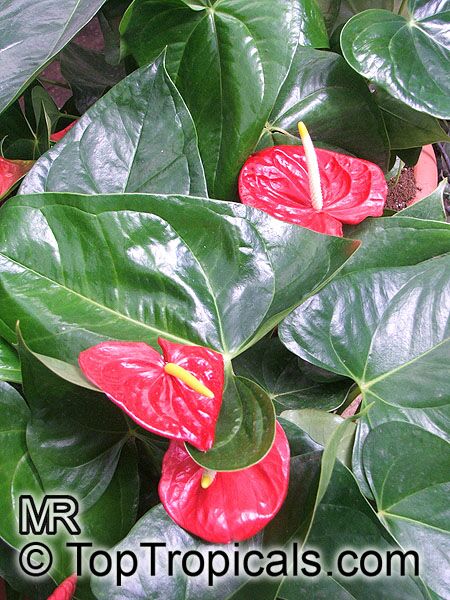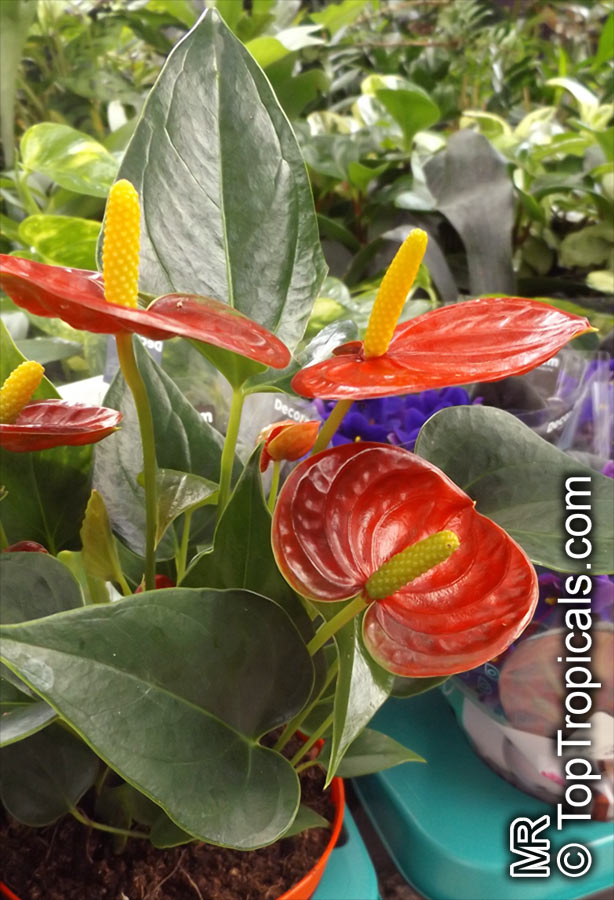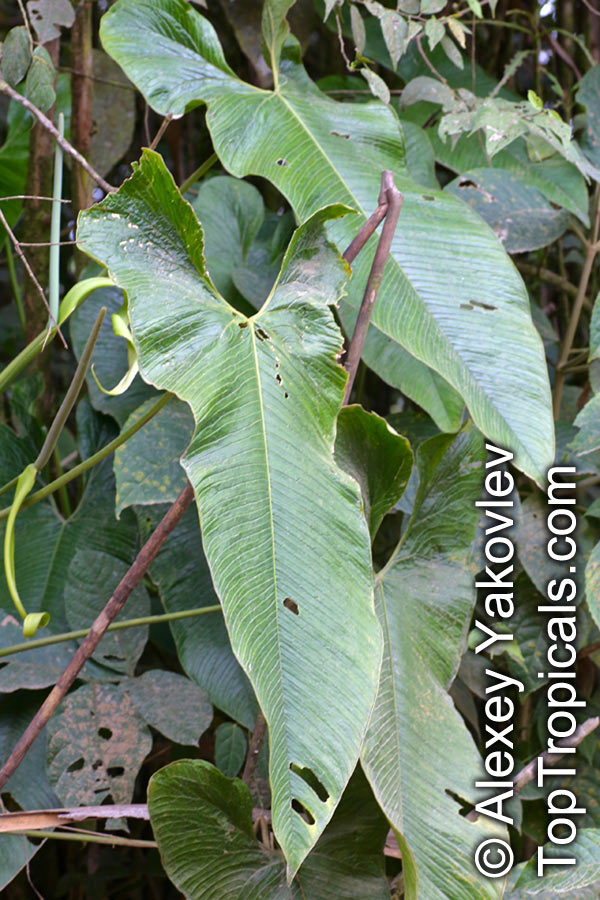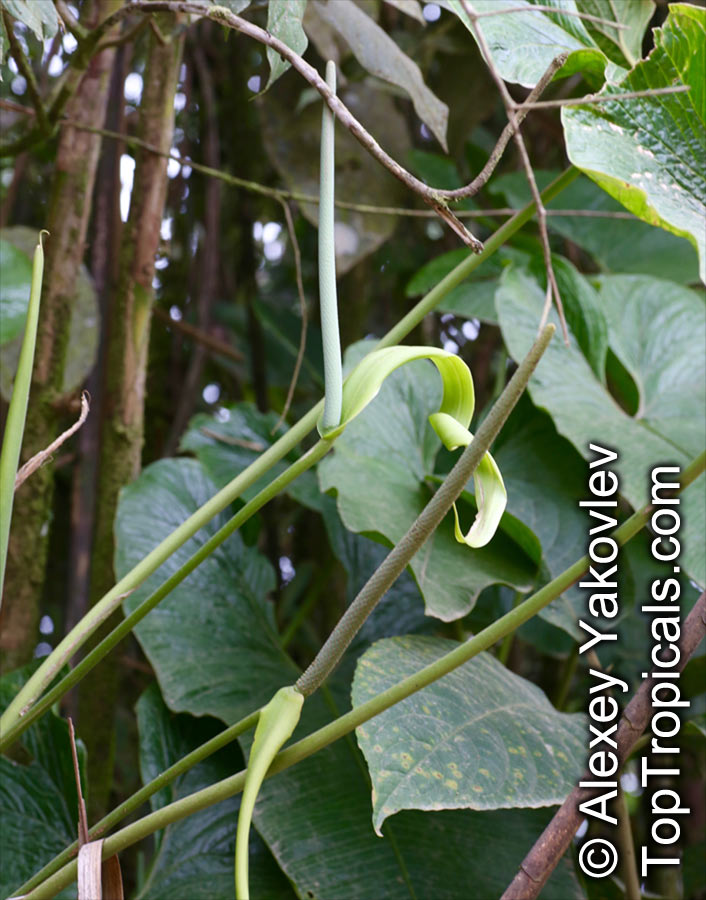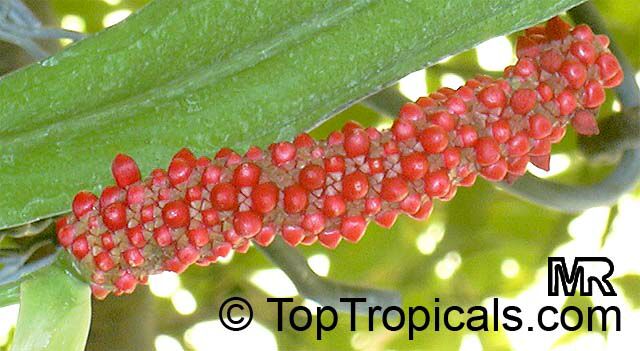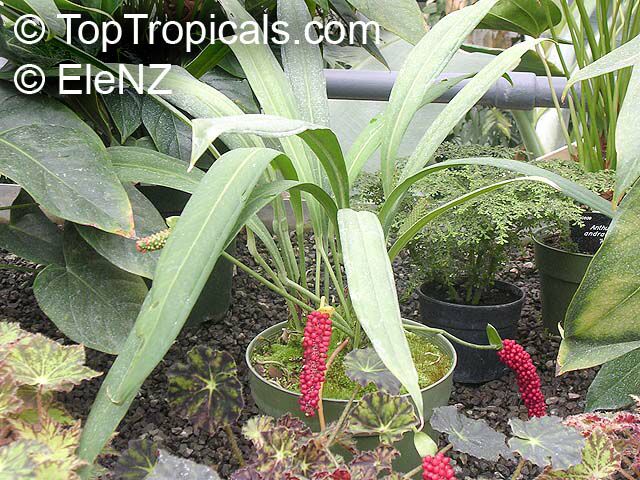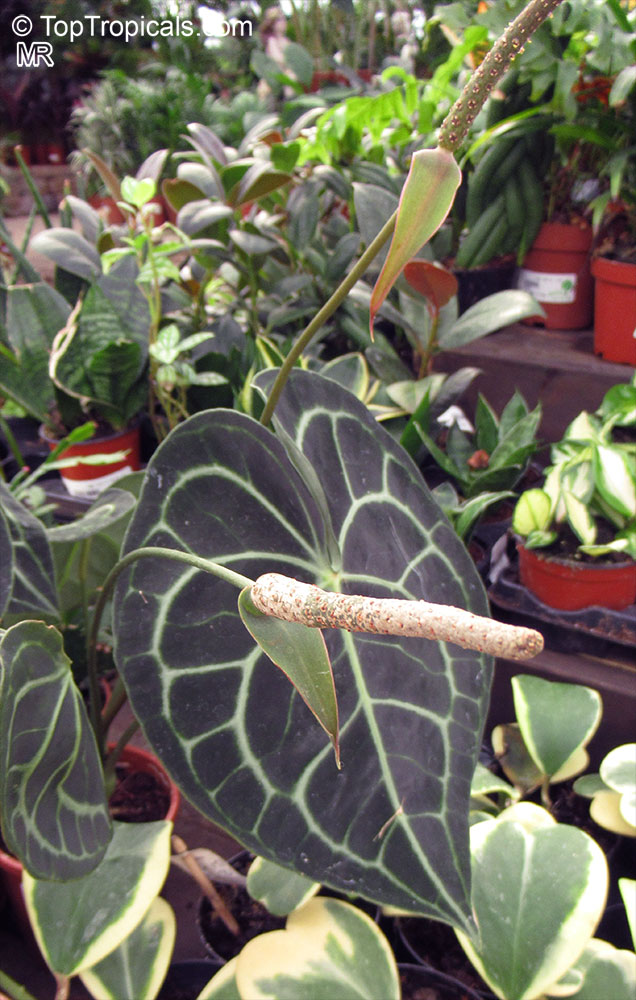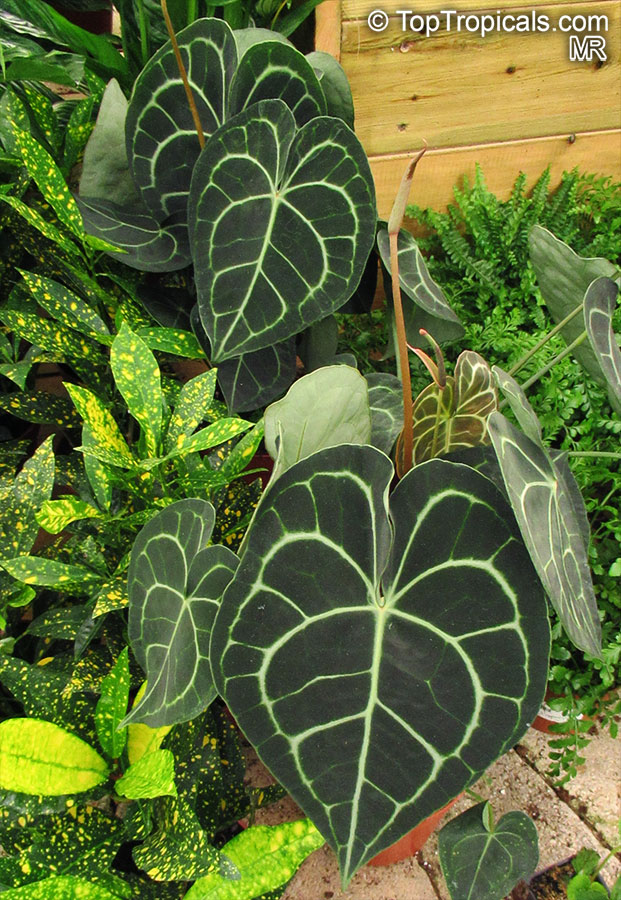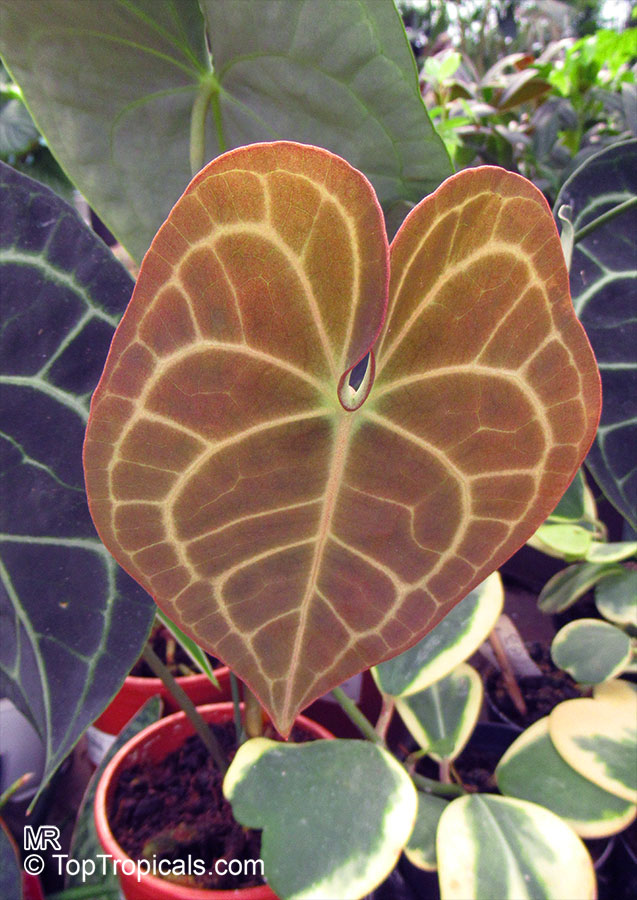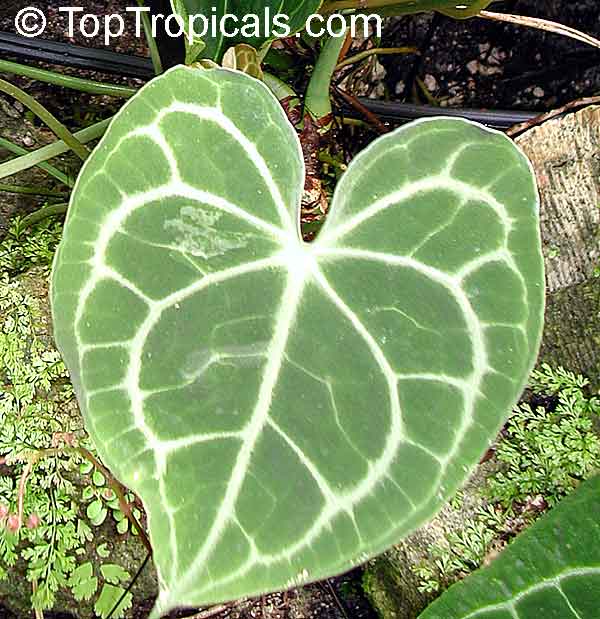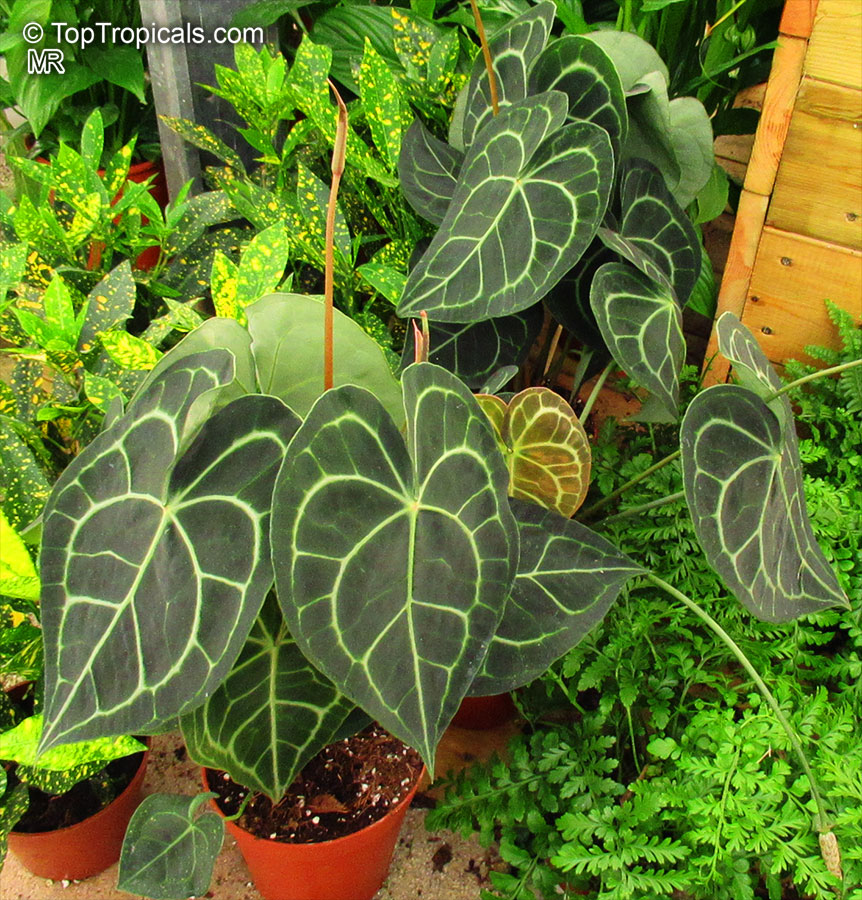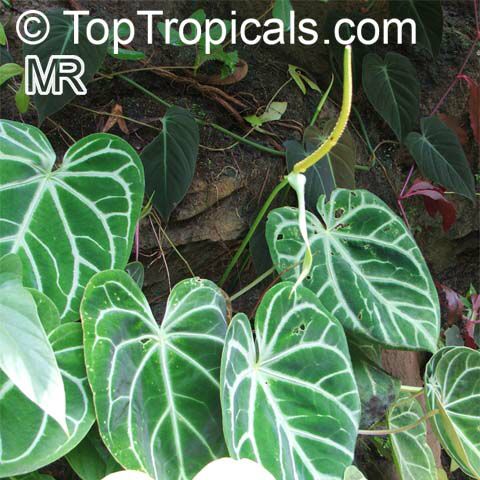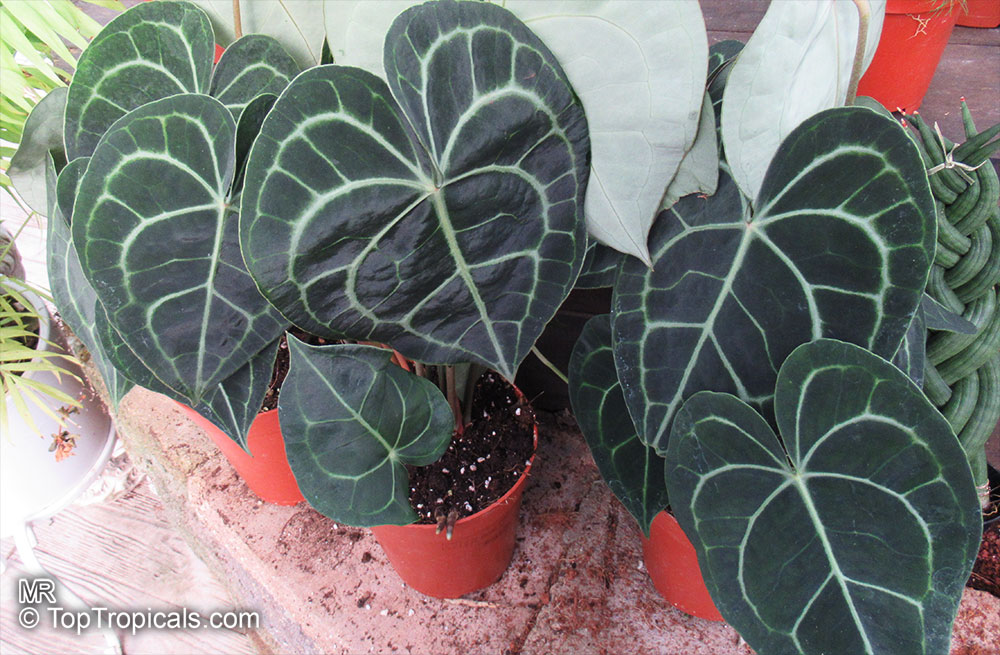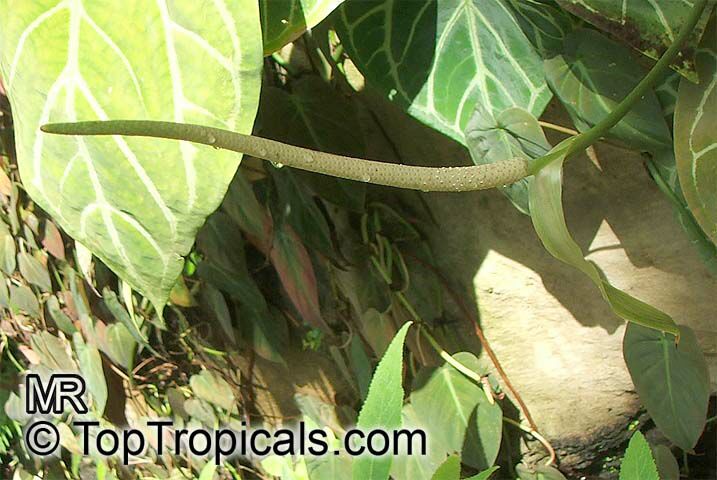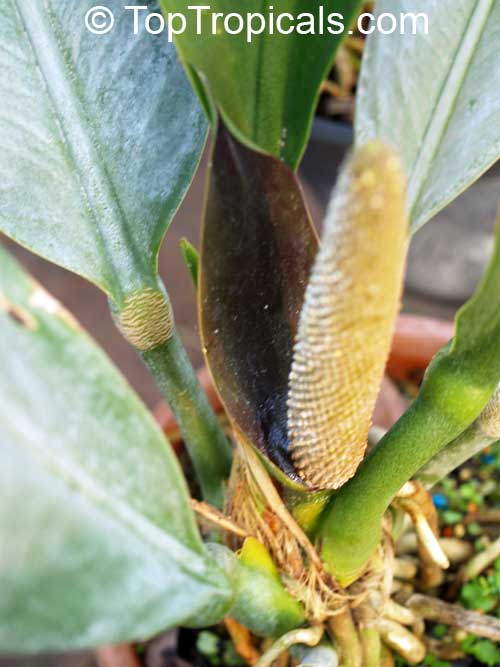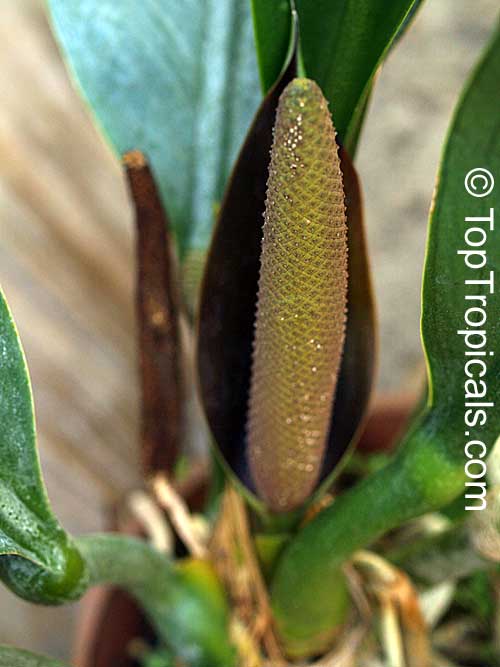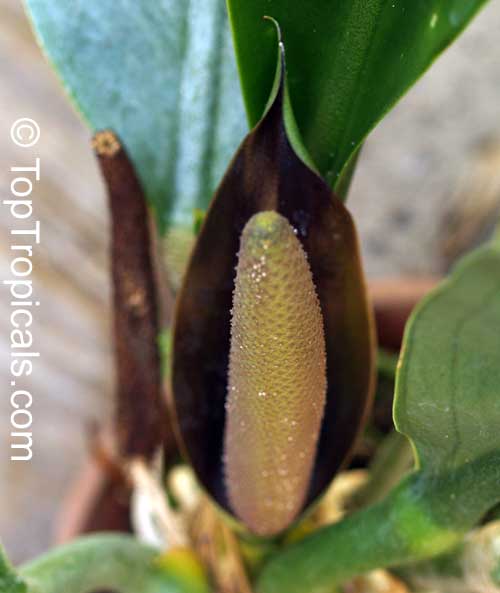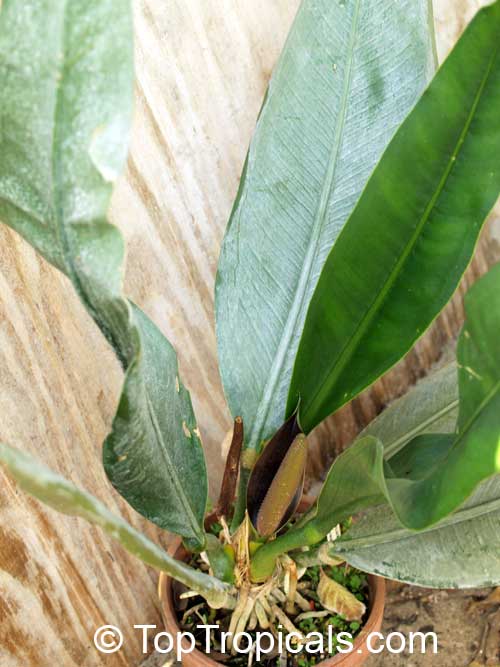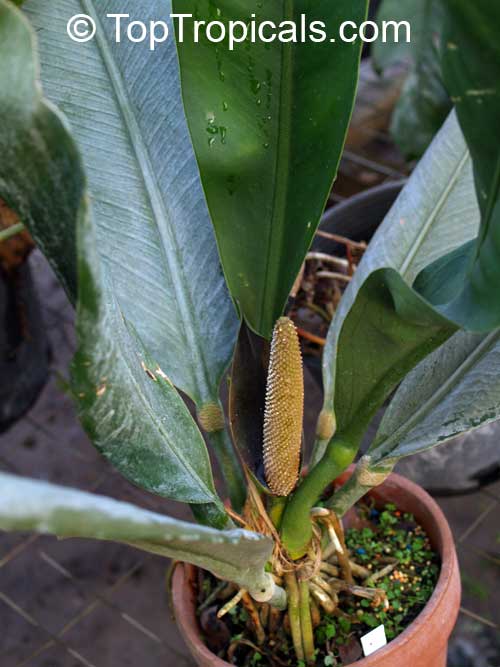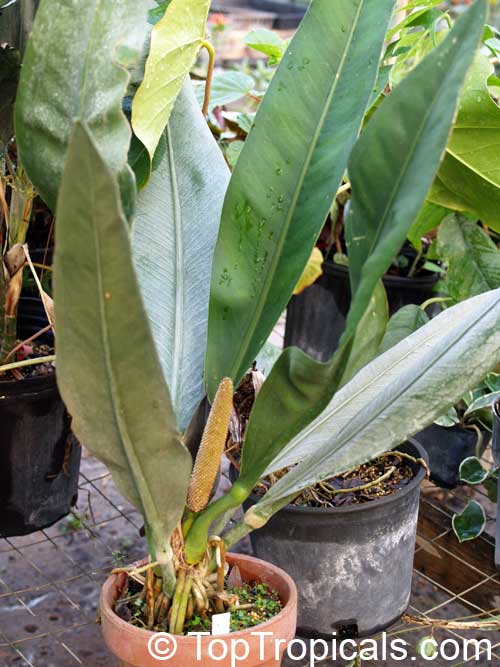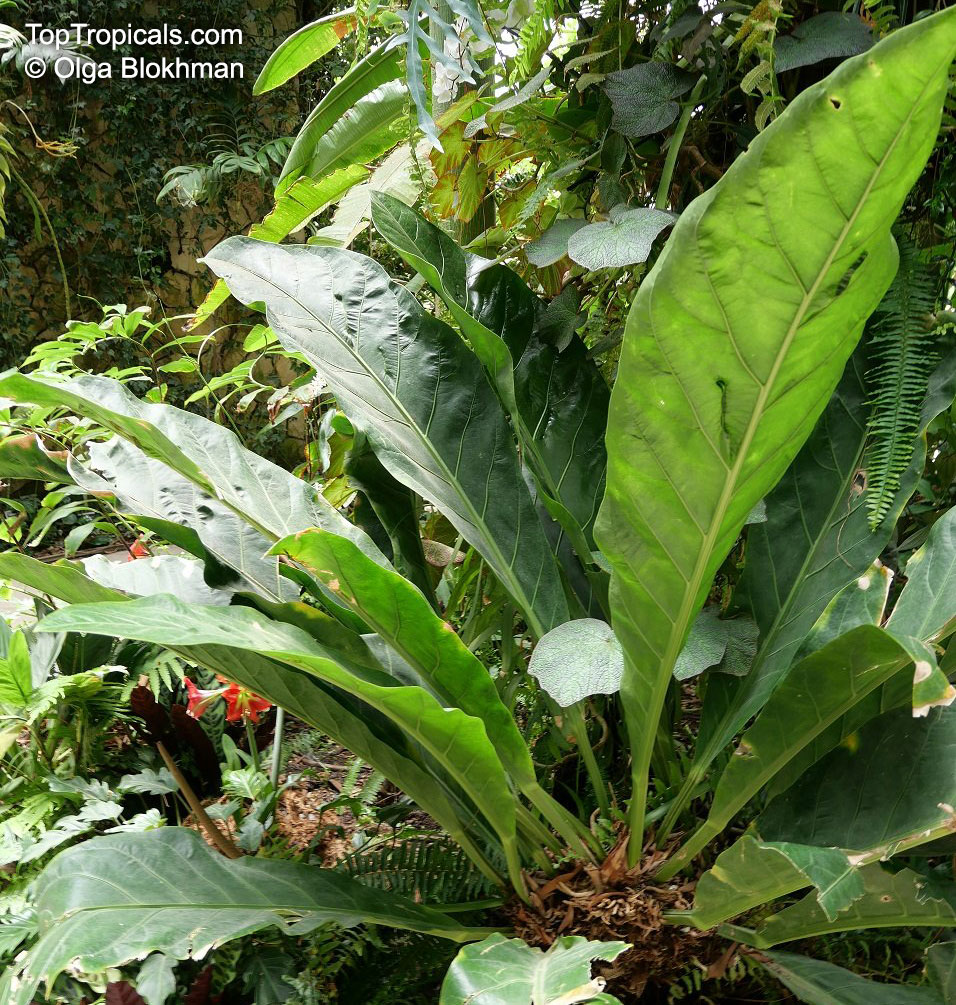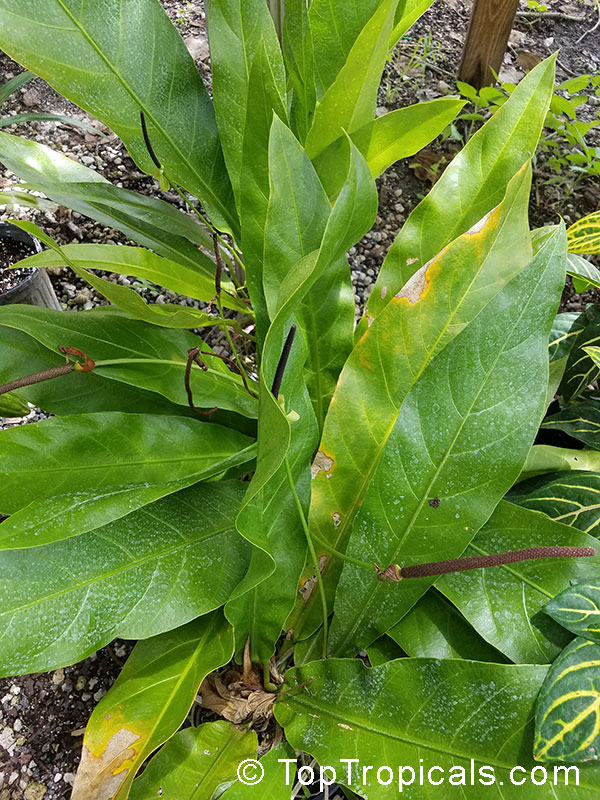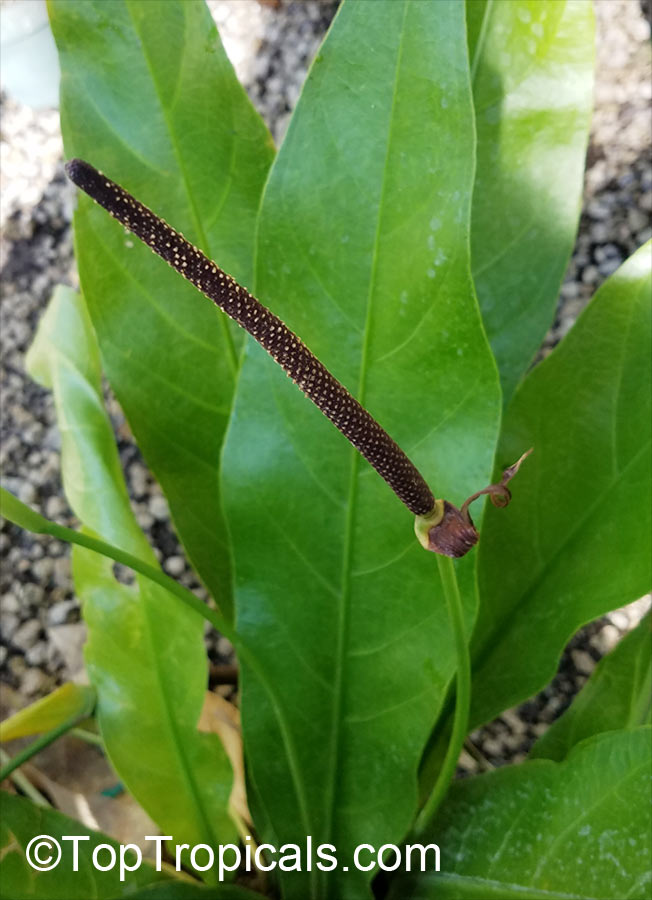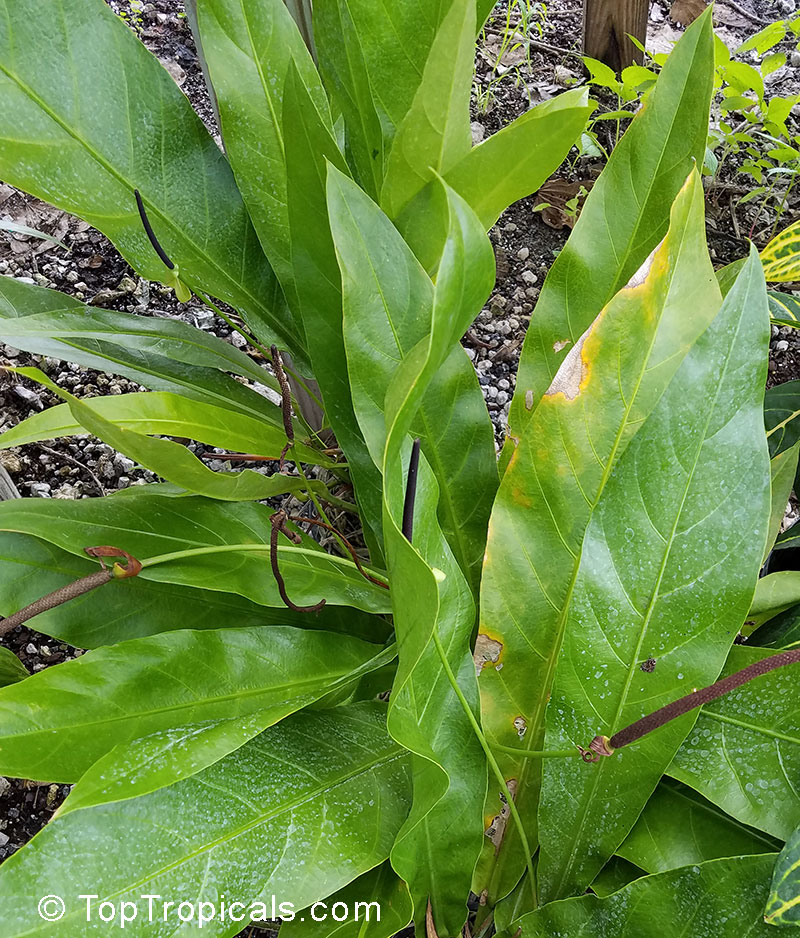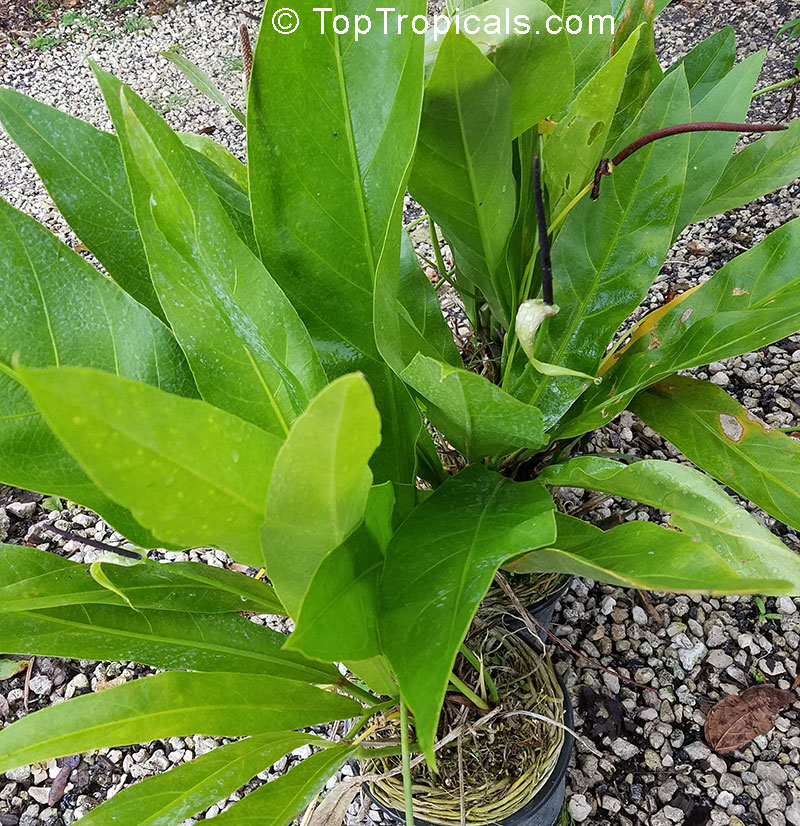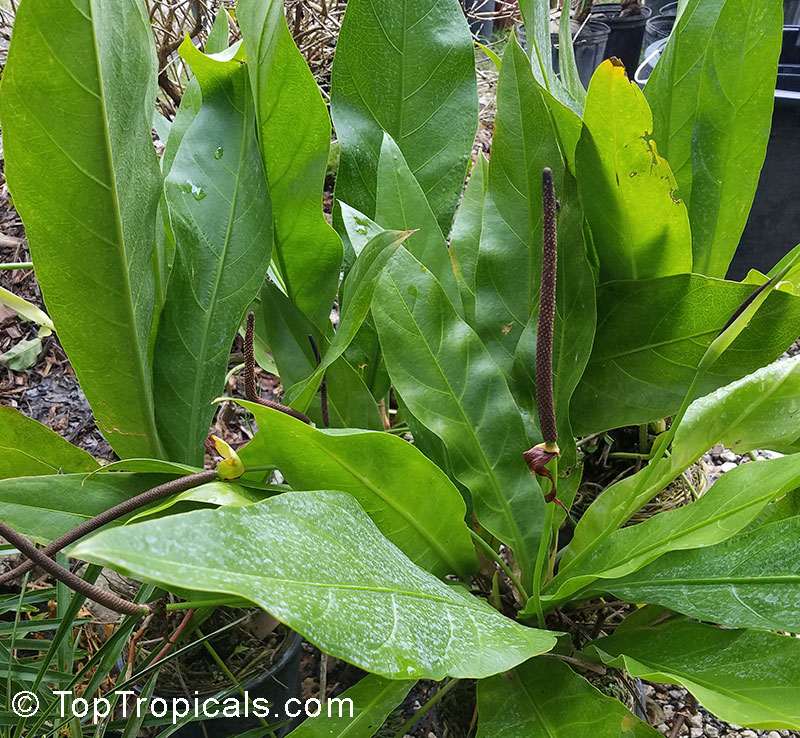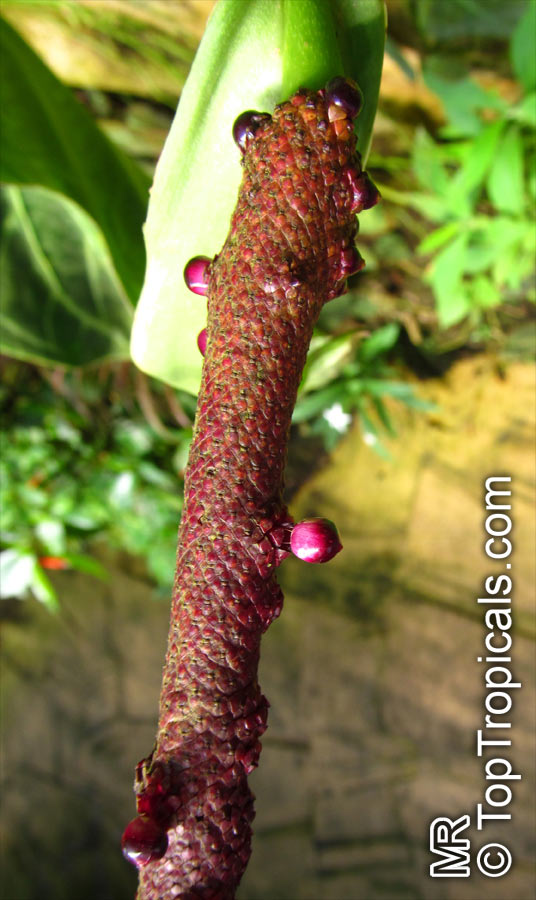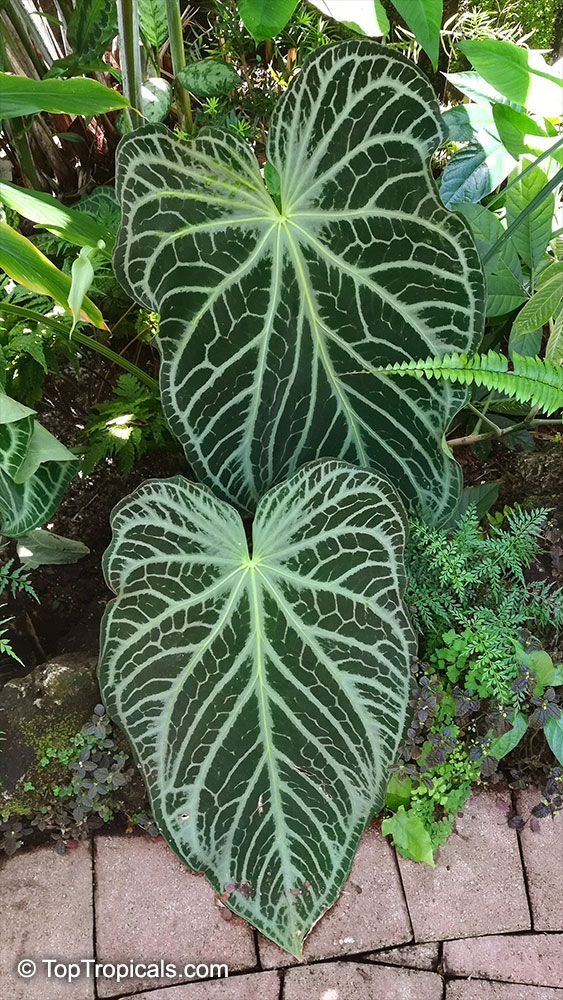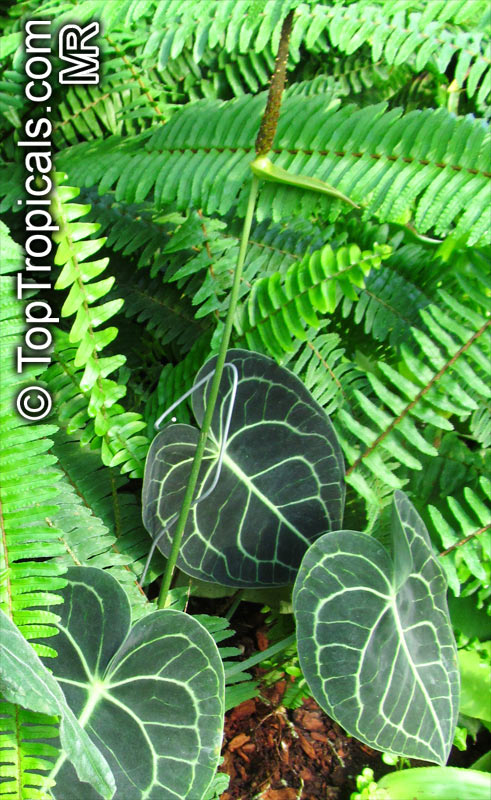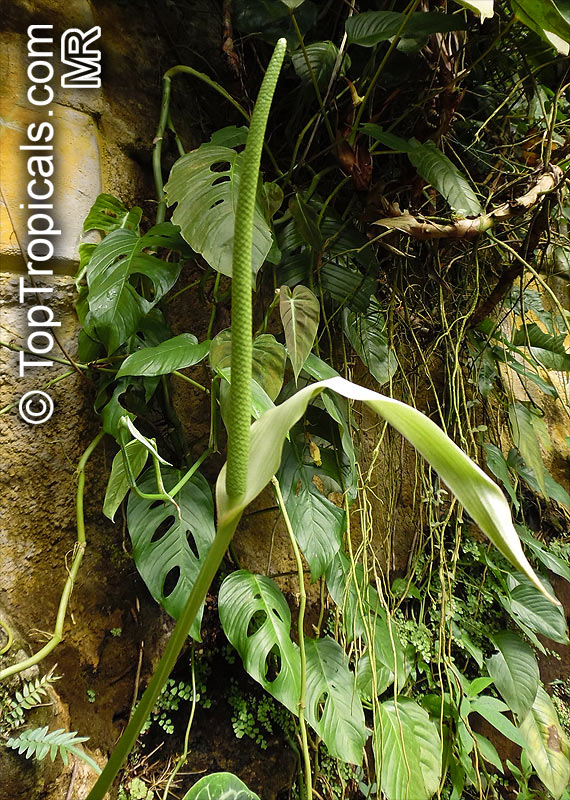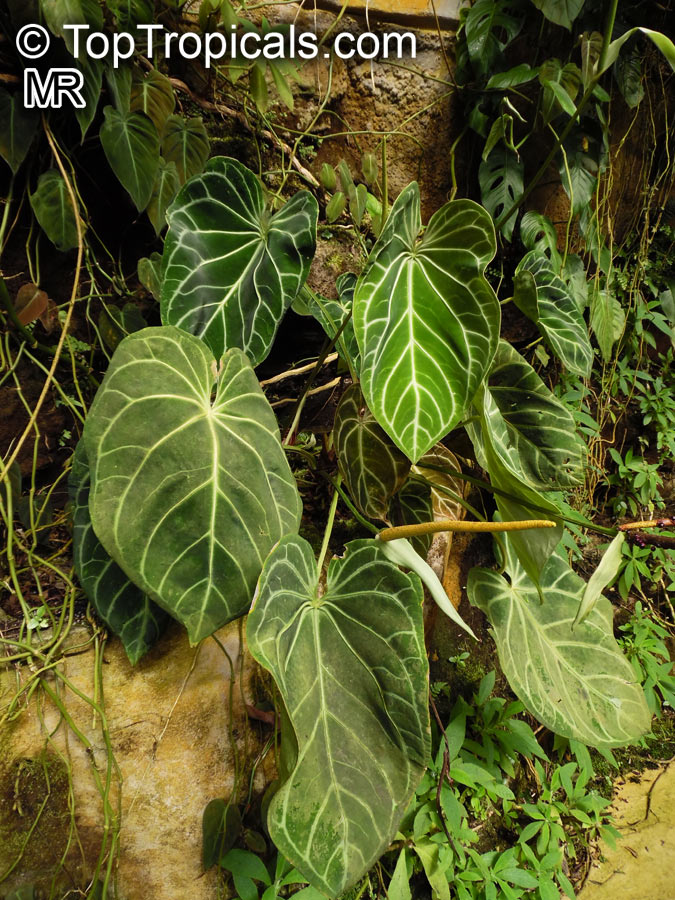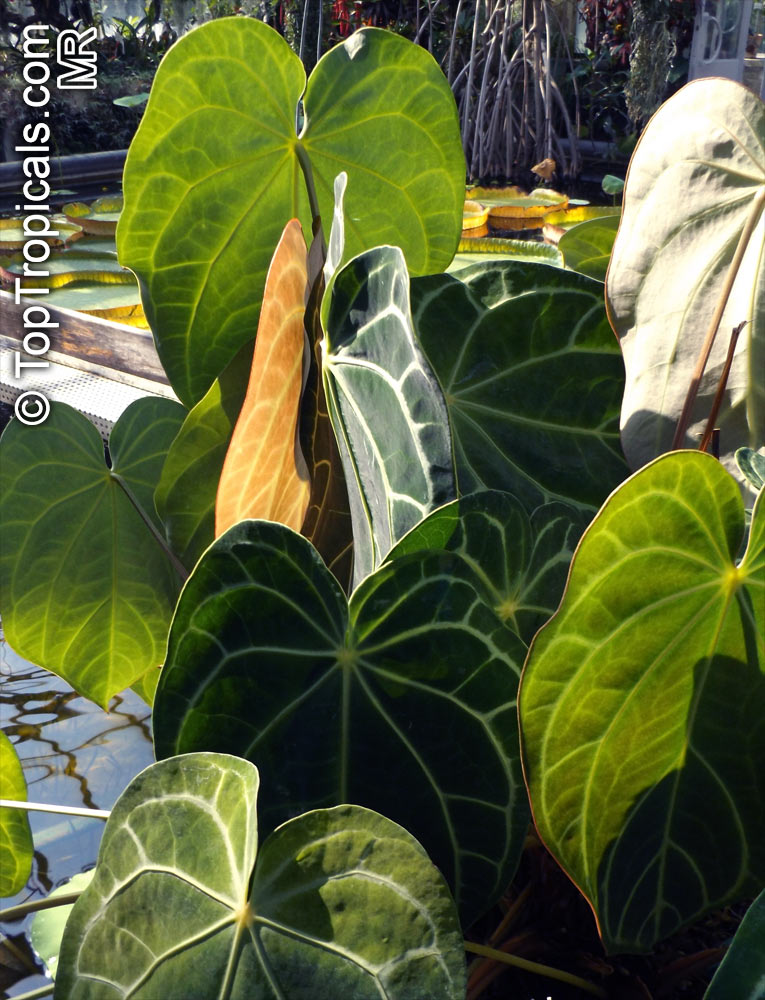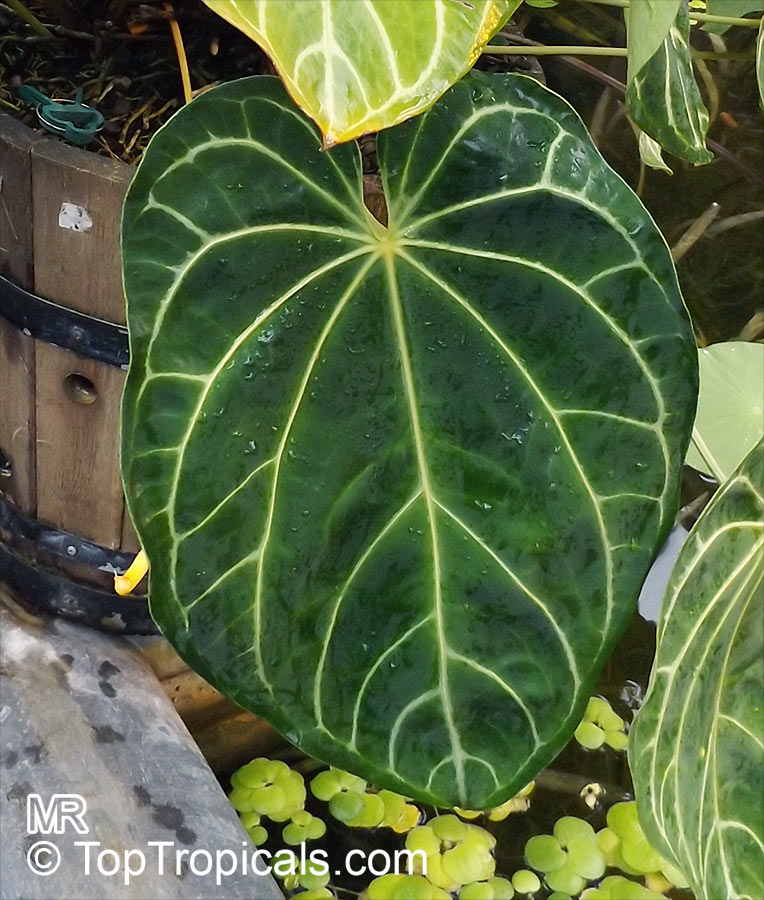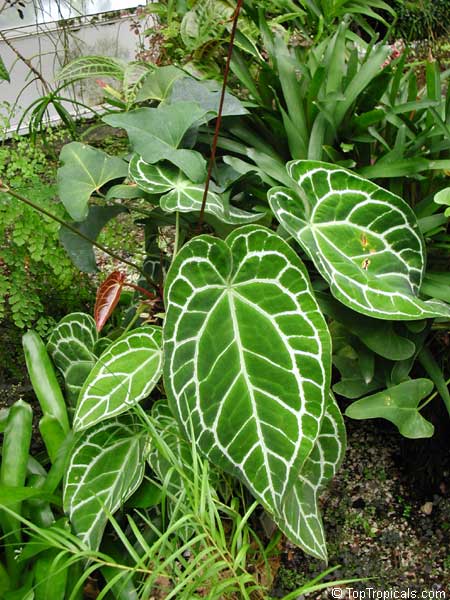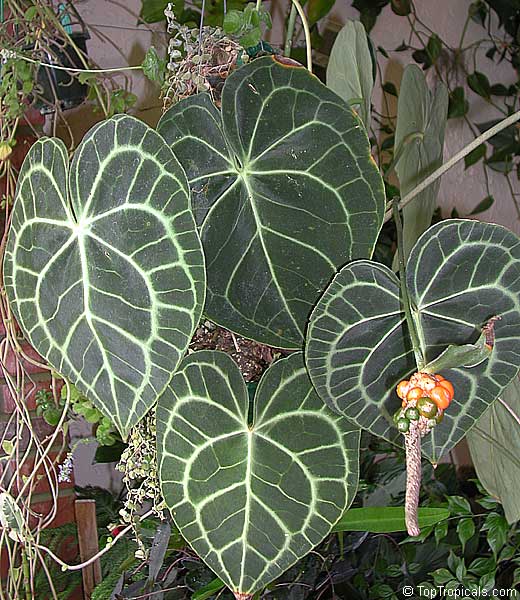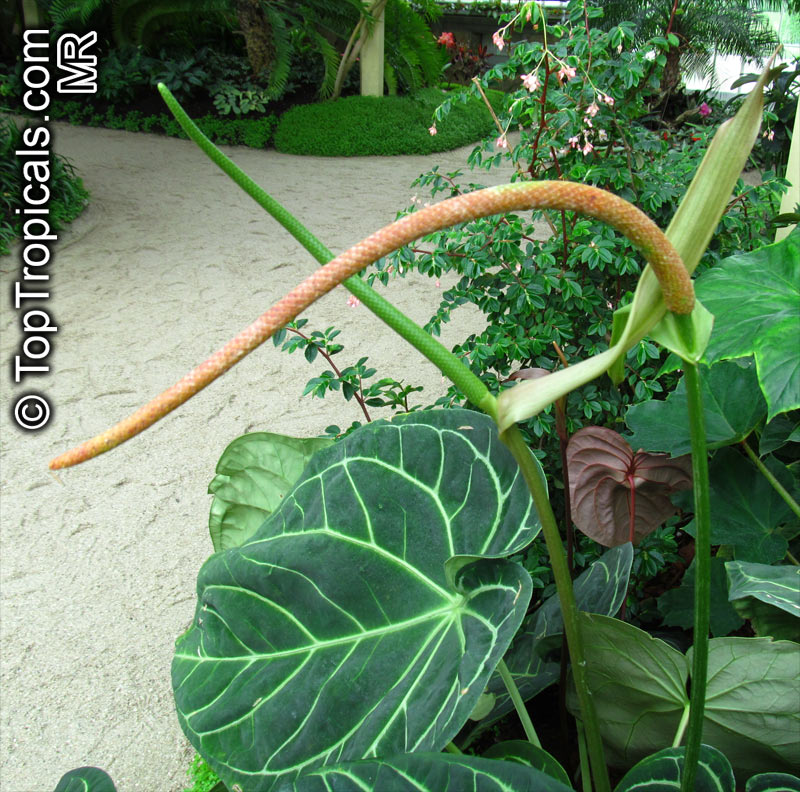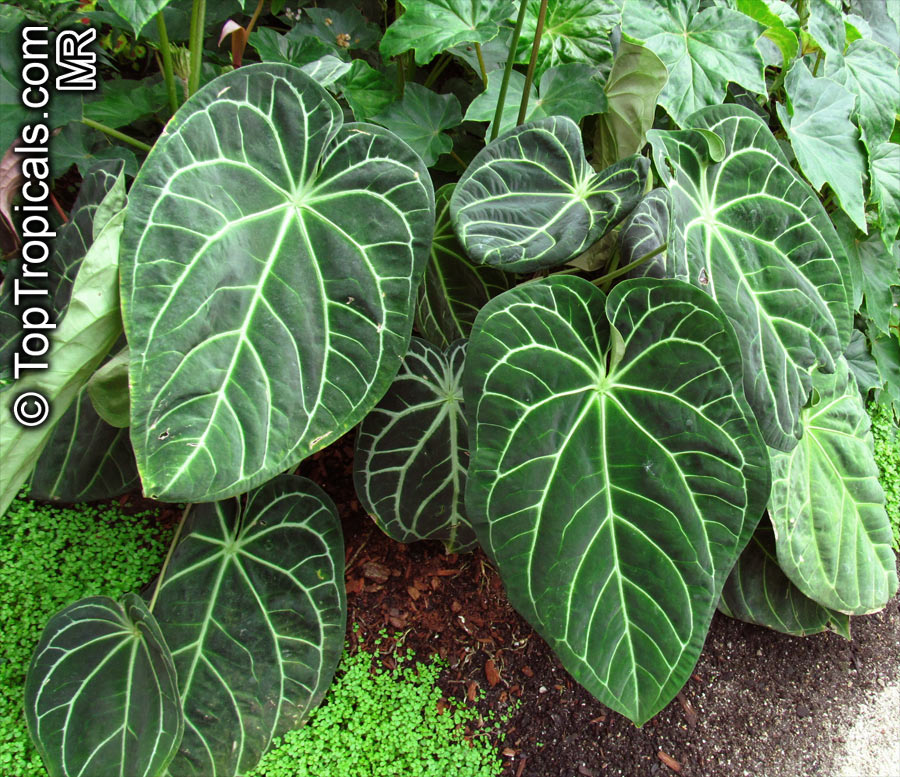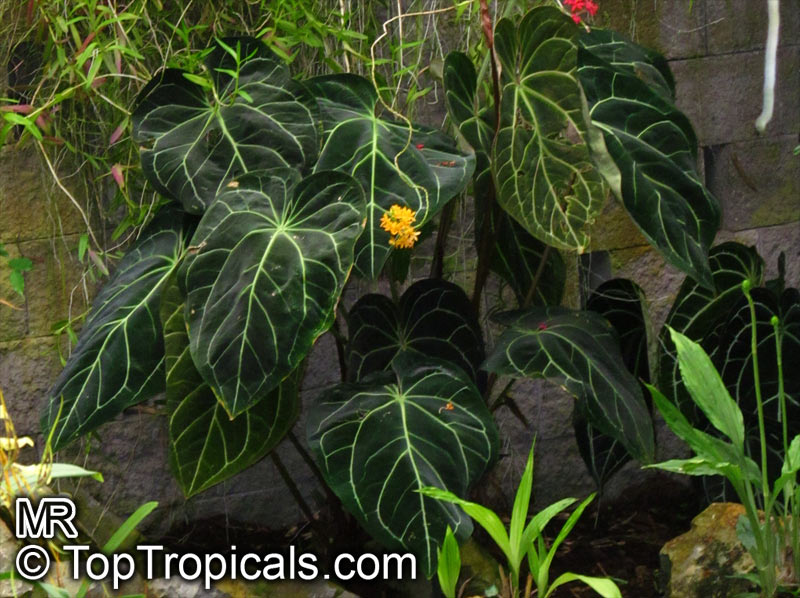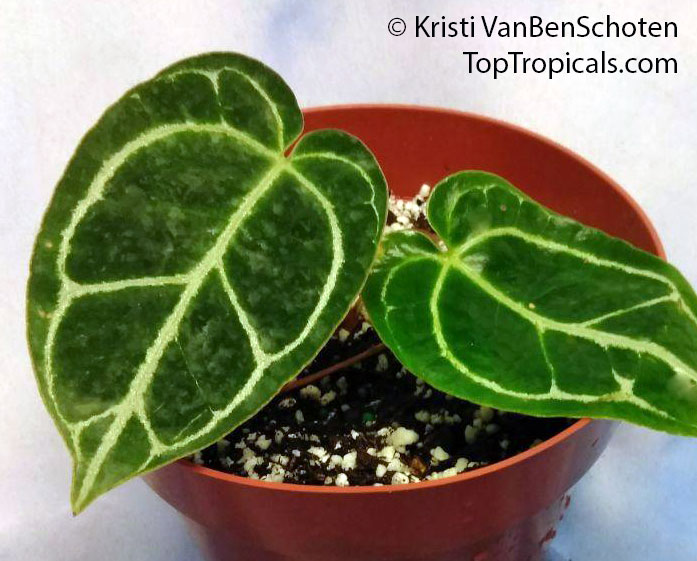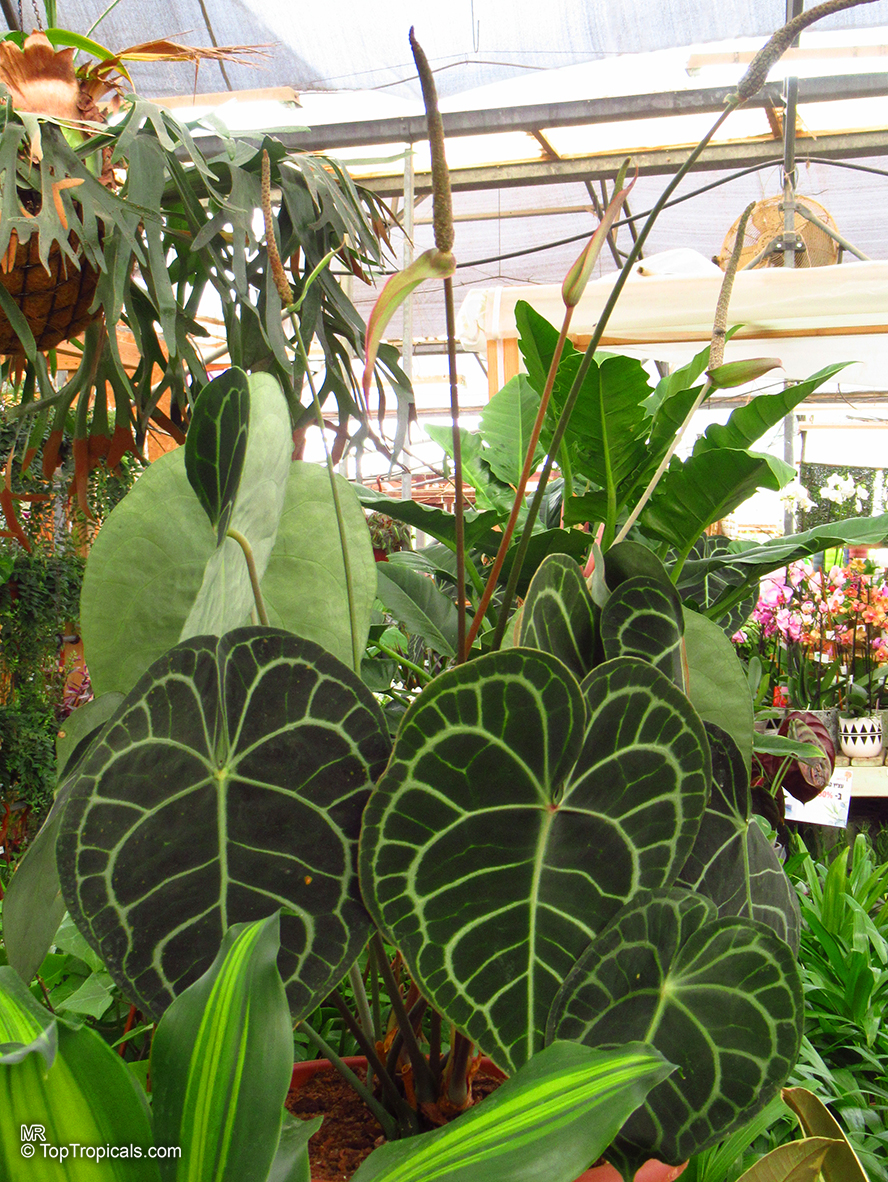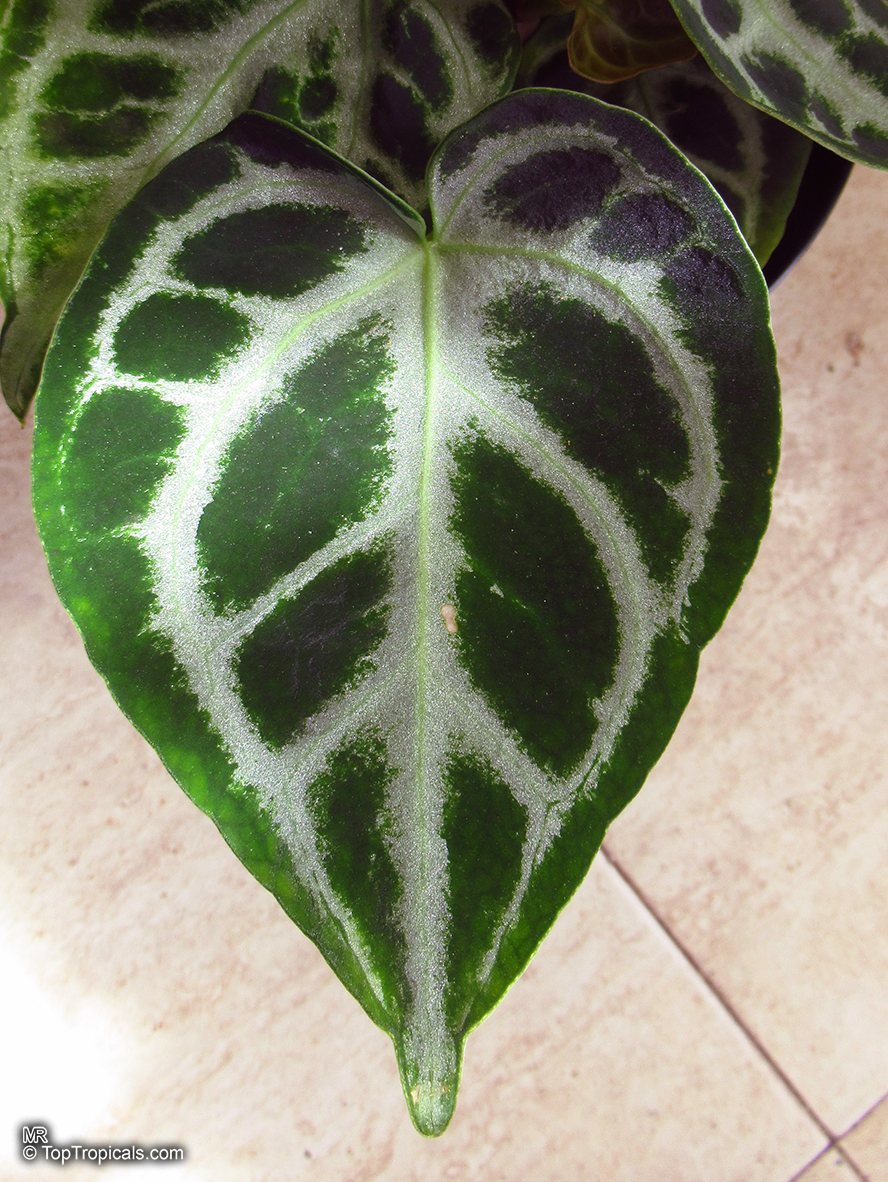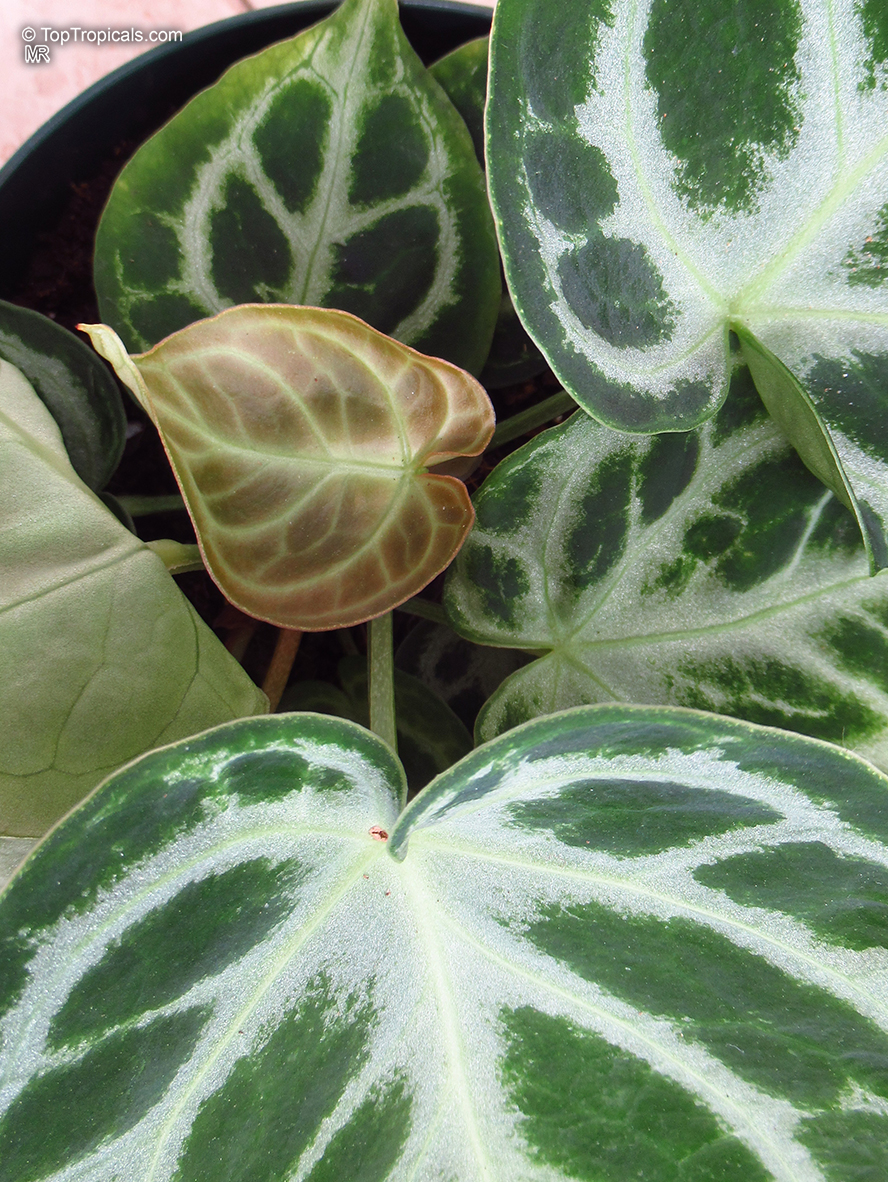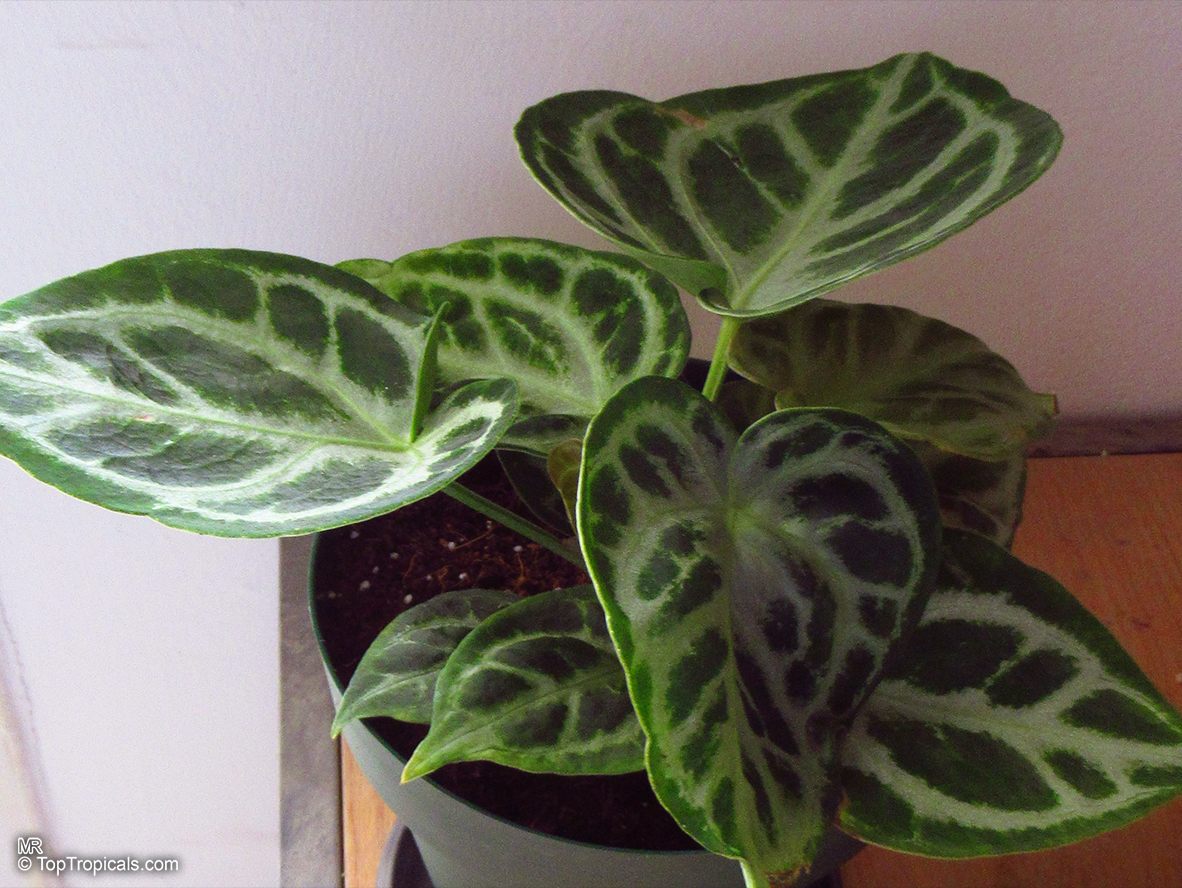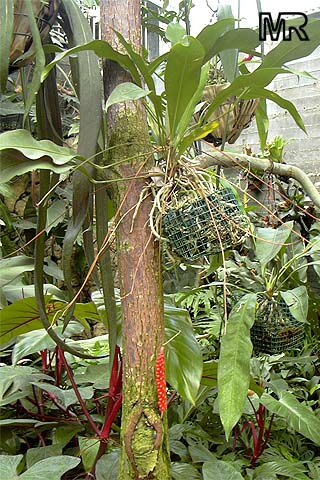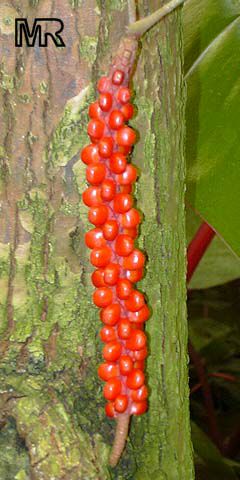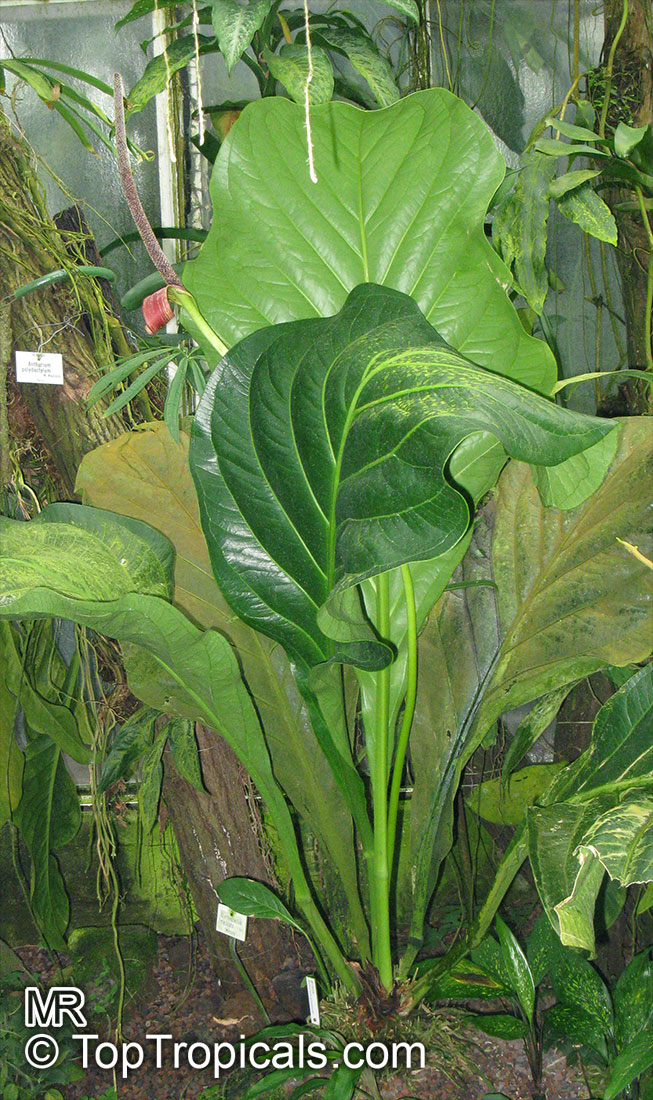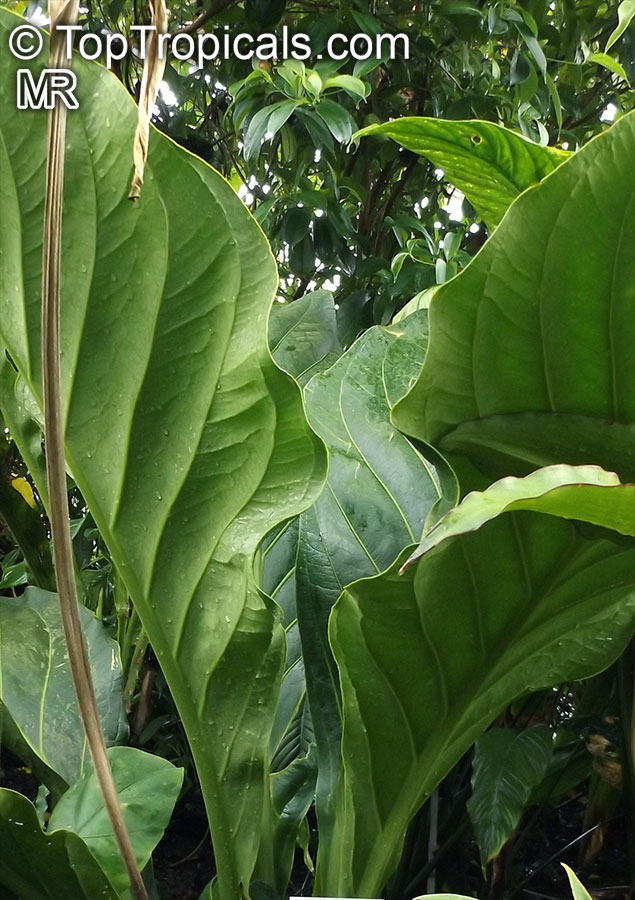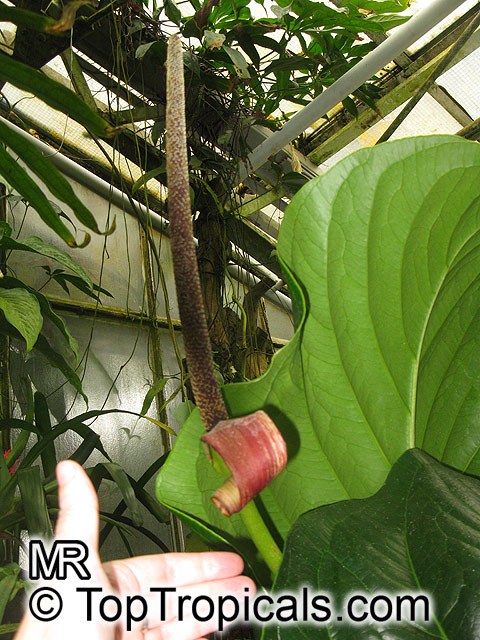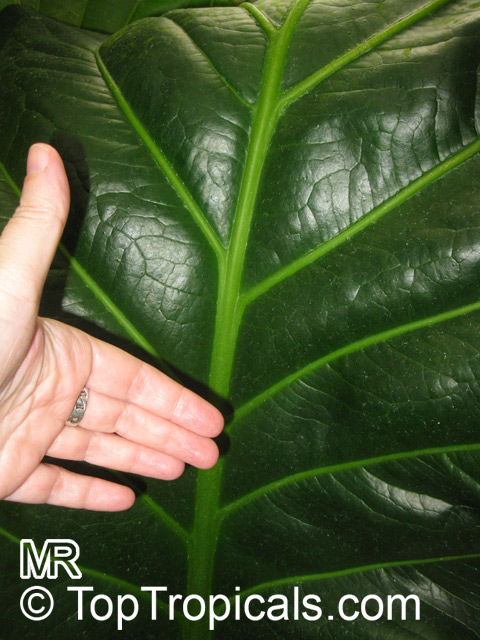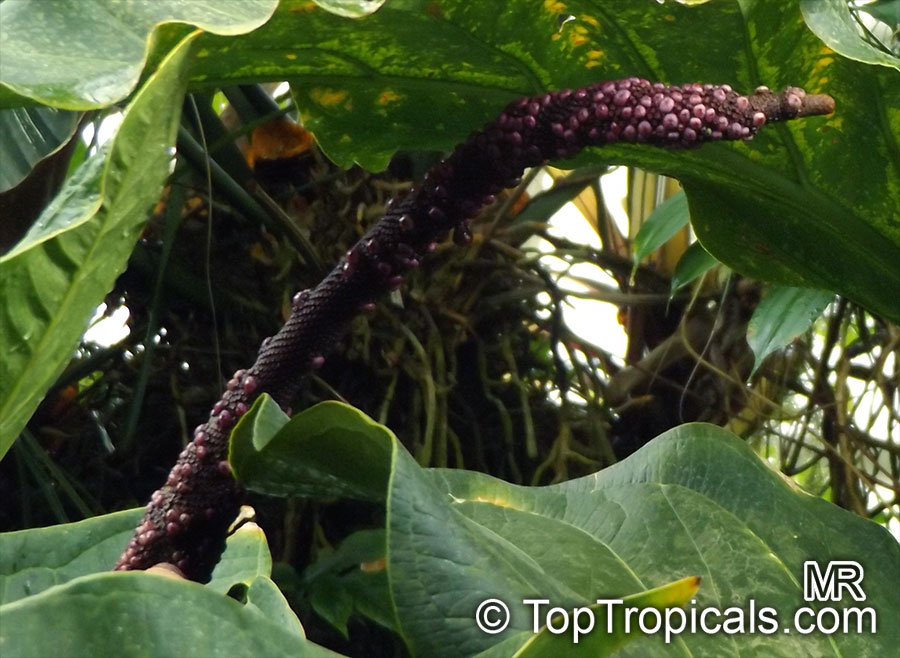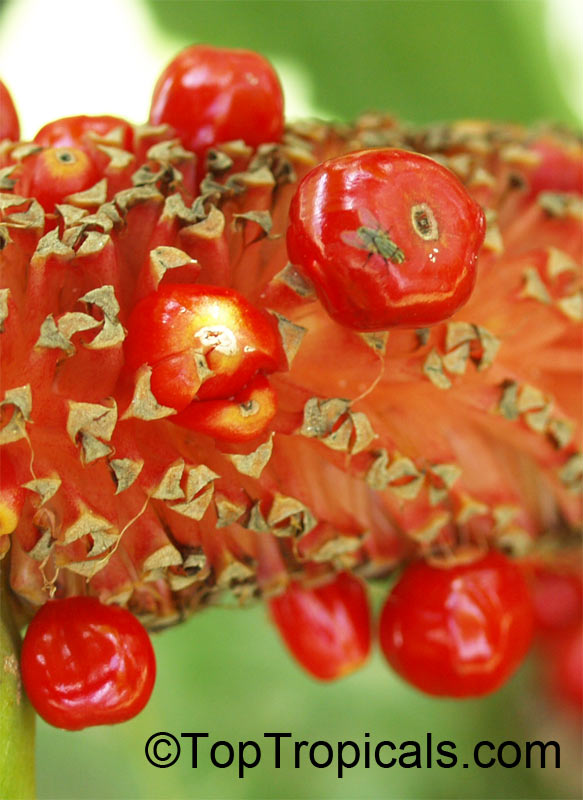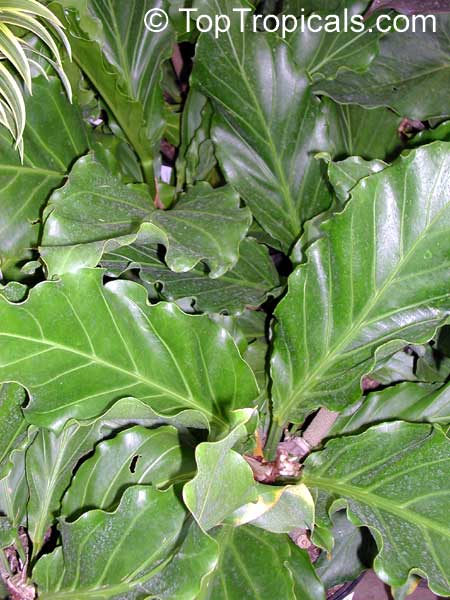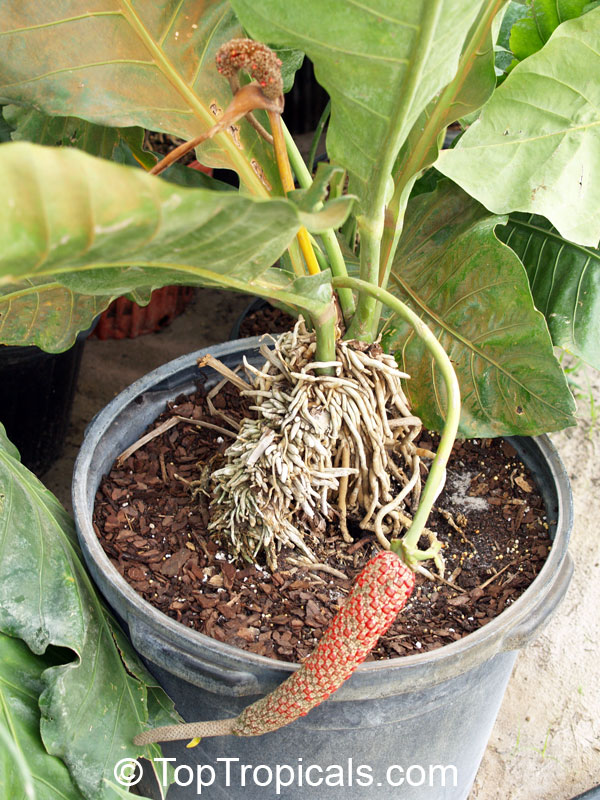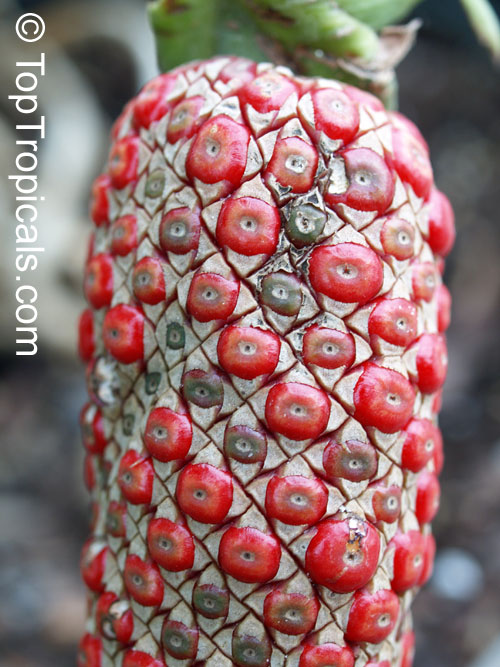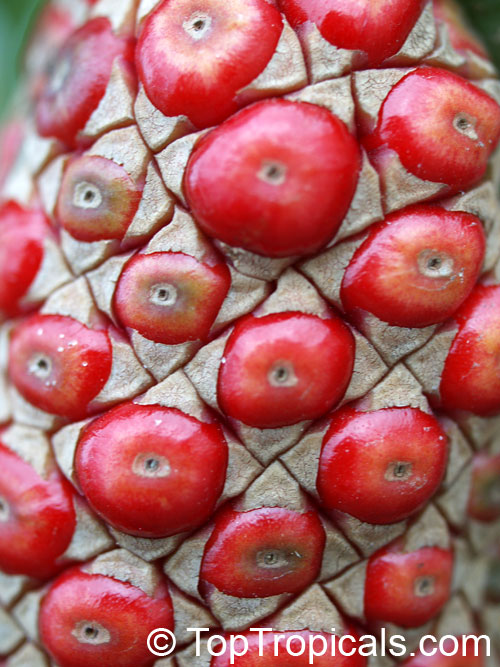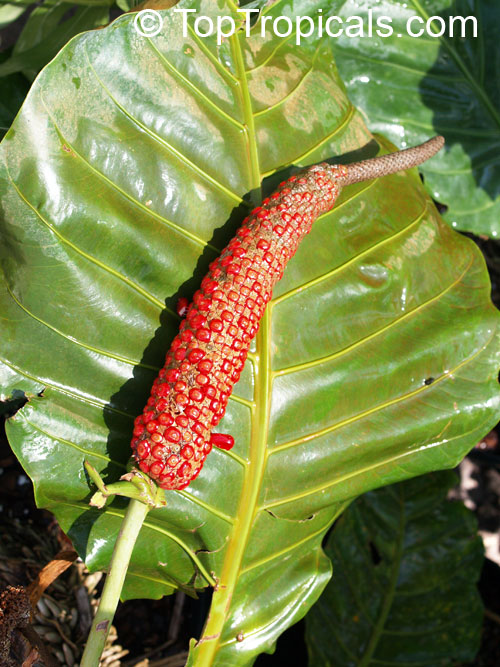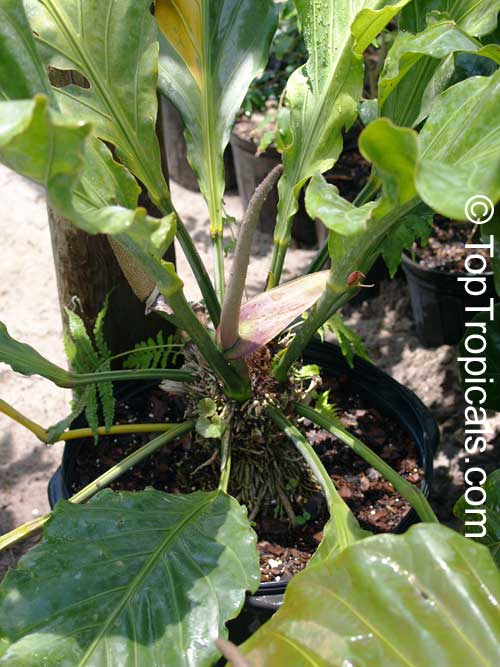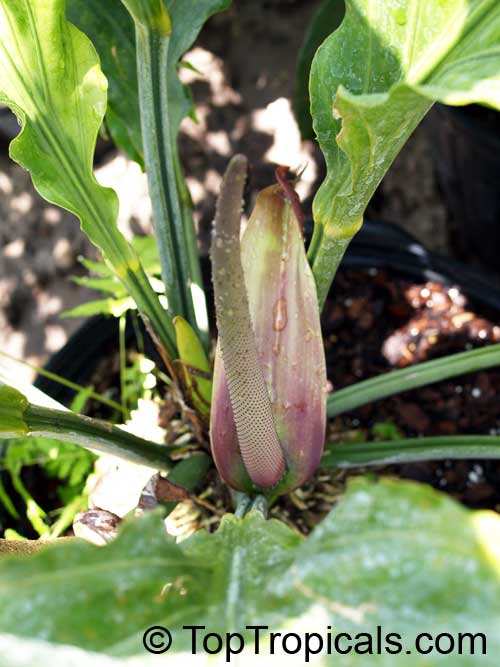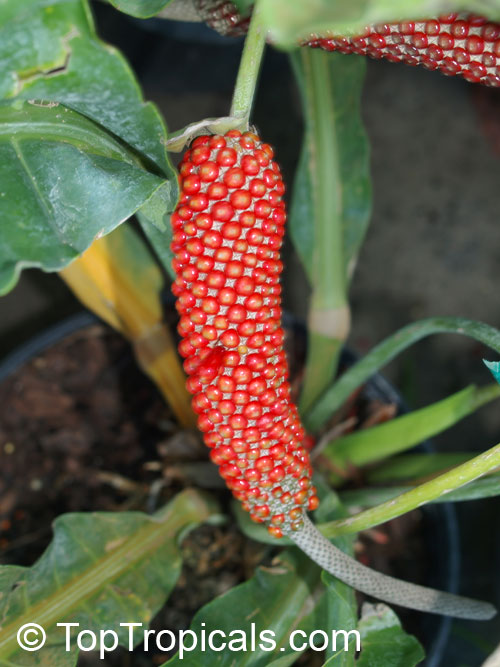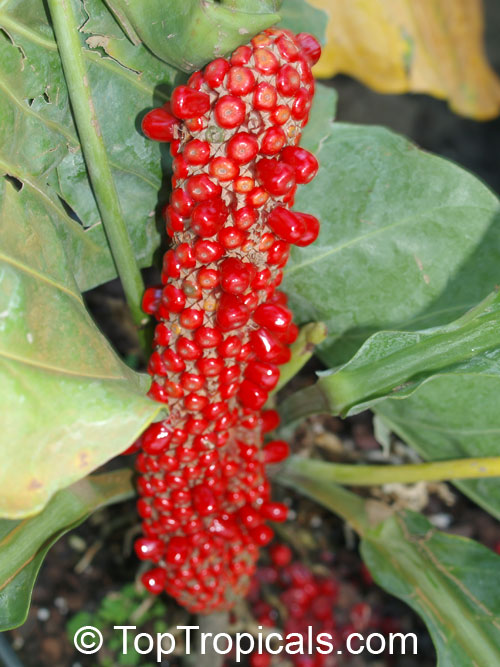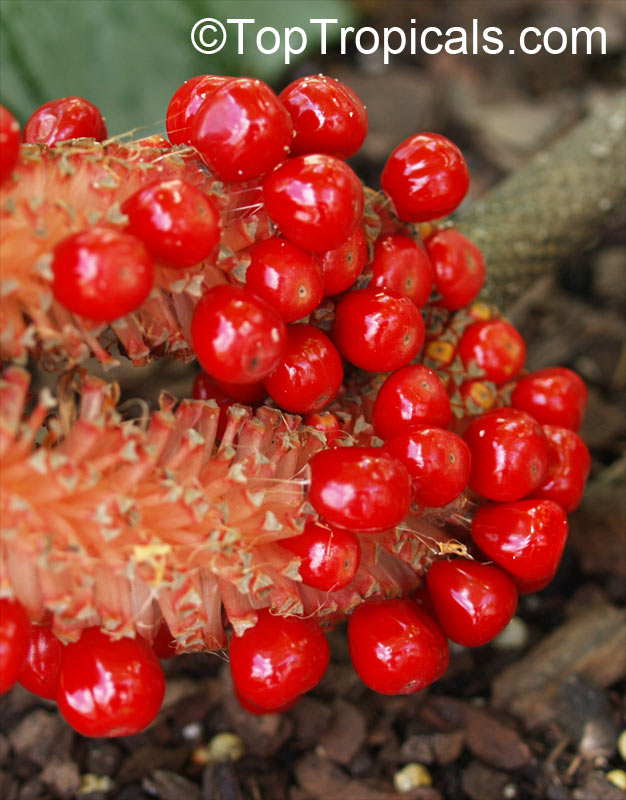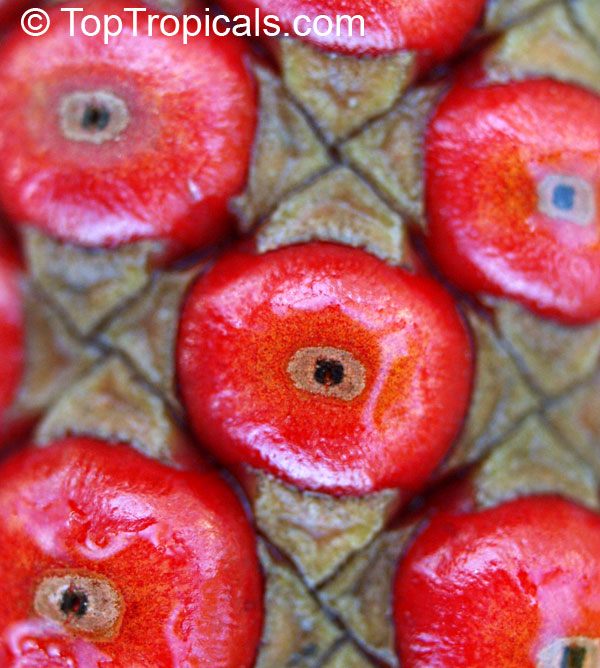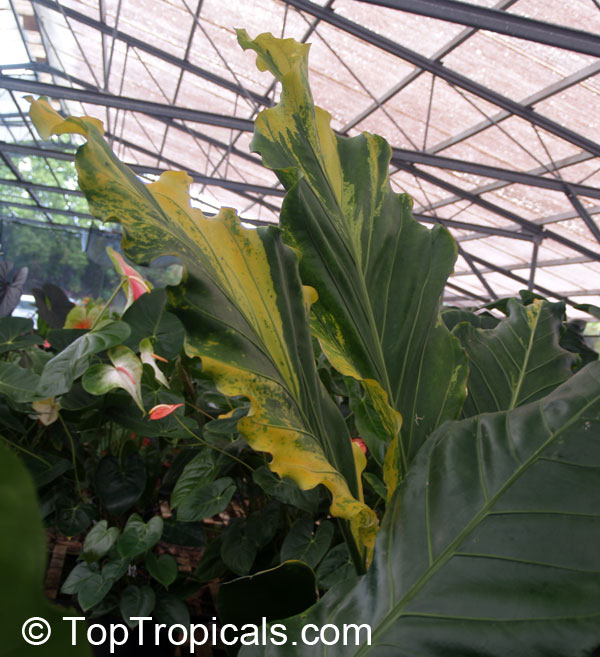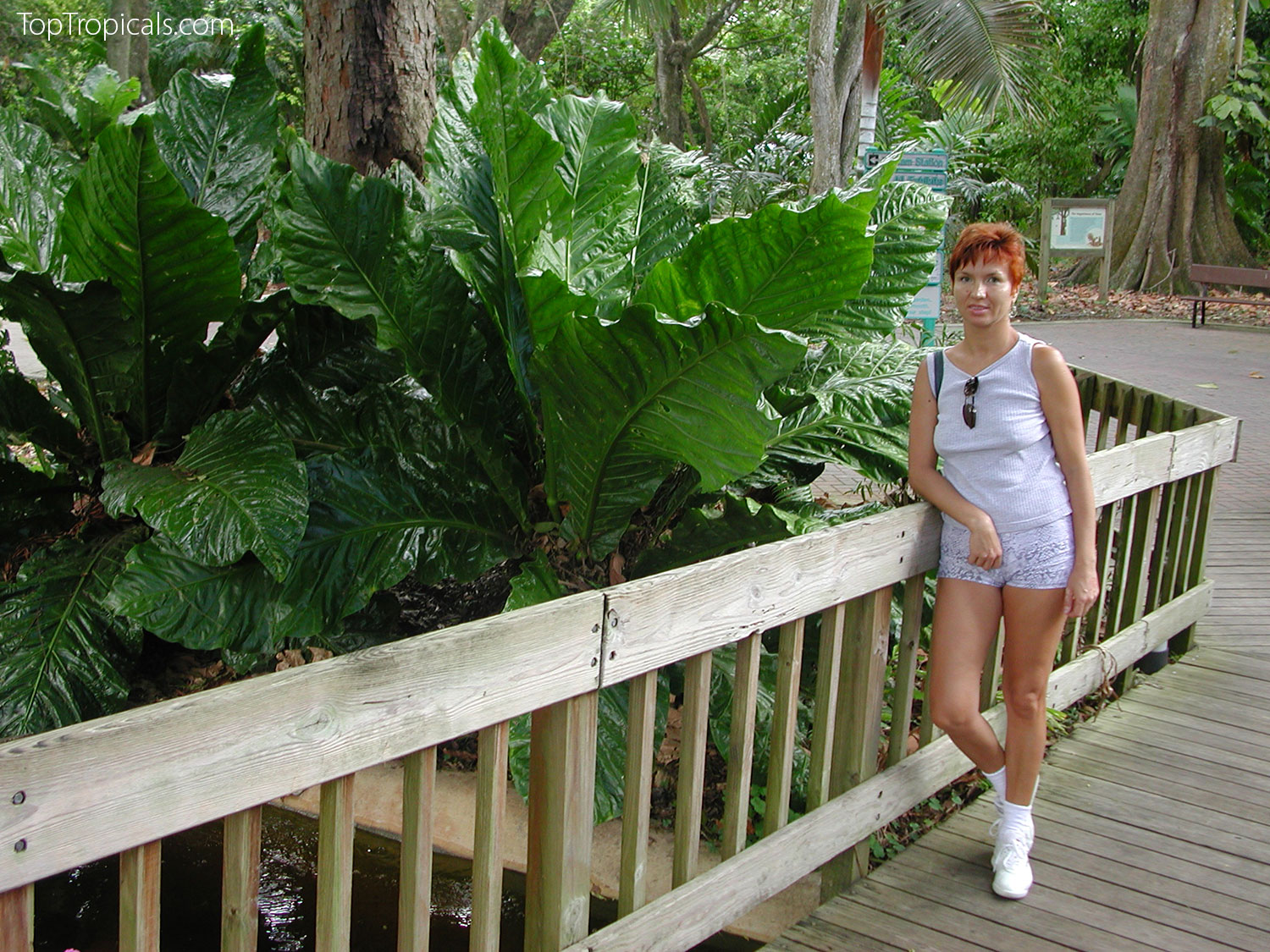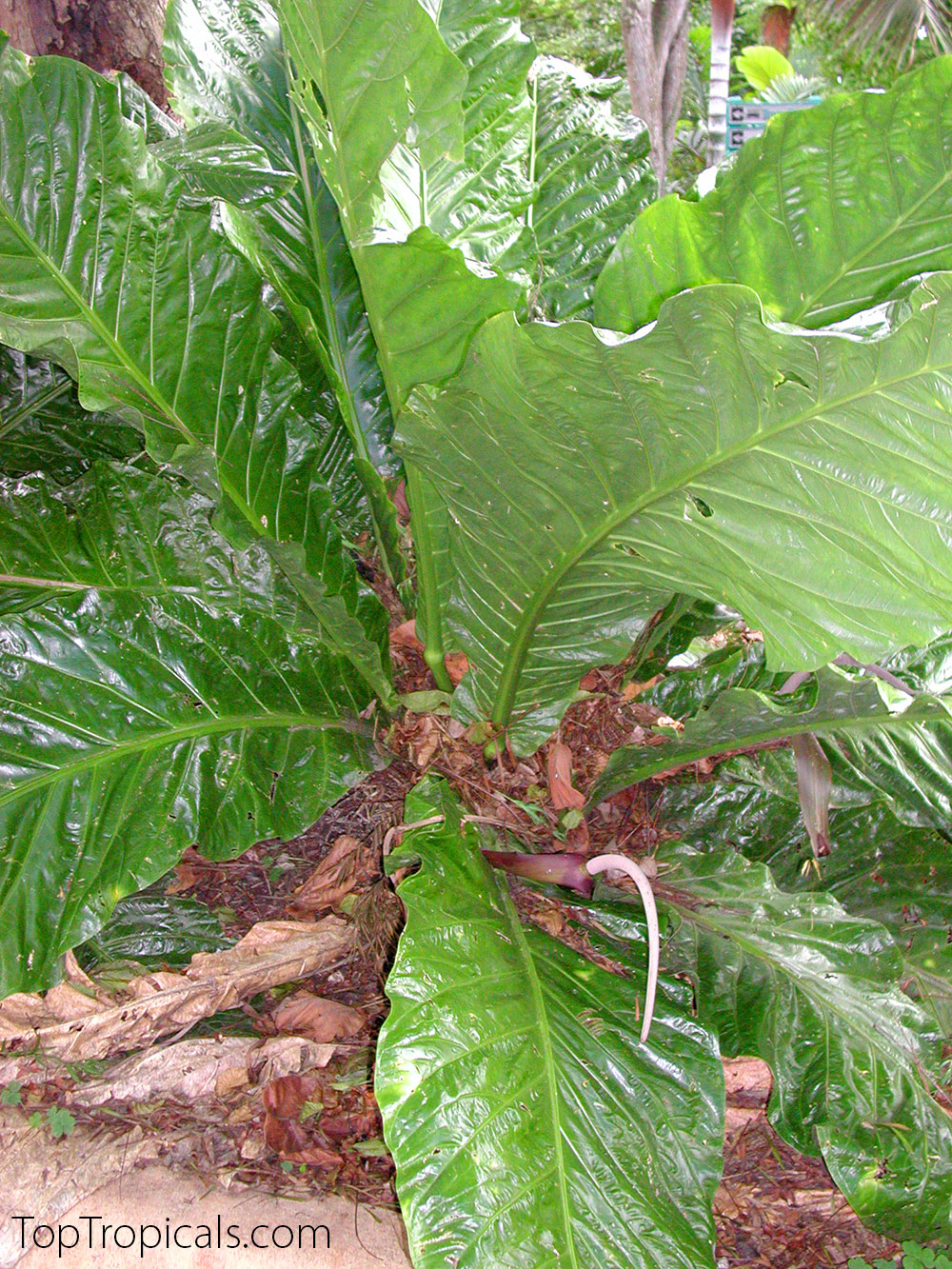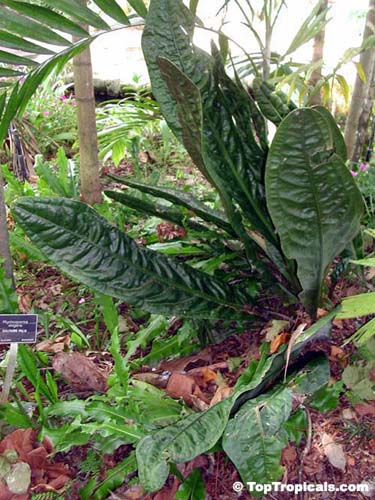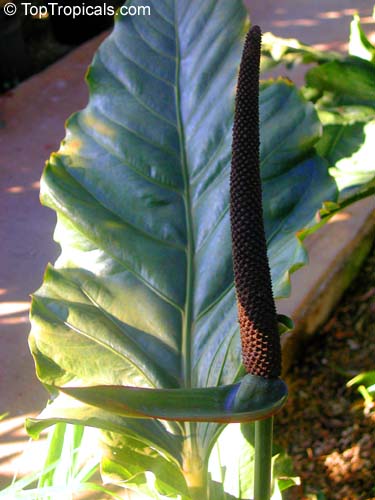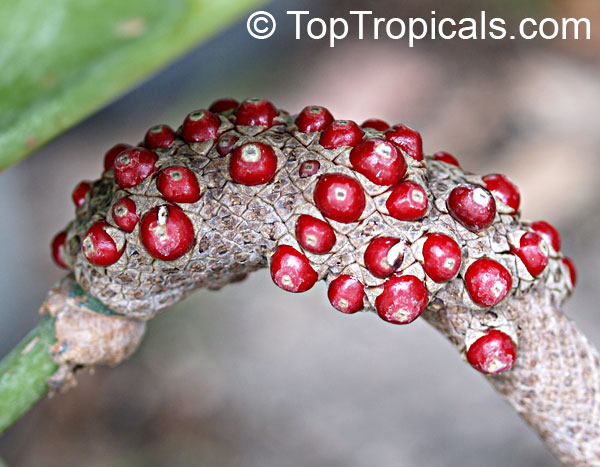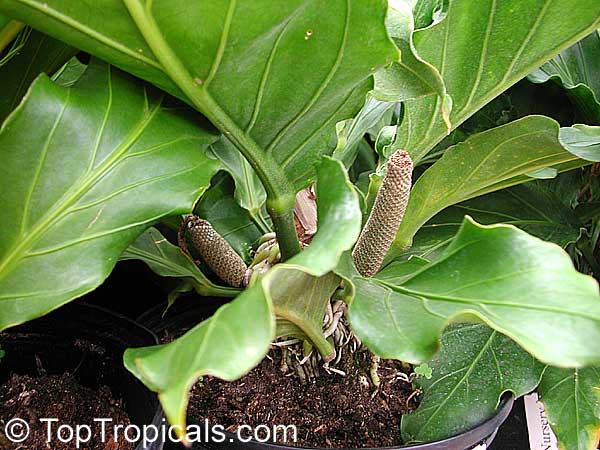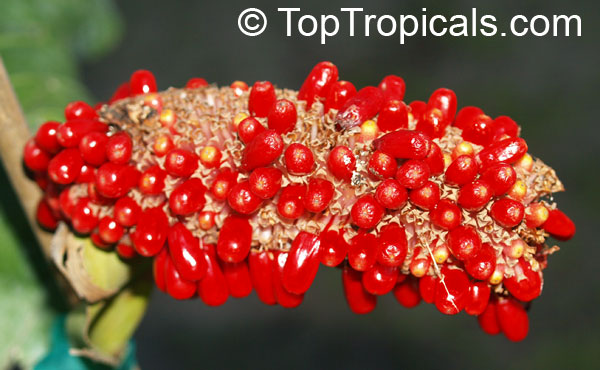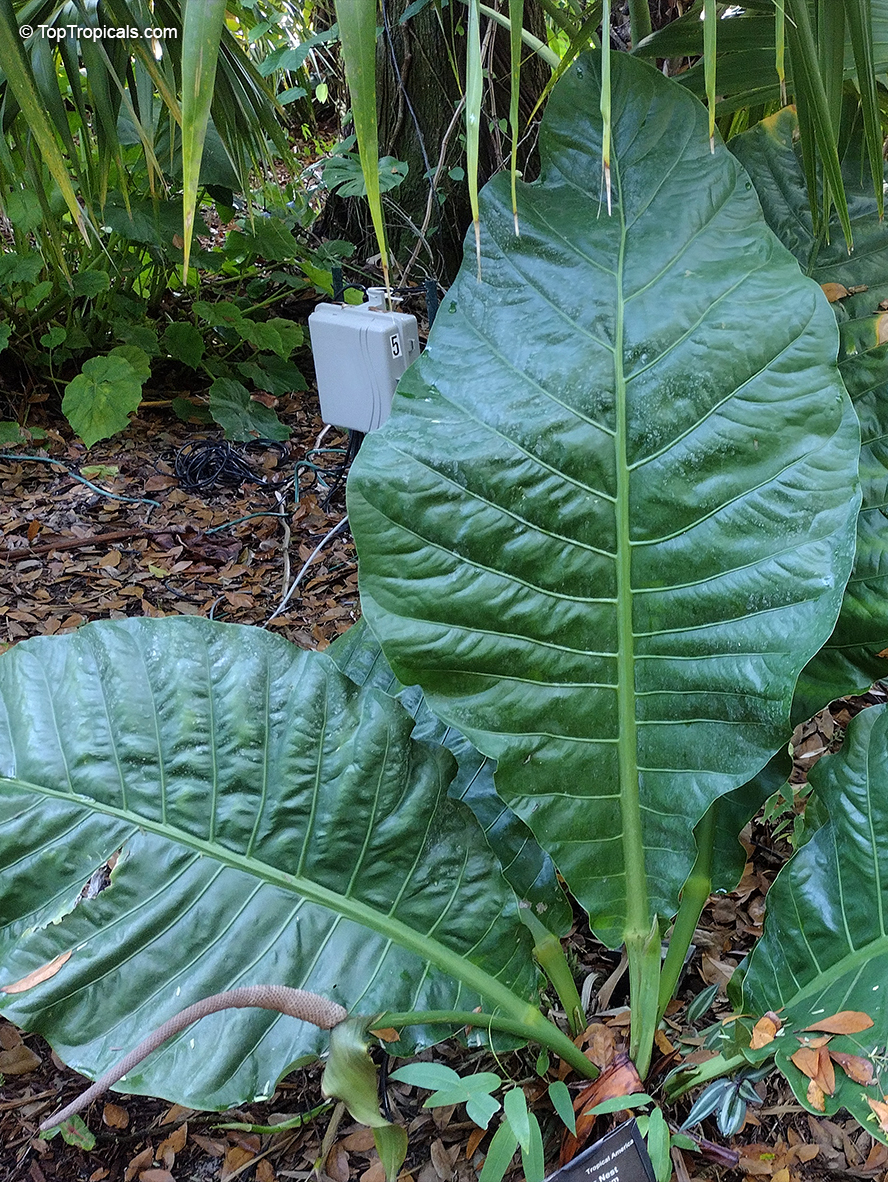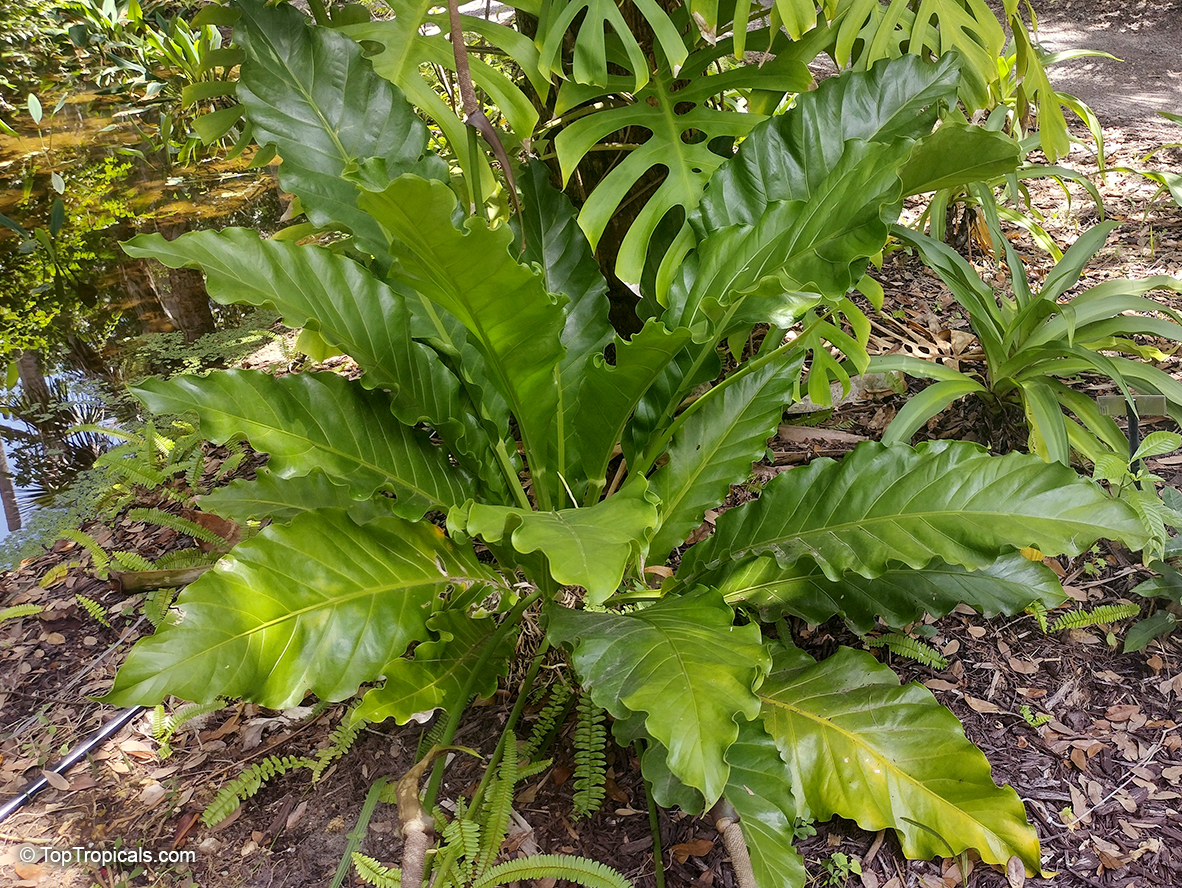Anthurium - Plant Encyclopedia Results
Top Tropicals Plant Encyclopedia
| Number of plants found: 34 | Next | 
|
Go to page: | 1 | 2 | 3 | 4 |
Botanical name: Anthurium andraeanum
Common names: Flamingo Flower, Tail Flower
Family: Araceae
Origin: Ecuador and Colombia









There are hundreds of species of this genus, all members of the Araceae family. The majority are fairly nondescript and a few are grown for their handsome foliage. There are only two species which are generally grown for their flowers, Anthurium andraeanum and Anthurium scherzerianum. Both types are basically epiphytic and grown best in a mix of bark, perlite and fern fiber such as that used in orchids or bromeliads. They will grow in soil but rarely perform well in that medium. Anthurium andraeanum is the florist anthurium, a plant with red, white or pink spatches which have an artificial, plastic-like look. Give a moderately high light intensity but avoid direct sunlight during the spring and summer months when the sun is most intense. A high humidity is essential as is warm temperature, 70-75 days, 65 minimum at night. The potting mixture should be kept moist, but not soggy during the spring- summer period and allowed to dry slightly between waterings from late fall through winter. A feeding of weak manure water and a fish emulsion may be given every two weeks from late winter to mid summer.
Both species have a tendency to grow up out of the pot. The exposed aerial roots should be wrapped in moist sphagnum.
When the plant is eight inches or higher out of the pot it may be cut off at the base and repotted in fresh potting mixture. Plants will occasionally split and form pups. These can be divided when large enough. Plants are also propagated by stem cuttings and seed, both of which are extremely difficult without greenhouse facilities.
Real Hawaiian lava rock is hand selected to provide a happy home for Anthurium. With reasonable care your volcano bonsai should last for years. Place in a bright window or on a countertop without direct sun and just keep a small amount of water in the saucer/tray provided. Requires consistently moist soil.
Botanical names: Anthurium argyrostachyum, Anthurium pandurifolium
Common name: Anthurium
Family: Araceae
Origin: South America




Botanical name: Anthurium bakeri
Common name: Anthurium
Family: Araceae
Origin: Guatemala to Columbia




Epiphyte, stems less than 10cm long, 1.5cm diam.; roots moderately slender; leaf are 1.7cm wide; cataphylls coriaceous, 3-6cm long, acuminate at apex, drying brown, persisting as fibers. Leaves erect to spreading; petioles 11-17 cm long, to 5mm diam., subterete to sharply sulcate; blades narrowly elliptic-lanceolate to narrowly oblanceolate, 19-55cm long, 8-9 cm wide, broadest at middle, acuminate at apex, narrowly rounded at base; upper surface matte, lower surface paler and matte with reddish-brown glandular punctations; midrib convexly raised below.
Erect inflorescence of pale yellow-green spathe with red tinged margins on some clones. Spadix color is white. Berries are red with pointed apex.
This species is one of the most popular.The species is known from Guatemala to Colombia in wetter parts of tropical moist, premontane wet, and tropical wet forest at elevations from sea level to 660 m. In Panama, the species ranges to 1,000 m elevation.
Botanical name: Anthurium clarinervium
Common name: White-Veined Anthurium
Family: Araceae
Origin: Mexico




Anthurium clarinervium is probably endemic to Mexico, known only from areas with limestone outcrops between the Río Grijalva and Río de la Venta, north of Ocozocoautia de Espinosa, Chiapas, at 800 to 1,200 m elevation. A beautiful species of Anthurium grown for it's amazing foliage. Stiff, heart shaped leaves are a deep velvety green with dramatic white veins. Likes low to medium light levels and prefers higher humidity.
Botanical names: Anthurium coriaceum, Pothos coriacea
Common name: Paddle-leaf Anthurium
Family: Araceae
Origin: Brazil




Botanical name: Anthurium crenatum
Common name: Scalloped Laceleaf
Family: Araceae
Origin: Dominican Republic, Puerto Rico







Anthurium crenatum (Scalloped Laceleaf) is a small plant, most often growing 2 to 5 feet tall. It has beautiful scalloped leaves that can reach up to 12 inches in length. The foliage is leathery, pliable, and variations of green. It is popular as a groundcover as well as a low-growing plant, as it generally remains under 2 feet tall.
This epiphyte will thrive in bright shade to semi-shade environments. A moderate amount of water is recommended, as this species does not tolerate drought conditions. When growing this species in colder regions, be sure to keep the plant in a pot and bring indoors for the winter if temperatures dip too low.
Anthurium crenatum is an excellent ornamental plant. Its beautiful foliage and ease of care make it popular in many tropical gardens and as a houseplant. Due to its ornamental foliage, it is also often used as a cut flower. It is hardy in USDA zones 9-11. With proper care, this Anthurium species is a wonderful addition to any collection.
Botanical name: Anthurium crystallinum
Common names: Crystal anthurium, Tail Flower
Family: Araceae
Origin: Panama to Peru





This anthurium has dramatic white or light green veins contrasting with dark green foliage. Flower spathes are light green with a reddish tinge. Likes partial shade or light shade. In winter, temperatures of not less than 65 degrees Fahrenheit are preferred. Likes a warm and humid atmosphere, so misting is beneficial. Reduce watering in the winter.
Botanical name: Anthurium gracile
Common name: Red Pearls Anthurium
Family: Araceae
Origin: Colombia





An attractive species with slender leaves and a graceful semi-pendant spike of vivid red berries. Slender, deep green leather leaves form a loose upright rosette about 18in tall. An interesting species that in nature has a close relationship with ants. According to Benzing, the seeds resemble the pupae of ants, and are collected by arboreal ant species and placed in the nest where they germinate. Self pollinating, and fruits regularly. Beautiful strings of red seeds hang from the plant most of the year. Grows in shade.
Botanical names: Anthurium guayanum, Anthurium bonplandii subsp. guayanum
Common name: Anthurium
Family: Araceae
Origin: Tropical America





This tropical small plant reaches up to 2-5 feet tall and is known for its unusually colored foliage. The mature plants are cold hardy at least to 30s F for a short time. They thrive in semi-shade and need a moderate but regular water supply.
The Anthurium guayanum is grown in USDA Zone 10-11 and requires a humid environment. The plant should be kept in a warm, humid room, between 60- 80°F. A humidifier can help in dry environments. However, for the best growth, the plant should be in an area that receives bright and indirect light with no direct sun. The soil should be kept moist with regular waterings, and it is important not to let it dry out too much.
For potting in a cold region, you can use a high quality potting mix and ensure there is good drainage. During colder months, you can move the pot indoors to a warm and humid area and position it in a bright spot such as a window too. This will help it survive the cold temperatures, while providing adequate lighting and water. It is best to avoid waterlogging and cold drafts. When the temperatures are warmer, move the pot outdoors to a patio or deck in a semi-shade location.
The Anthurium guayanum is perfect for adding a unique and ornamental foliage to any garden. This plant is sure to be a conversation starter and will make a dramatic statement with its unusual color and birds nest shape.
Botanical name: Anthurium hookeri
Common name: Bird's Nest Anthurium
Family: Araceae
Origin: Ecuador, Colombia








For those that love jungly plants. Their enormous wrinkly leaves have an almost cardboard like texture and grow to about 2ft. Used in places that have good natural light and lots of space and could benefit from a little bit of drama... In the wild it is epiphytic or epilithic (meaning that it grows without soil either on trees, or in the rocks. Do not plant too deeply, keep moist but not soaked. Beware of slugs and snails, eliminate them with bait or pick them up at night. Wash the foliage regularly to control mites. Mulch abundantly, and fertilize monthly.
The true species produces white berries while the hybrid plant produces red berries.
Anthurium x hookeri, known as the Giant Bird's Nest Anthurium, is a true jungle statement piece. With massive, wrinkled leaves that can reach up to 7 feet long and a unique cardboard-like texture, this plant adds bold tropical character to any space. Bright red berries enhance its dramatic appeal, while its low-maintenance nature makes it easy to grow. It thrives in bright, indirect light but also tolerates shade, making it ideal for both indoor and outdoor settings. A natural air purifier and conversation starter, this giant beauty brings instant lush, green vibes to your home or garden.
Learn more about Giant Birds Nest:
Yearning for Jungle Vibes? Discover the Giant Birds Nest Anthurium - look at the size of this monster!
Recommended Fertilizer: SUNSHINE Robusta - Rapid Growth Booster
| Next |  |
Use link to repeat this search:
https://toptropicals.com/cgi-bin/garden_catalog/cat.cgi?find=Anthurium&search_op=and&keyword_op=and&language=e&number=10
&no_change_lang=1&user=tt&sale=1&first=0
